

What Is a Call to Action in Writing?

Written by Rebecca Turley

How do you inspire readers to take action?
A Call to Action (CTA) in writing is your opportunity to motivate readers to take some type of action. Can your writing and accompanying CTA be compelling enough to motivate your readers to take the next step, make the next move?
That’s the million-dollar question.
Call to Action: What It Is, What It Isn’t, and How to Successfully Use It in Your Writing
So, what exactly is a Call to Action and how can you best utilize it as a writer?
A CTA in writing is a clear and direct message that should elicit a strong response from readers to do something . In marketing lingo, this something is called a “conversion” – turning observers into doers.
Think of it as a “hook, line, and sinker” moment – you want to inspire the reader to do what you want them to do. Maybe it’s subscribe to your online newsletter, book a service, or buy a product—a CTA is a one-liner that gets the job done. It can be an outstanding marketing tool that keeps your reader engaged and ready to act.
It may be a small, two-word phrase or as long as a sentence, but its goal remains the same: to provide your reader with direction on what to do next. You provided them with compelling, interesting text; now’s not the time to leave them hanging! Finish it off with a great CTA and you’ve accomplished your goal.
CTAs are most often used to make a sale by providing a direct path to the product or service you want them to buy. But they can also be helpful for building your customer base and generating leads for future sales. Most CTAs are used as hyperlinks that take the reader where you want them to go, but they can also motivate the reader to make a phone call, download a brochure, or complete a similar activity.

Creating an Effective Call to Action
Once you understand the goal of the CTA, it becomes rather easy to write one yourself. But there are some tried-and-true rules to follow to ensure your CTA is everything it can be.
A CTA is NOT:
- Overly wordy
Start your CTA with a strong action verb .
A CTA doesn’t take time to get to the point. It accomplishes its goal by telling the reader exactly what to do.
Think “authoritative” when choosing your words for a CTA. Those action verbs should inspire and convince the reader to do something, so now’s not the time to underwhelm them. When choosing that action verb, think about how best to direct your reader:
Use words that excite and motivate the reader.
Get them motivated and curious to make the move. Think about persuasive language here, about intriguing your reader to want to know more or make a move. Persuasive language speaks to saving them money, saving them time, or improving their lives in some way:
- Sign up to join the millions of others who are taking steps to save the planet!
- Click here to start saving money today!
- Call today to book your dream vacation!
Create a sense of urgency.
You can create a sense of urgency in a number of ways. Add an adjective, make a promise, or elicit FOMO.
- Order yours today, while supplies last!
- Get free shipping for a limited time!
- Lose weight in just 4 weeks!
- Call today and enjoy 50% off your purchase!
Eliminate wordiness.
You have one opportunity to capture their attention and motivate them to click. Don’t waste it by overloading your CTA with unnecessary words or confusing text. Think straightforward, clear, concise, and to the point.
If you aren’t getting the response you hoped for, switch it up.
You never really know if your CTA is going to be effective unless you give it a whirl. If you aren’t getting the response you hoped for, it never hurts to try another tactic. Remember that CTAs are not a one-size-fits-all approach, so you may need to experiment to find one that works best for your audience.
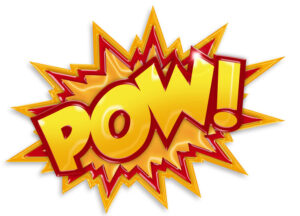
Need a little inspiration to create the perfect CTA? Here are popular CTA phrases designed to boost your conversion efforts.
Do you want customers to sign up or subscribe to something?
- Subscribe now
- Don’t miss out
- Get started now
- Stay up-to-date
- Remain in the know
Do you want customers to keep reading your content?
- Find out more
- Discover more
- Become part of our community
Do you want customers to take advantage of a deal or discount?
- Claim your offer
- Claim your discount
- Redeem your discount
- Start your free trial now
- Start shopping now
- Claim our limited time offer
Adding a Secondary Call to Action: Another Tool in the Writer’s Toolkit

A secondary CTA is not simply reciting the primary CTA twice or rewording the primary CTA. It serves as another option for the reader.
Here’s a good example:
Primary CTA: Donate now to help save endangered white rhinos!
Secondary CTA: Sign up for our weekly e-newsletter to stay up-to-date on conservation efforts for the endangered white rhino.
The primary CTA is a great example of providing the reader with an immediate opportunity to act. But not all readers may be ready to pull out their wallets and make a donation. That’s there the secondary CTA comes in. You’ve captured the interest of the reader enough to inspire them to sign up for your weekly e-newsletter, which could translate into a donation somewhere down the road. Secondary CTAs provide the reader with another opportunity to take action, thereby allowing you to boost your conversion rate.
The secondary CTA should be featured less prominently than the primary CTA because you ultimately want the reader to click on the primary CTA. Remember: The primary CTA should be the most desired action you want your reader to take. A secondary CTA shouldn’t compete with the primary CTA; it should complement it.
But the secondary CTA is certainly an excellent option for those who don’t find the primary CTA appealing. The secondary CTA captures that reader who may have moved on from your website or blog without taking any action at all (i.e., lost conversions). By keeping your reader engaged and returning to your site with the secondary CTA, you’re naturally increasing your chances of enticing the reader to act on the primary CTA in the future.
Secondary CTAs may also be used to simply grow your social reach. A great example of a secondary CTA in this case is to simply encourage the reader to follow you on Twitter, Facebook, or LinkedIn. You can also encourage the reader to share your article or blog on their social media platform of choice. Either way, it’s a great way to boost your social media presence.
- Conversion Optimization
- Growth Marketing
- Digital Analytics
- Brand Marketing
- Digital Marketing
- Digital Psychology
- Ecommerce Marketing
- Product Marketing
- Technical Content Marketing
- Technical Marketing
- Google Analytics 4
- Browse all courses
- CXL Features
- Bottom-of-funnel SEO strategies in tough niches
- Growing AppSumo to 80m with performance marketing
- Account based marketing
- Building a growth process
- Building an innovative product
- Growth mindset: growth vs traditional marketing
- GrowthMaster Training Workshop
- Marketing strategy
- Optimizing Your Growth Process
- Partner Marketing
- Project Management for Marketers
- Retention: the most underrated growth channel
- User-centric marketing
- Data-driven influencer marketing
- Messaging strategy in public relations
- Sales Copywriting & Product Messaging
- Content marketing research
- Content recycling
- Email Marketing: Fundamentals
- Organic Social Media
- Product Marketing Content
- Scaling Content Marketing
- Content strategy and SEO for lead generation
- Growth Focused SEO testing
- SEO Link Building
- SEO-Driven Editorial Calendar
- Technical SEO
- Advanced Facebook Ads
- Advanced LinkedIn Ads
- Facebook Ads Creative
- Facebook Ads Experimentation
- Facebook Ads for Beginners
- Google Ads Experiments
- Google Ads for Beginners
- Linkedin Experimentation
- GA4 Intermediate
- Google Analytics 4 for beginners
- Preparing for Your GA4 Implementation
- Special Topics in GTM for GA4
- Attribution
- Data presentation and visualization
- Excel and Sheets for marketers
- Transactional data analysis
- Advanced Google Tag Manager
- Google Tag Manager for Beginners
- The Measurement Matrix
- Advanced Experimentation Masterclass
- CRO Agency masterclass
- Experimentation program management
- Intro to CRO and Experimentation
- Heuristic Analysis frameworks for conversion optimization audits
- Strategic Research for Experimentation
- Voice of Customer data
- A/B testing foundations
- A/B testing mastery
- CRO for Ecommerce Growth
- Good Practices
- Statistics for A/B testing
- Statistics fundamentals for testing
- Testing Strategies
- Applied neuromarketing
- Digital psychology & behavioral design
- Intro to Neuromarketing
- Landing Page Optimization
- People & psychology
- Personalizing for conversion
- Brand strategy
- Positioning
- Radical differentiation
- Integrated Public Relations and SEO
- Storytelling
- Audience building
- Community building
- Community strategy
- Brand tracking 101
- Brand tracking with Momentive
- User research
- Customer storytelling and proof
- Segmentation and Persona Research
- Building a marketing agency
- Managing a remote marketing team
- Marketing Management
- Sales and customer success enablement
- Automation with Apps script
- Data collection on the web
- Data extraction
- Mobile Analytics
- Tag managers
- Python for marketers
- R for marketers
- SQL for marketers
- API Applications
- Cloud computing concepts
- Cloud services
- Intermediate statistics
- Machine learning applications
- Machine learning fundamentals
- Attention Basics
- Decision Making and Emotions
- Learning and Memory
- Building Habits and Loyalty
- Building Trust
- Cognitive Biases
- Nonconscious Motivation
- Principles of Persuasive Design
- Facebook Ads for ecommerce
- Google Ads for Ecommerce
- Google Shopping
- Selling on Amazon: Perfecting Traffic and Conversions
- Ecommerce Content Marketing
- Ecommerce SEO
- Email and SMS Marketing for Ecommerce
- Customer experience for ecommerce
- Customer journey for ecommerce
- Customer segmentation for ecommerce
- Retention and Customer Lifetime Value
- Ecommerce brand strategy
- Ecommerce merchandising
- Personalization for ecommerce
- Promotional events
- Selling on Marketplaces
- Ecommerce data and metrics
- Ecommerce forecasting
- Ecommerce tech stack
- Unit economics for ecommerce
- Competitive intel & market research
- Introduction to product marketing
- Positioning and company storytelling
- Pricing and packaging
- Product Analytics
- Analyst relations
- Product launches
- Hiring product marketers
- Working with the product team
- What is included in All-access
- What's coming at CXL
- First time here? See all resources
- Original research studies
- AB test calculator
- Conversion rate optimization guide
- Conversion optimization guide
- Ecommerce best practices
- Bounce rate guide: The foundations
- Clickthrough rate guide: The foundations
- Follow our B2B strategy podcast
- Sign up now
Call To Action In Writing: 7 Powerful Examples

Careful attention to CTA (call to action) copywriting is the difference between brands that drive conversions and those that only drive traffic.
Brands that slap a “Buy Now” button on a page and call it a day wonder why their campaigns fail to convert. Companies that engage in strategic CTA testing continue to drive success metrics like CTR (click-through rate) up and to the right.
CTA testing is paramount because it’s not always obvious what needs to happen for your business. Landing page platform Unbounce boosted conversion rates by 90% by changing their CTA copy from “Start your 30-day trial” to “Start my free 30-day trial.”
In this article, we’ll explore seven powerful CTA examples from high-performing companies. You’ll learn what makes them so convincing so that you can apply these lessons in your own CTA writing.
Table of contents
- CTAs drive the buying journey
- Use Voice of Customer research to understand buyer goals
Start with an imperative (command verb)
- Leverage power words to build excitement
- 1. Pipedrive removes barriers to conversion
2. ActiveCampaign makes it clear what customers are signing up for
3. wordable talks results.
- 4. Jasper speaks directly to a common pain point
5. Emma builds intrigue by keeping it concise
6. betterhelp solves three objections in just three words.
- 7. ClickUp backs up its claim with a compelling guarantee
What is a call to action in writing?
Your call to action is the prompt you give readers or users to take a desired action.
That action might be to:
- Download an ebook or guide;
- Sign up for a free trial;
- Register for an upcoming webinar;
- Browse products in your online store;
- Book a sales demonstration.
CTAs are a critical component of marketing material. It’s the point where you tell your reader to do something.
CXL use them on landing pages to invite customers to trial top marketing courses:
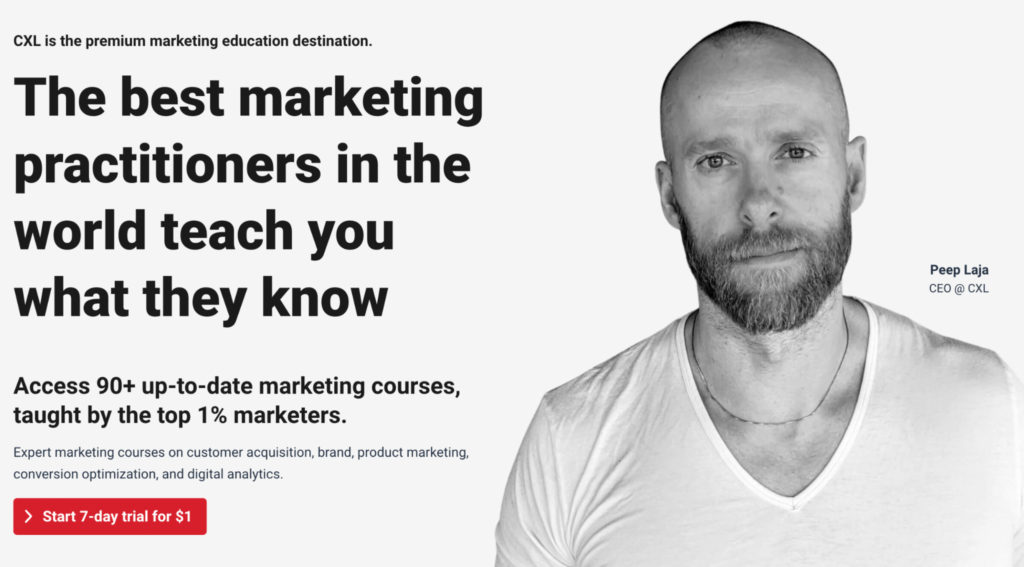
SEO tool Clearscope invites users to join their Director of SEO in a webinar.

And revenue intelligence platform Gong uses CTAs at the end of blog posts to guide readers to additional content they may find valuable:
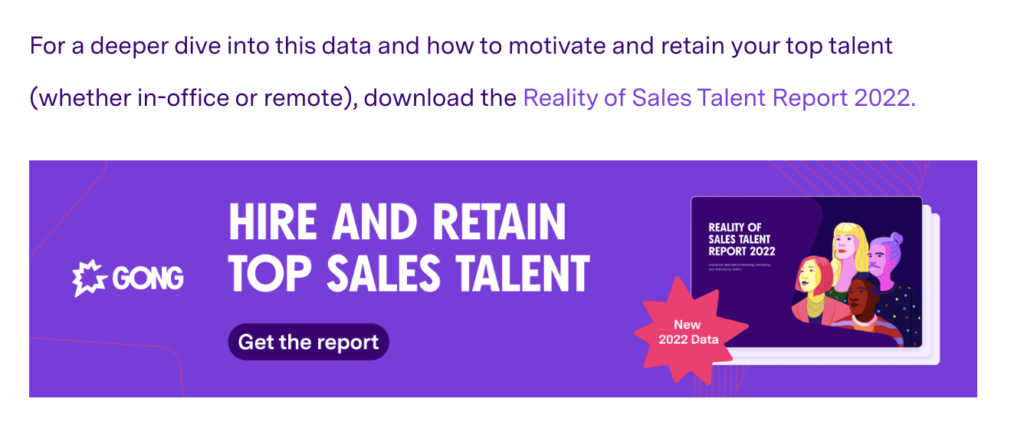
At the most basic level, these CTAs exist to give customers their next step in the buying journey.
CTAs drive the buying journey
A CTA in a brand awareness campaign will look entirely different from a CTA meant to drive sales at the bottom of the funnel.
Take this post from Mailchimp on email marketing benchmarks. Most readers will land on this page after searching for “email marketing benchmarks” on Google.

Mailchimp knows, then, that the user’s search intent is to learn more about the subject of email marketing, not about Mailchimp and its features.
So, the CTA at the bottom of this blog post directs readers to related concepts, several of which are more prescriptive and action-focused than email marketing benchmarks (a powerful way to build value for the customer and to establish your brand as an authority).
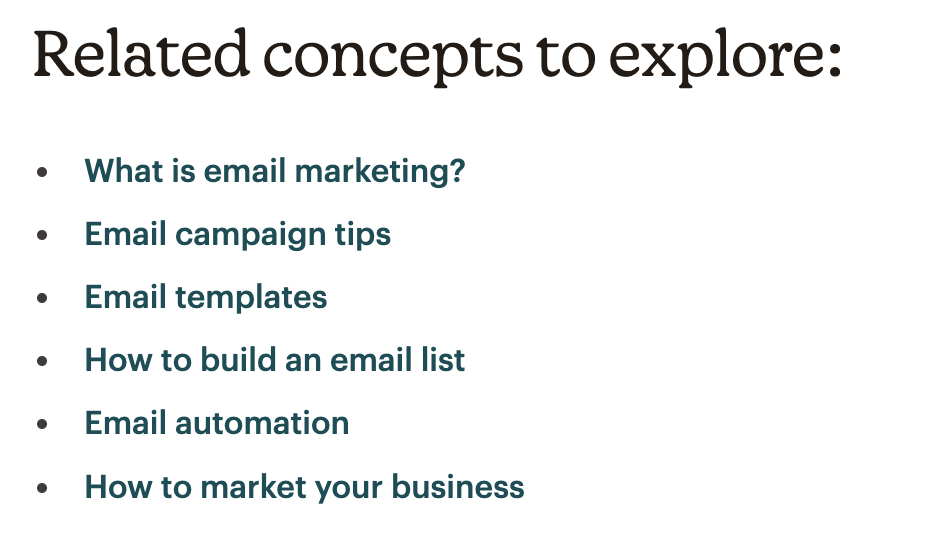
Strong CTAs go beyond “buy now”
The traditional answer as to why CTAs are important is that “customers don’t take action unless they’re told what to do.”
While this is true, it’s not the whole story. A strong call to action doesn’t just provide a path forward but removes any barriers or objections.
Consider the CTA “Sign up now” on a SaaS product landing page. This raises several buyer objections:
- Do I have to pay?
- How much does it cost?
- Am I locked into a contract?
- How long is the contract?
- What payment methods are available?
Effective CTA writing can overcome these objections simply by altering the wording.
Copper uses the copy “Try Free” to preempt and solve these objections.
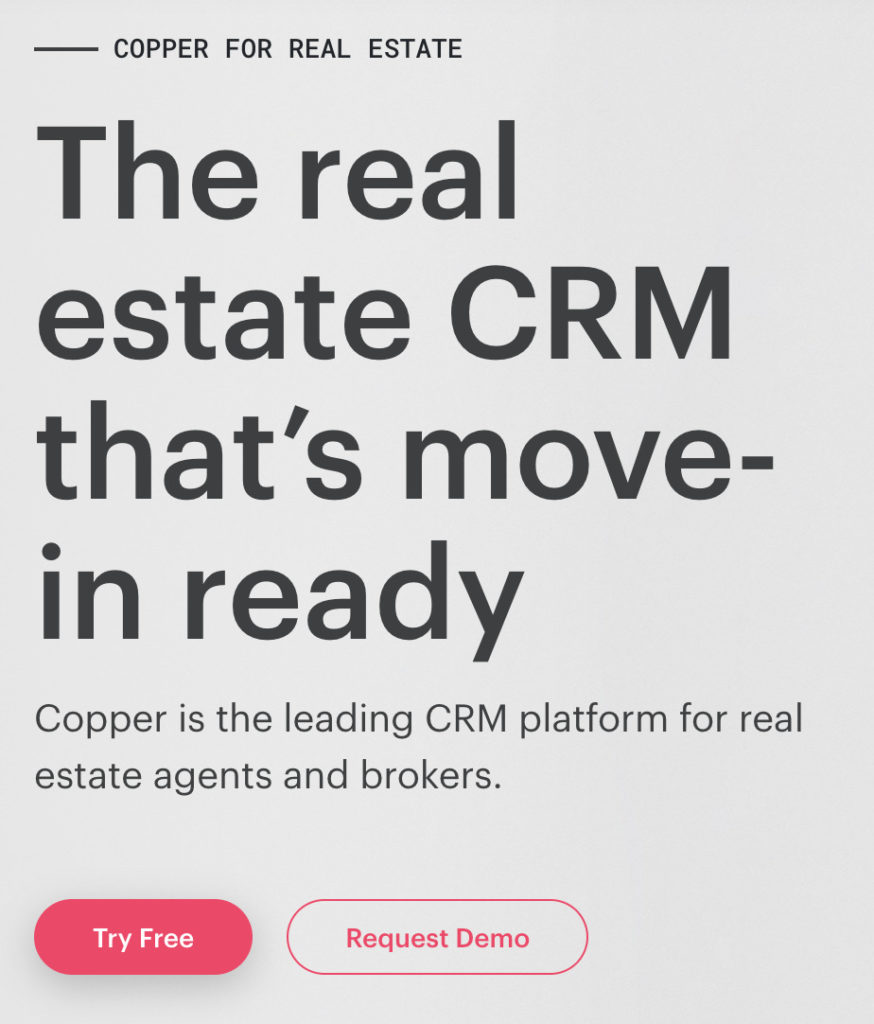
The word “Free” eliminates any concerns about cost, and the addition of the term “Try” implies a trial period, so there is no risk of signing up for a lengthy contract.
How to write a call to action that converts
CTA writing is a form of persuasive writing . Your goal is to convince readers to take a given action in as few words as possible.
A strong understanding of buyer psychology and buyer intelligence will be helpful here. You can also fast-track results with these CTA writing techniques.
Use Voice of Customer research to understand buyer goals
Voice of Customer research uses qualitative and quantitative research to uncover the wants and needs of buyers in their own words.
Then, you’ll use these insights verbatim (or close to) in your marketing material to resonate with customer desires.
This is how Copyhackers wrote Beachway Therapy Center’s landing page to drive 400% more click-throughs on the CTA.
The group mined Amazon addiction book reviews to learn about wants and pains and note memorable phrases.
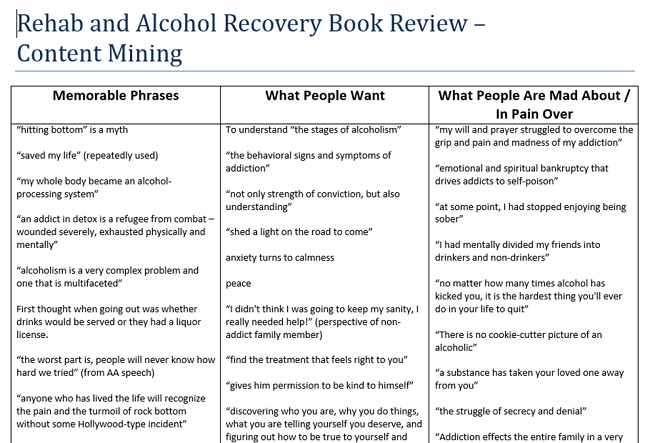
Within those reviews, they caught recurring themes and identified the messaging that resonates with their customer base. The group then applied that copy to the landing page.
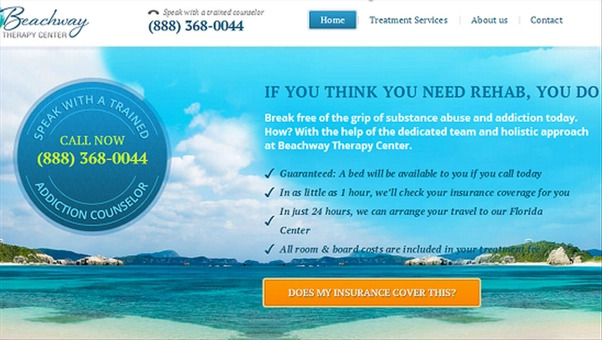
Messaging strategy agency Make Mention learned that the CTA for their client, “Start with the first hour free,” was asking for too much too soon.
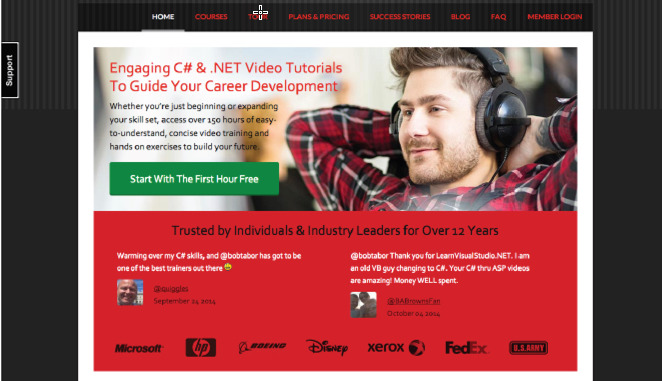
The group conducted online and email surveys and learned that users struggled to understand the course’s value and encountered friction because objections weren’t addressed.
Make Mention redid the page, injecting several phrases from the customers’ vocabulary, including:
- “practical exercises”;
- “getting your first developer job.”
They also directed the CTA button to lead to an alternative page where customers can learn more about the course.

Make Mention helped customers get more information before asking for the sale, and critically, they used the language customers use. This tweak boosted conversions on the CTA button by over 66%, leading to more check-outs from the Curriculum page than the Pricing page.
A good general rule to follow in CTA writing is to always start with an imperative. Imperatives are action words; they tell the reader to do something.
Powerful examples of action phrases include:
- Learn;
SparkToro demonstrates two examples of imperatives in action with their buttons: “Try SparkToro for free” and “See Pricing.”
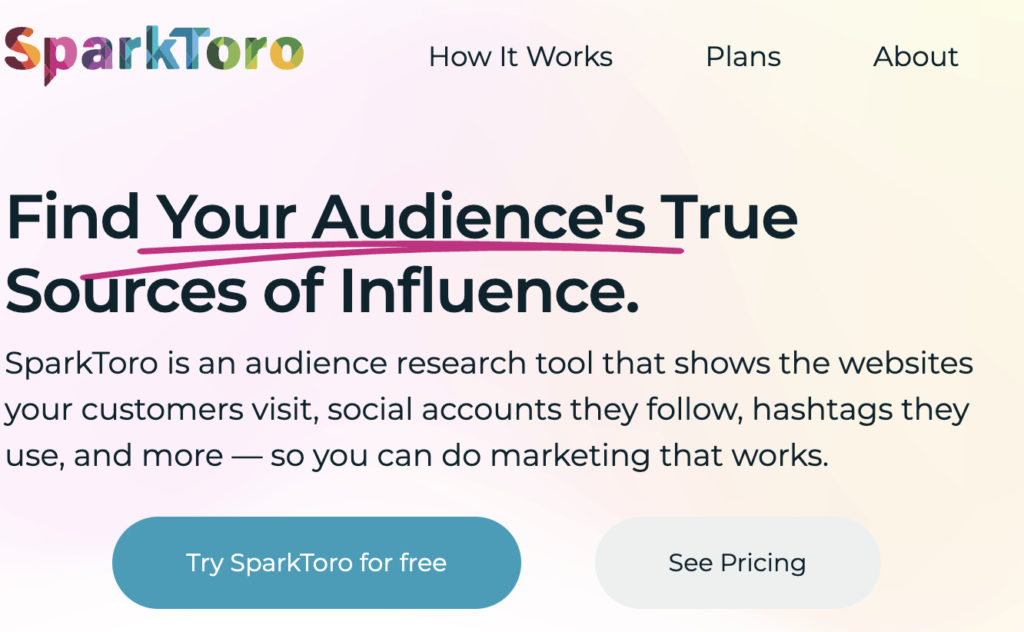
Preempt and eliminate objections
Effective call to action writing preempts objections and eliminates them early.
Take Buzzsumo , which clarifies that new users don’t have to pay a cent for 30 days, obliterating worries about forgetting they’ve started the trial and purchasing accidentally.

The most common objections you’ll face are:
- Cost (Is there one? And if so, how much?);
- Time (How long is this going to take?);
- Commitment (Am I locked into anything?).
For cost objections, use terms like “free” and “no credit card required” to clarify that there is no cost involved.
For time objections, phrases like “instantly,” “in 2 minutes,” and “now” communicate that the action will take place quickly.
Solve commitment objections by clearly outlining the trial length (“Try free for 14 days”) or with terms like “free forever” and “no credit card.”
Leverage power words to build excitement
Command words tell readers what to do. Power words make them feel excited about doing it. Combining the two is what motivates users to take action.
Examples of convincing power words to use in your CTA writing include:
- Classified;
- Minimalist;
- Irresistible;
- Effortless.
For example, GAP uses the term “unique” to encourage users to sign up for their mailing list (in exchange for a 25% discount).
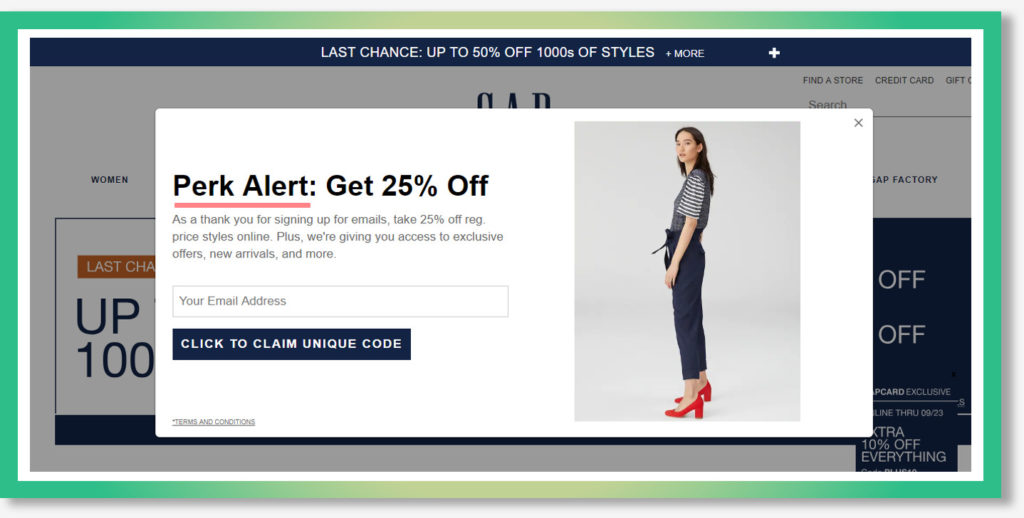
Create a sense of urgency to inspire immediate action
Great call to action writing inspires readers to take action now . When done well, they create buyer FOMO (fear of missing out), motivating website visitors to act immediately.
Words like “now,” “instantly,” “limited time,” and “today” are a good starting point but are best supplemented with urgent imperatives like “seize,” “gain,” and “access.”
Youprenuer combines the imperative “Get” with the urgency-building power word “Instant” to build a compelling CTA for their email list.
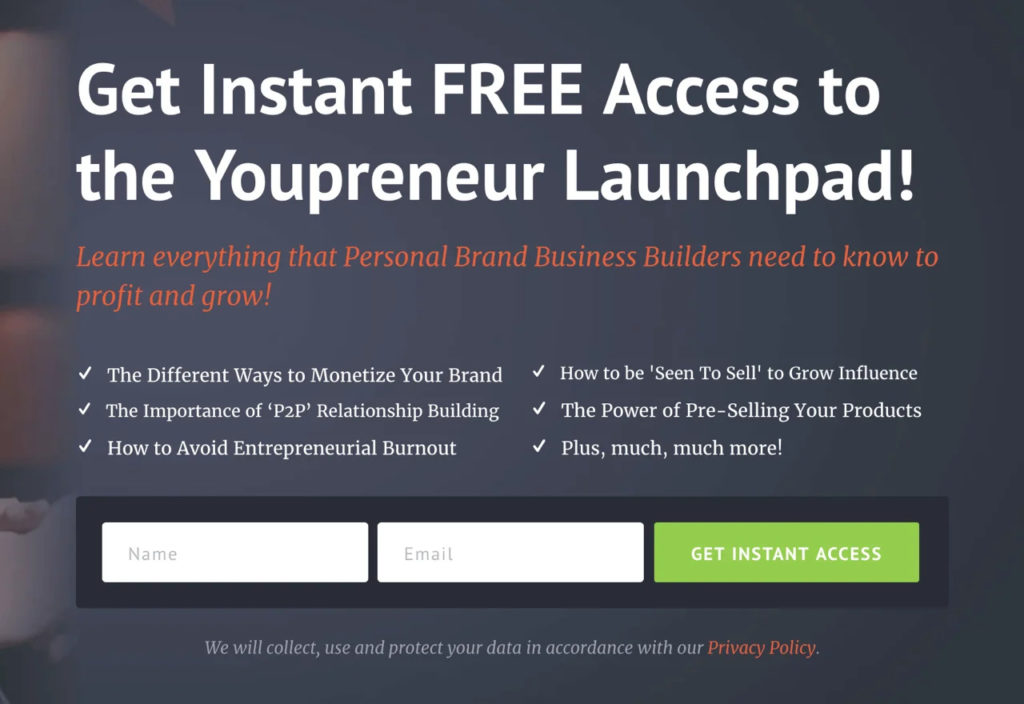
Use mystery to generate curiosity
In certain cases, you’ll want to avoid mystery altogether. For instance, when crafting a CTA designed to motivate readers to sign up for a free trial, we want to clarify what customers are getting into.
But curiosity can work in our favor for downloadable content like ebooks and guides.
Terms like “discover,” “see what’s inside,” and “get the secrets” are powerful curiosity-builders that can help motivate readers to hand over their email addresses in exchange for the promised value.
“Explore” is a great example of a curiosity-building word to include in your CTAs, as demonstrated by premium vodka brand Grey Goose .
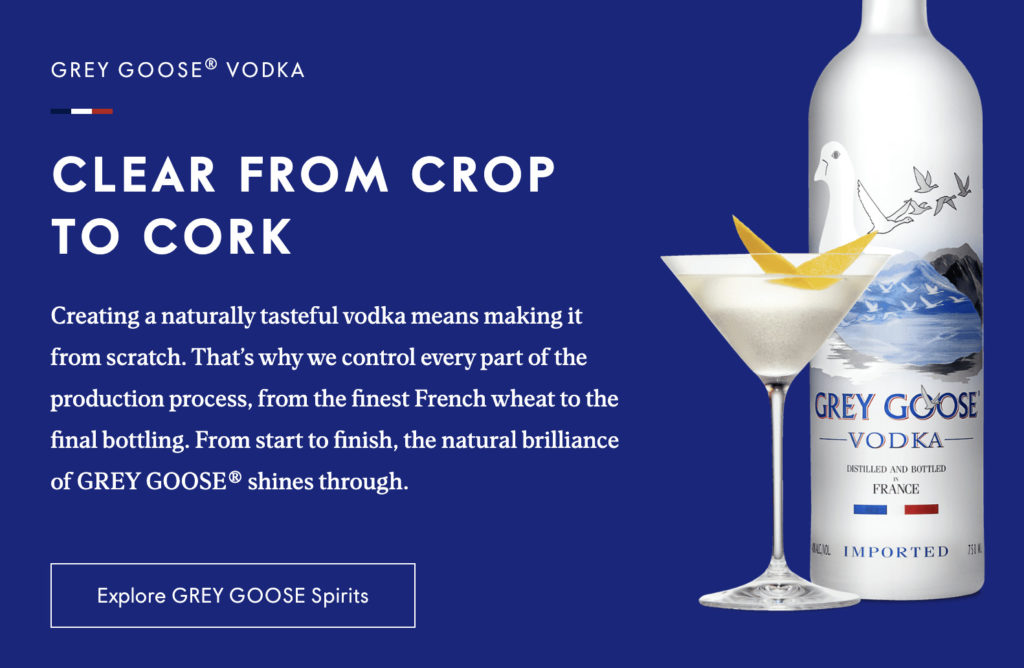
Back up your claims with social proof
CTA copy doesn’t need to sit on its own.
Great CTA writers supplement copy with social proof (testimonials, reviews, logos) to give more gravity to their message and build trust with skeptical buyers.
Juro , for example, supplements their “book a demo” CTA with review ratings from Capterra and G2.

7 impressive calls to action (and why they work so well)
Ultimately, A/B testing and experimentation will help you uncover your purpose’s perfect call to action.
Use these examples as a jumping-off point, and tweak and test as appropriate.
1. Pipedrive removes barriers to conversion
One of the biggest factors preventing readers from converting is the unknown. When faced with a CTA like “Start now,” customers wonder internally:
- What’s involved in starting?
- Do I need to get my credit card out?
- What exactly am I committing to?
You can solve these objections before they arise with careful copywriting.
Pipedrive’s homepage CTA section is a powerful example of this.

The green “Start free” call to action button immediately tells readers there’s no cost involved. The supplementary “No credit card required” copy below also helps users overcome this objection.
The addition of the simple “Full access” answers the question, “But am I just signing up to a limited version, and will I need to pay to access more sophisticated features?”
Lastly, Pipedrive does a great job of communicating why readers should click that CTA button (because Pipedrive users close 28% more deals after their first year using the CRM).
Takeaways from Pipedrive’s CTA example:
- Incorporate terms like “free” and “no credit card” to solve cost objections;
- Make it clear to users what they’re signing up for (e.g., full platform access);
- Use compelling social proof to communicate the why (answer the question, “What’s in it for me?”.
Average CTA writing leaves readers guessing:
- What am I signing up for exactly?
- What happens next?
- What if I don’t like what I see?
- Am I going to get hounded by a sales rep?
Strong CTA writing makes a reader’s next steps abundantly clear.
Take ActiveCampaign .
The exit popup on their email marketing product page aims to capture a reader’s interest (and email address) before they leave ActiveCampaign’s site.
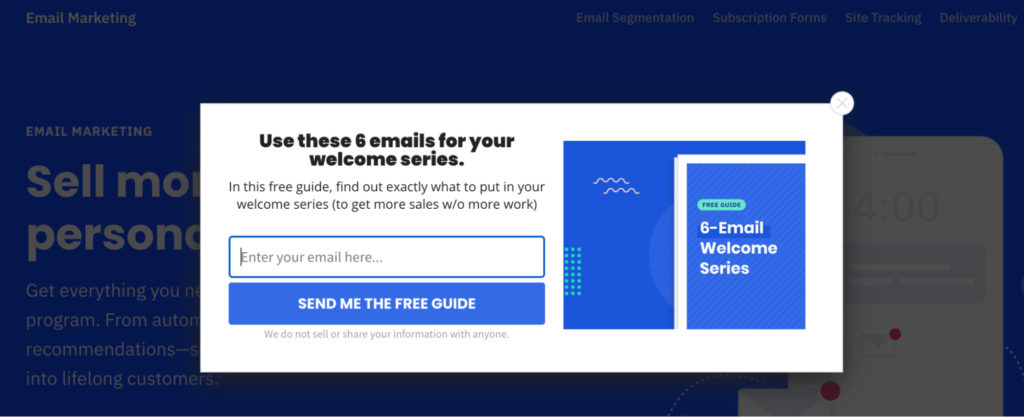
A simple “Download our guide” wouldn’t be sufficient. Those who leave a landing page without clicking an in-page CTA are clearly unconvinced, so any copy in an exit popup must be especially persuasive.
ActiveCampaign nails this in their header copy.
“Use these 6 emails for your welcome series” tells readers precisely what they’ll receive.
The use of the term “free” in the body copy eliminates cost objections, and the addition of the bracketed “to get more sales w/o more work” puts the offer in the context of the result, answering the reader’s question, “What’s in it for me?”
“Send me the free guide” (the copy in the CTA itself) is reader-focused (written in first person) and reiterates that there’s nothing to lose as the guide is free.
Lastly, the copy below the CTA button (“We do not sell or share your information with anyone”) works to convince even the most skeptical reader that they’re signing up for a safe offer.
Takeaways from ActiveCampaign’s CTA example:
- Make it abundantly clear what readers are going to receive;
- Solves the cost objection by doubling down on terms like “free”;
- Put your offer in the context of results (answer “What’s in it for me?”);
- Assure readers that their personal information will remain anonymous and won’t be sold or shared.
Vague, convoluted statements (“Helping ambitious creators design better futures”) don’t convert.
Concise, solution-focused calls to action that speak directly to outcomes (in your customers’ language) do.
Take Wordable , a platform that connects Google Docs with WordPress, HubSpot, and Medium, allowing high-volume content producers to publish to their blog in seconds.

Wordable doesn’t waste time telling readers how they’ll “Streamline and transform their content operations processes.” Instead, they jump straight to results:
- Publish in just one click;
- Export in seconds rather than hours;
- Cut back on VA or employee costs;
- Save as much as 100 hours per week in publishing time.
Then, Wordable delivers a persuasive offer, five free exports (notice the imperative “Get” kicking off the CTA copy), and eliminates any commitment objections by including the phrase “No credit card required.”
Prospects who read this CTA (and accompanying copy) aren’t left wondering what Wordable can do for them. They know exactly what problem it will solve and the results they can expect from hitting that CTA button.
Takeaways from Wordable’s CTA example:
- Speak your customers’ language (and avoid convoluted, vague, jargon-filled copy);
- Get straight to the results (What outcomes can your customer expect?);
- Back up “free” usage claims and solve commitment objectives by not requiring a credit card.
4. Jasper speaks directly to a common pain point
Though actual figures are hard to come by, marketers estimate that the average consumer sees between 4,000 and 10,000 ads per day .
Unsurprisingly, users see a large chunk of these ads ( 33% ) on social media platforms.
If you’re going to stand out from the other 3000+ ads your audience sees on these sites, you need to connect directly with their most critical challenges.
Take Jasper , an AI copywriting assistant.
Jasper’s Facebook ad speaks directly to a target audience pain point: content marketing is a time-consuming, labor-intensive process.
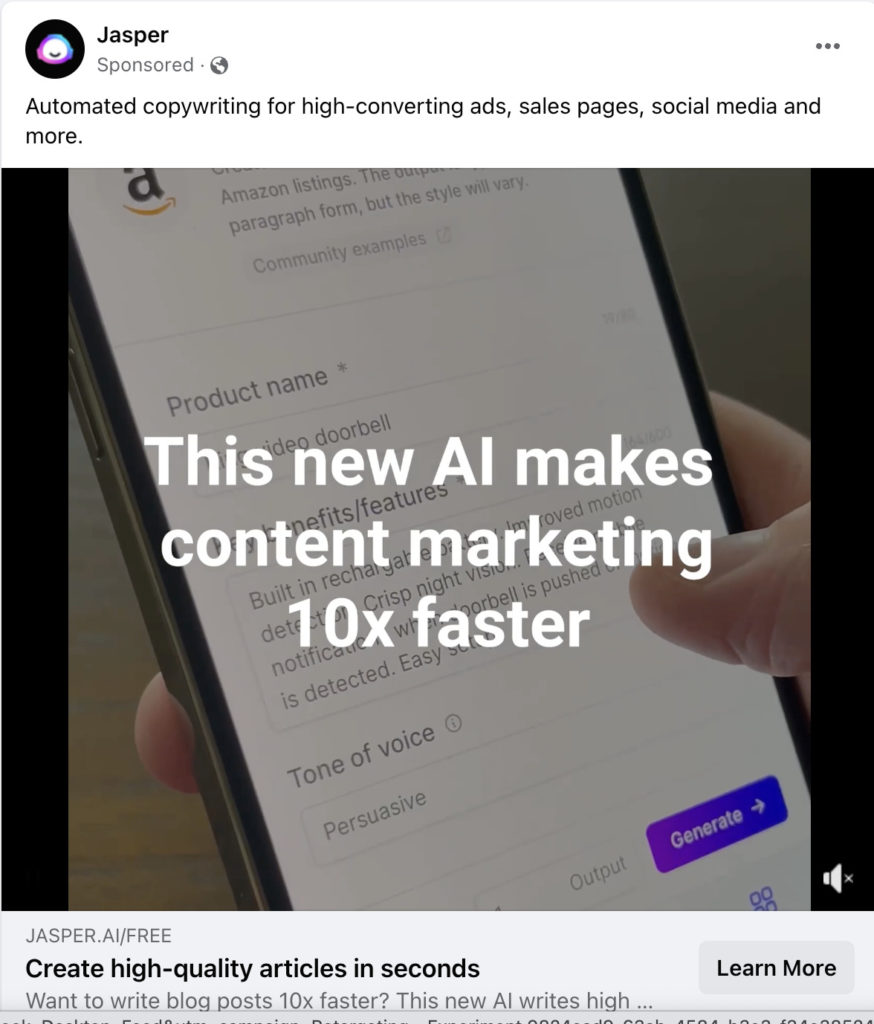
The video used in this digital ad is effective in and of itself (it shows the product in action, overlaid with a simple message “Write 10x faster”), but the copy below is what makes this a good CTA example:
“Create high-quality articles in seconds.”
First, Jasper begins with the action verb “create” before describing the desired outcome (high-quality articles) and the compelling benefit of their product (in seconds).
In just six words, Jasper communicates how its platform solves a common challenge for ecommerce site owners, social media managers, and digital marketing professionals.
Takeaways from Jasper’s CTA example:
- Identify a pain point that resonates with potential customers;
- Communicate how you’ll solve that pain point (i.e., your value proposition);
- Describe this benefit concisely, putting the reader as the subject.
Often, the best call-to-action examples are those that are concise. This is an especially powerful technique when writing CTAs designed to promote downloadable content such as guides, ebooks, and checklists, as it can double as an intrigue-builder.
Take email marketing platform Emma , whose simple CTA “See How” is a compelling example of how much you can achieve with just two words.

Of course, this CTA is only effective in the context of what you’ve said before:
- Your email marketing campaigns can be better (probably);
- We’re going to give you a framework for improving them.
This is an intriguing proposition (readers are asking, “Can I get more from my existing email list?”).
The call to action “See How” builds on this intrigue, inviting readers to click through and answer the question themselves.
Takeaways from Emma’s CTA example:
- Introduce a common problem;
- Imply that you’ll help readers solve it;
- Keep your CTA copy short and sweet to leverage that curiosity.
Skilled CTA writers understand how readers will respond to an offer and what objections or roadblocks will appear to prevent conversion.
Then, they address these objections directly in their copy.
Take BetterHelp , an online therapy platform that uses social media advertising in its demand generation strategy .

The intention of the above ad isn’t to convert readers into paid subscribers. It’s simply to convince ad viewers to click through to BetterHelp’s website and learn more about their product.
But, BetterHelp knows that while this is a low-commitment ask, prospective customers will have many concerns:
- What will others think if they find out I’m using online therapy?
- I’m busy. I don’t think it will fit around my schedule.
- Isn’t therapy usually super expensive?
BetterHelp solves all three objections using just three words:
- Discreet (Nobody will even know I’m using BetterHelp).
- Convenient (Therapy appointments are flexible).
- Affordable (BetterHelp is more cost-effective than traditional therapy solutions).
In this example, these three words supplement the actual call to action copy, “Online Therapy on Your Schedule,” reiterating that BetterHelp’s therapists are flexible about appointment times.
Takeaways from BetterHelp’s CTA example:
- Put yourself in the reader’s shoes: What concerns might they have that could prevent them from converting?
- Ask: What can we communicate that would quell these concerns?
- Test: What’s the best word (or phrase) to communicate that with as few words as possible?
7. ClickUp backs up its claim with a compelling guarantee
Convincing calls to action often make impressive claims.
But today’s consumers aren’t easily convinced, so if you make bold claims, be prepared to back them up.
Take ClickUp , which guarantees new users will save one day every week.
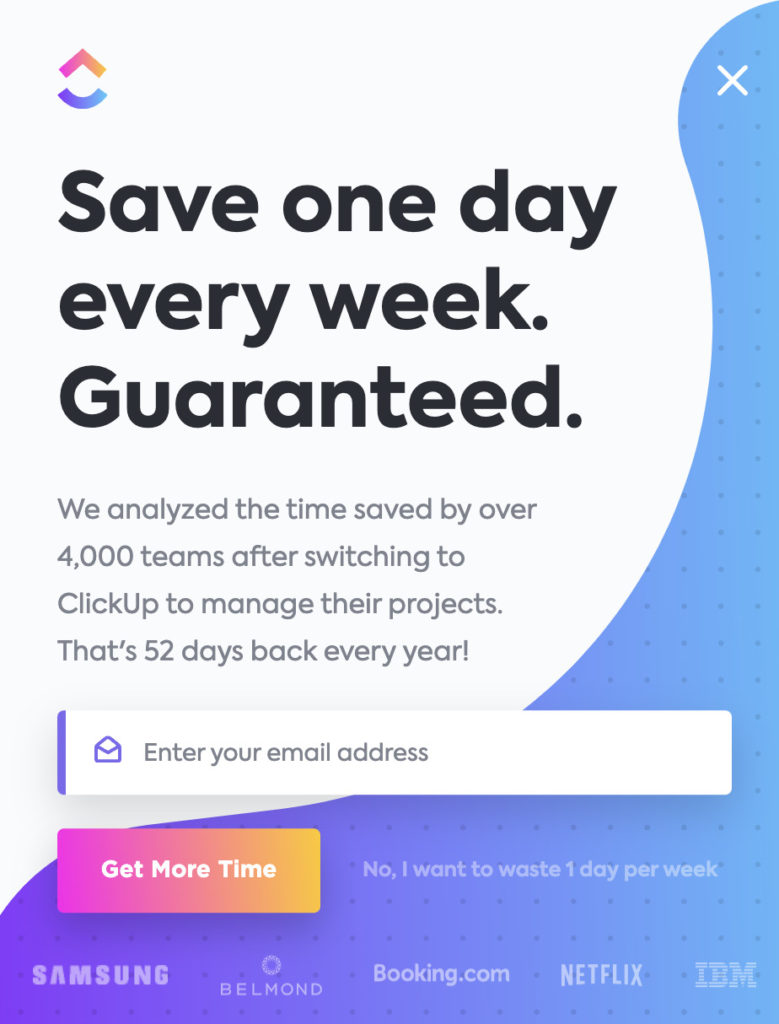
That’s a big promise, but ClickUp backs it up by providing context to their claim (we analyzed over 4,000 teams) and supplementing the popup ad with several impressive logos (Samsung, Netflix, IBM.)
But the real winner here is ClickUp’s CTA copy.
“Get More Time” is all about the result. It’s not about what ClickUp wants (“Sign up today”). It’s about what the customer needs .
Takeaways from ClickUp’s CTA example:
- If you’re going to make a bold claim, be prepared to back it up;
- Use customer logos as social proof to back up such statements;
- Frame your CTA copy from the customer’s perspective, not yours.
These call-to-action examples are a solid starting point for designing high-performing CTAs that resonate with your own audience. What works for these brands may not work for yours, so it’s always better to hypothesize and test.
CTAs that convert at high rates come from strategic experimentation. This is the only way to determine whether the word “Get” performs better than “Sign up” or “Access” for a given call to action. And it’s one of the best ways to see real business growth . Check out our A/B testing tutorial today, and become a CTA testing pro.
Related Posts

Should you say 'read more' or 'product information' in your product category view? Which is…
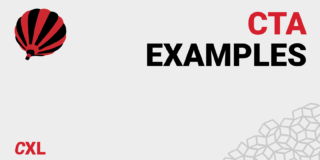
The call to action is a core component of marketing, sales, and any persuasion-based effort.…
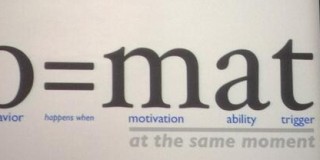
In today's review I'm assessing whether websites in question could do anything to better get…

Planning to create a promo video to increase conversions? Good idea. Table of contents1. Dollar…

Josh Krissansen
Josh is a Content Specialist at Grizzle, a content marketing & SEO agency, and a freelance content writer for B2B clients in the SaaS space.
Current article:
Search posts.
- Acquisition (190)
- Audio posts (5)
- Business Building (114)
- Copywriting (43)
- CRO & Testing (316)
- Customer Stories (7)
- Digital Analytics (67)
- Google Analytics (26)
- Marketing Tactics (50)
- Original Research (15)
- Psychology (88)
- Social Media (23)
- The Pe:p Show (49)
- User Experience & Persuasive Design (180)
Being the best is achieved through consistency
Join 130,000+ growth marketers, optimizers, analysts, and UX practitioners and get a weekly email that keeps you informed.
- Your business e-mail *
- I agree to receive updates from CXL.
- Comments This field is for validation purposes and should be left unchanged.
How To Write a Call to Action That Works [Tips + 6 Examples]
Ready for your marketing campaigns to actually drive results? We’ll show you how to motivate your audience with a killer call to action.

Table of Contents
You know how they say a closed mouth doesn’t get fed? If you want someone to do something, you gotta ask for it. Writing a killer call to action (CTA) is one strategy to get what you want.
Whether you’re trying to get people to buy your products, sign up for your emails, or join your cult, crafting the perfect call to action is essential for success.
But how do you write a call to action that stands out from the crowd and actually drives results? In this blog post, we’ll show you how to motivate with some powerful examples of moving calls to action and tips on writing them yourself.
Bonus: Download a free guide to social advertising and learn the 5 steps to building effective campaigns. No tricks or boring tips—just simple, easy-to-follow instructions that really work.
What is a call to action?
A call to action is a word or phrase that prompts action. It is a marketing term to describe urging your audience to act in a certain way.
A call to action can appear as a clickable button or simply as a piece of text. Call-to-action buttons and phrases can appear at any place in the user journey that you want to direct your audience.
Let’s say you’re trying to sell a pair of shoes on Instagram, and you’re crafting clear social media CTAs . You might have a call to action at the end of your social post caption that says, “Click the link in our bio.” The link in your bio could lead to a product page with information about the shoes on it. The call to action on this page would be an “Add to shopping cart” button.
CTAs aren’t just for social media. They can also appear in emails for an email marketing campaign, on paid ads, at the end of a blog post, and on landing pages.
CTAs are common in print marketing, too — think billboards or flyers that scream “Call Now!”
Examples of common CTAs
You’ll see plenty of CTAs around, but there are a few tried and tested phrases on repeat.
These common CTAs are uncomplicated phrases that tell your user exactly what to do and what they can expect once they follow through. There’s power in simplicity, which is why you’ll see these words used over and over again.
Some of the most common CTAs are:
- Try for free
- Add to cart
- Get started
Why is a good CTA important?
A well-crafted call to action serves as a bridge or a well-lit path. It guides your user where you want them to go. Which, if your business plan is in the right place, will be toward your goals.
A strong CTA will grab customers’ attention and incentivize them to take the decisive step necessary to achieve their goals. Effective CTAs give customers confidence in your business. They can communicate security, trustworthiness, and convenience, all of which can increase conversions or drive traffic where you want it to go.
Calls to action can also combat decision fatigue. When someone has too many options, they can become overwhelmed by choice. CTAs can help cut through decision confusion by giving your reader a direct command. Now, go read the best practices for creating effective CTAs.
Best practices for creating effective CTAs
Much like cutting your bangs, there’s a right way and a wrong way to go about creating CTAs. You’ll need to consider things like copywriting, design, visuals, and placement on a webpage.
It might seem like a lot, but we’ve got you covered with the handy best practice list below!
Make it concise and clear
The CTA should be concise and lay out a clear request for the customer, whether that be for them to join a mailing list or purchase a product or service. Don’t write your reader a paragraph with the CTA buried within it; you want them to be able to immediately know where they should go.

Source: Squarespac e
Make it visible
People don’t scour your web page. They don’t read every word, and they certainly don’t like searching for something. If your CTA isn’t immediately obvious, you will lose your viewer’s interest in seconds. Remember, a competitor is likely doing the same thing you are, and your customers are spoilt for choice.
Make your call-to-action buttons or phrases clearly visible on your page. You can tailor your imagery or site design to point to the CTA for added visibility. Take Fashion Nova, for example. Here, the banner model’s body points toward the Shop Now CTA.

Source: Fashion Nova
Use white space
A great way to make sure people can see your CTA is to surround it with white space.
Don’t be scared of white space on your website! It allows your viewers to breathe in between content and can highlight important information.
Surrounding your button CTA with white space makes it pop.

Source: West Elm
Use contrasting or bold colors
Stop signs are red for a reason. They pop out among cityscapes or the countryside because that bright, arresting red isn’t at risk of blending in. Do the same for your CTA button colors.
Keep in mind that you shouldn’t veer away from your brand colors. A secondary brand color can do the job well. (And if you want to know more about brand colors and a consistent style guide , we’ve got you covered.)

Source: McDonald’s
Have well-considered page placement
Where you place your call-to-action buttons matters a great deal. You want to consider the natural flow of your user’s journey. You’ll have some users who immediately want to get shopping or head to the next page, and you’ll have users who want to scroll through your landing page before moving on.
A call to action should be placed under your header and at the bottom of your page. You want to capture people immediately (if they’re willing) and give those who need a bit more time another opportunity to hit that CTA at the bottom.

Source: Squarespace
Write benefit-forward supporting text
Supporting text is the content that comes before or in between your CTAs. It can be blog content, email body copy, the text on your website, or any copy that supports your CTA.
This extra information is your opportunity to show your audience the benefit that befalls them when they click your CTA.

For example, maybe you’re trying to get an audience to sign up for your email newsletter. If you want to convince people to hand over their email addresses, you’ll have to tell them what that newsletter will do for them.
A copywriting newsletter might say something like, “We sift through thousands of copywriting samples and pull only the best for you to repurpose for your own use. Plus, we tell you exactly why they work, so you don’t have to spend time puzzling through strategy. Impress your clients, save time, and look like an expert. Sign up today.”
The supporting copy highlights benefits so the call to action feels extra compelling. The reader knows exactly what to expect when they sign up for the email newsletter and how it will benefit them.
Create thoughtful copywriting
Aside from benefit-forward supporting text, the rest of your copywriting needs to be on point. Everything, from your site headers to your social posts, needs to be in your brand voice and speak directly to your audience.
Don’t forget to pay attention to the language you’re using both in and around your calls to action. Powerful words strike a chord with your audience’s emotions. White-hot CTA copy is an explosive way to skyrocket your ROI. (See what I did there?)
That being said, don’t confuse your audience. While your surrounding text can be full of powerful language, your CTAs need to be clear so your audience knows where they are headed. “Take the Quiz” or “Shop Now” gives your audience everything they need to know about where the button leads.

Source: Qunol
Test, test, and test again
The only way to really know if you’re using the best version of your CTA is to test it. Running A/B tests on your calls to action will show you which strategy performs the best.
It’s a simple method: You change one element (like your copy, placement, or colors) and let it run for a set amount of time. Then, see how it compares to the previous version.
6 great call-to-action examples
Now that you know what to do, it’s time to check out what others are doing! Get inspiration for your next CTA from the examples below.
Oh, how we love a good mystery! Whether it’s a cheesy crime drama or a surprise gift from a company, there’s something about not knowing what you might get that is just so enticing.
Glossier’s “It’s a mystery!” CTA makes us itchy to click that button just to see what’s on the other side.

Source: Glossier
Article uses color to its advantage with the website’s call-to-action buttons. Their secondary brand color is a bright coral, which you can see is used for the “Add to cart” CTA button.
It’s clear, eye-catching, and concise, everything a great CTA button should be.

Source: Article
Coco & Eve
Coco & Eve’s email marketing campaign uses a discount code as a CTA. Who doesn’t love saving money? Incorporating your discount code into your CTA is a clever way to get people to click.

Source: Coco & Eve’s email campaign
While this strategy worked well in Coco & Eve’s email campaign, they ran into CTA limitations on other platforms, like Facebook. If you’re advertising on LinkedIn or Facebook, you’ll know that the apps force you to use a set of standard CTA copy on the buttons.
While this poses some limitations, you can still add supporting text that motivates your audience to click. Below, Coco & Eve included the discount code on the imagery instead, which is just one of many clever ways to go about Facebook advertising .
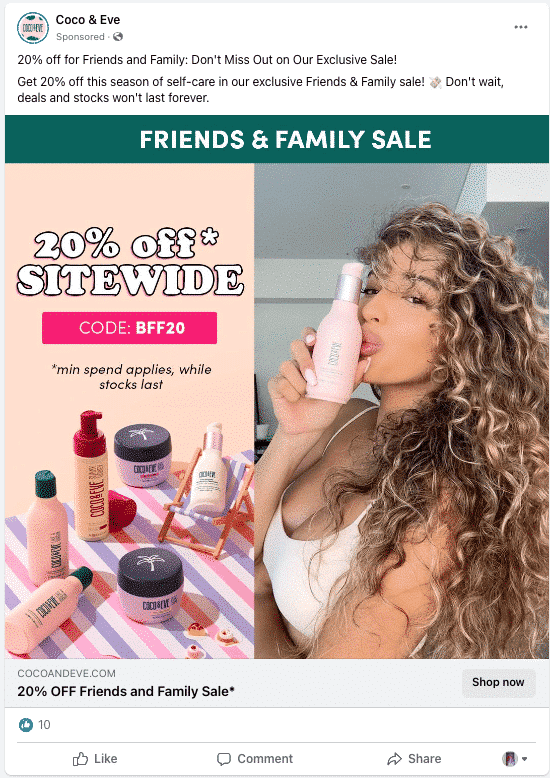
Source: Coco & Eve on Facebook
Twitter’s “Tweet” CTA uses its own brand-specific language. Before the rise of social media, if you had told someone to tweet something, you’d be met with a blank stare. (We’ve come since 2006, truly.)
To do this yourself, just create a globally-used platform that makes birdsong synonymous with snippets of thought. Easy.

Source: Twitter
Tushy uses social proof as supporting text in its Instagram story ad . The “100,000+ 5 Star reviews” statement below serves to motivate others to grab a Tushy. Social proof is one of those marketing tactics that just works. People look to other people to determine what’s hot and what’s not.
Social proof works a lot like the bandwagon effect , a kind of cognitive bias. The bandwagon effect is pretty much exactly like it sounds; when a majority of people like or endorse something, it’s often picked up by others. And, with 100,000 5-star reviews called out, Tushy is using the bandwagon effect to its full advantage below.

Source: Tushy on Instagram
NatGeo dangles a free trial in its Instagram ad, one of many effective call-to-action ideas you can shamelessly steal. Although, when so many people are doing it and finding success, is it really stealing?

Source: NatGeo on Instagram
Save time managing your social media presence with Hootsuite. From a single dashboard you can publish and schedule posts, find relevant conversions, engage the audience, measure results, and more. Try it free today.
Get Started
Do it better with Hootsuite , the all-in-one social media tool. Stay on top of things, grow, and beat the competition.
Become a better social marketer.
Get expert social media advice delivered straight to your inbox.
Colleen Christison is a freelance copywriter, copy editor, and brand communications specialist. She spent the first six years of her career in award-winning agencies like Major Tom, writing for social media and websites and developing branding campaigns. Following her agency career, Colleen built her own writing practice, working with brands like Mission Hill Winery, The Prevail Project, and AntiSocial Media.
Related Articles

How to Write a Great Social Media Call to Action
If you want your audience to do something, you can’t just hope and hint. You need a good social media call to action.

11 Tips to Improve Your Facebook Ad Conversions
Facebook is the number one social media site for driving conversions, which makes creating effective Facebook ads an integral part of your social media strategy. Follow these 11 tips to convert your next Facebook campaign into a success.

17 Social Media Metrics You Need to Track in 2024 [BENCHMARKS]
Pin down the social media metrics that really matter and learn how to track them to build a winning social media presence.

24 Gen Z Statistics That Matter to Marketers in 2024
Craft your next marketing strategy with these Gen Z statistics. Find out who they are, where they are online, and what they want from brands.
5 Steps To Writing an Effective Call to Action (With Examples)

Table of contents

Laura Jane Bradbury
An effective call to action (CTA) encourages content engagement, converts visitors into leads, and helps people discover your business. It should offer value to the reader and explain what to expect from taking action.
If a CTA doesn't have a clear message, feels too generic, or isn’t aligned with your audience’s concerns, readers won't act. This could cost you potential customers and income.
As a professional copywriter with six years of experience, I’ve helped many small businesses reach their goals through calls to action. Here, I'll share the best practices for writing persuasive CTAs.
Key Takeaways
- A call to action encourages readers to engage with your content, purchase a product, and learn more about your brand.
- It should be short, direct, and enticing. Use action verbs to motivate people to act.
- Ensure you clearly explain the value your audience will get from following your CTA.
Examples of great CTAs and why they work
Below are five CTA examples from high-profile businesses. We'll look at why they work, and what techniques you can apply.
Semrush: Use persuasive language
Cta: “get a free trial” .

Blog posts are a great place to put a CTA, as readers are already interested in the topic and more likely to respond to your suggested action. Engaging and relevant content can also lead to higher clickthrough rates, helping more readers learn about and interact with your business.
Semrush provides a great example of how to write a good call to action in a blog post. After sharing a detailed guide on search engine optimization (SEO) for blogs, they suggest readers sign up for a free trial to begin implementing SEO. Putting the CTA at the end of the post lets readers consume valuable information before discovering how to apply it.
The CTA works because:
- It includes the action verb “Get” — grabbing the reader's attention.
- The CTA is clear and eye-catching: The yellow box separates it from the post's content, while the purple highlights the specific action to take.
- The CTA text highlights the value for the reader immediately : The trial is "free" and Semrush conveniently provides "everything" in "one" place, so busy entrepreneurs and marketers don't need to jump from tool to tool.
Here are some action words and phrases (in bold) to consider for your own CTA. Play around with them and see what works best:

LOOKFANTASTIC: Create urgency
Cta: “hurry, this offer is for today only”.

There are many CTAs you can use on social media . If you want to increase engagement, for example, you can ask people to comment on, like, or share a post. In this case, LOOKFANTASTIC wants to encourage its followers to shop a specific brand on its site.
- It offers an incentive — 25% off.
- The use of "Hurry" and “TODAY only” creates urgency : This motivates customers to take advantage of the offer before it's too late.
- LookFantastic addresses the concerns of its customers : The text highlights that the products are "skin-loving."
Career Contessa: Offer an incentive
Cta: “i’m so in”.

Email newsletters can build customer relationships, drive sales, and be an effective digital marketing channel. However, people are increasingly less willing to share their email addresses.
To encourage people to subscribe, Career Contessa has created a signup form in the middle of its homepage. This gives readers a chance to see what the newsletter is about and what type of content they can expect.
Notice how the CTA banner is clear and concise, explaining what people will receive by signing up.
- It uses language that's relatable to its audience: The site’s young, female readers will identify "Level up" as advancing their careers.
- It makes people feel included : "I'm so in" creates the feeling of joining an exclusive group or club.
- There’s an incentive to join : The text offers readers "a shortcut to success."
Uniqlo: Consider the buying stages
Cta: “learn more” .

Customers want to know what they’re signing up for before downloading an app. Uniqlo knows this and tells their customers exactly what to expect from their new app. So, rather than telling people to “Download now,” the CTA suggests readers “LEARN MORE.”
- It’s short and direct , making it easy to understand and follow.
- Customers understand the value — the accompanying illustrations and copy convey the benefits of the app.
- There’s lots of action verbs — “Get”, “Download”, “Sign up”, “Scan + Shop”.
Tip: Before adding a CTA, consider where your customers are in the buying stages. While a regular buyer may instantly click to “shop now,” a new customer may need more information. New products might also require additional context in order to help customers understand their value.
New York Magazine: Use bold visuals
Cta: “subscribe now” .

Most consumers prefer a brand to contact them via email . New York Magazine is a great example of how to write a call to action for email,. You’re immediately drawn in by the newsletter’s image emphasizing that it’s the “LAST CHANCE” to take advantage of its offer.
This encourages readers to take action by triggering the fear of missing out. The publication then describes all the benefits of joining — including its free tote bag — to entice users to click the “SUBSCRIBE NOW” button.
- It creates urgency: “SUBSCRIBE NOW” emphasizes that you should take action immediately.
- The accompanying text is descriptive: “award-winning,” “exciting,” “fresh,” “sharp.” These adjectives suggest the content is unique and high quality, helping convince readers that the magazine is worth investing in.
- The CTA is visually bold: The black button stands out against the white background and contrasts with the colorful main image.
5 key elements to include in your CTA:
Based on the above examples, here are five critical aspects of a great CTA to include in your own:
1. Use simple and direct language
This ensures people understand the desired action. For example, “Subscribe now” is easier to follow than “You can subscribe now by clicking this link.” Make sure the accompanying text promoting your CTA is clear and easy to read .
2. Provide value to your readers
Who is your target audience and how can your CTA solve their concerns? Will a discount code save them money, or can you offer useful expertise and advice? Demonstrate exactly what your CTA will deliver and how.
3. Create a sense of urgency
Include phrases like “limited time offer” and “for today only” to motivate users to act. Pair these with action-oriented words like “subscribe” and “download” to encourage a particular action.
4. Consider your target audience
While “Visit this link” may suit a formal, professional audience, “Check out this link” works for a younger demographic. Be sure to use language and a tone of voice that your customers will understand and relate to.
5. Make your CTA stand out
Your CTA should be eye-catching and easily noticeable so your audience doesn't scroll past it. Use contrasting colors, emojis, bold fonts, and buttons to draw people in.
How AI can help you write better CTAs
Now you know how to write a great call to action, let’s look at how Wordtune’s AI tools can speed up the process.
Shorten text without losing the meaning
A call to action needs to be short and direct, succinctly telling the reader what action to take. Many CTAs are also written on a button, meaning you can only use a few words.
Using the Shorten button in Wordtune Editor can help you create a punchy CTA.

Get Wordtune for Free > Get Wordtune for Free >
Click on the sentence you would like to edit, and press Shorten . The Editor instantly generates alternatives. Notice how Wordtune’s suggestions are more direct, making them easier to understand.
Find alternative words
Whether you’re stuck on which action verb to use or you want to make your CTA’s benefits more descriptive, Wordtune can provide suggestions.

To find alternative synonyms, highlight a particular word and click Rewrite , Casual , or Formal . In this example, I wanted a casual tone for social media, so clicked Casual to generate a list of alternative, informal words.
Use prompts to generate text
Wordtune's Create tool can help you brainstorm and plan your CTA copy.
To generate text, click Create and type in your prompt — no more than 1,000 characters.
AI Prompt: Create persuasive copy to entice customers to download our app to receive 10% off, with a direct call to action.
Using this prompt, Wordtune quickly created an enticing paragraph for me:

Wordtune can generate a specific CTA — “Download our app now” — which can be made into a CTA button. It can also create accompanying text to entice readers. Using the AI-generated copy, you can choose individual sentences to include such as, “With just a few clicks, you can browse our wide selection of products.”
Adjust tone of voice
In addition to suggesting synonyms, Wordtune’s Casual and Formal buttons can alter sentences to match your desired tone.

Here, I clicked the Formal button. In response, Wordtune removed the contraction “you’ll” and made its suggestions more direct, precise, and easy for readers to consume.
Conclusion:
A powerful call to action encourages readers to act, whether that’s by engaging with your content, buying your products, or learning more about your services. This can increase website views, sales, and bookings.
Keep your CTA short and direct, explaining in simple language how it will provide value. Ensure the tone aligns with your target audience, and create a sense of urgency to motivate readers to act quickly. Help your CTA stand out against your text by using contrasting colors, emojis, and bold fonts. Follow these simple steps and you’ll be writing eye-catching CTAs in no time.
Want to learn more? Check out our guides on how to create an effective tone of voice to reach your target audience and how to boost readability to write clear, succinct CTAs.
What type of content should include a call to action?
Any content can be an ideal opportunity for a CTA. From social media and blog posts to landing pages, ads, emails and videos.
Where should you place a call to action?
Calls to action are typically placed at the top, bottom, or side of a webpage. Take into account what your readers need to know before acting to find the best placement. For example, place a discount code at the top of your homepage. Or, if you want readers to share your content, it’s best at the end of the page.
Can you use multiple calls to action on a webpage?
With care, multiple calls to action can be used on the same webpage. For example, ask people to subscribe to your email list via a button while also adding a link to download an ebook. The key is to ensure your calls to action are spread out and organized in a way that doesn't overload the reader.
Share This Article:

Grammarly Alternatives: Which Writing Assistant is the Best Choice for You?

The Dos and Don’ts of Using AI to Study
.webp)
How to Use Modal Verbs for Clear Communication
Looking for fresh content, thank you your submission has been received.

VisualStory®
- Duarte DataStory®
- Presentation Principles™
Slide:ology®
- Slide Design
- Speaker Coaching
- Presenting Virtually™
- Illuminate™
- Adaptive Listening™
- Team training
- Learning journeys
- Brand and product storytelling
- Keynotes and events
- Sales enablement
- Communication systems
- Accelerator Lab™
- Our culture
- Our leaders
- Case studies
- Media mentions
Guides and tools
- Learner support
The secret to writing a call to action in a persuasive speech

Nancy Duarte
A well constructed and delivered presentation changes minds and ignites action.
Yet, there’s a key part of a presentation that doesn’t get mentioned enough — the call to action or CTA — and, a clear CTA creates a critical turning point in your presentation (or any other form of persuasive communications too).
The call to action which comes right before the end of a persuasive speech is where you clearly tell the audience a role they can play after they leave your talk. The CTA gives audience members concrete tasks to tackle, and these tasks are ones that must be completed in order to bring your ideas to fruition. And, it’s a key part of what makes your speech persuasive.
An audience might be thoroughly gripped by your narrative and convinced to believe what you do–but if they leave not knowing what they are supposed to do with your ideas, your presentation will have been–essentially–fruitless.
Because CTAs are such an important part of a presentation, it’s essential to make sure that the one you deliver lands with the people hearing it. The way to ensure that you write a call to action that persuades is to keep in mind that one size does NOT fit all—and you’ve got to tailor your CTAs.
People respond to different types of calls to action based on their temperaments, daily activities, goals, and more. So, it’s important to get to know who is in your audience before you decide how you’re going to deliver their post-talk “to-dos.” Once you do, you can ensure your call actually gets a response.
Who is in your audience, and what makes them tick?

There are four distinct skills your audience brings to help with your CTA: Doers, Suppliers, Influencers, and Innovators. To get your audience to act, your CTAs have to strike a chord and make sense with the skills they bring to the table. Taking action will seem natural for them when they can respond with an action that resonates with them. Audiences have a mix of all these skills, and you should appeal to each of them in your presentations.
Getting “doers“ to do something
Doers are the worker bees of an organization. They are the ones that hear what needs to get done – and then do it. Doers don’t shy away from physical tasks, and have the ability to round up the troops to inspire action in others, as well. Doers make an organization run, day in and day out.
If you’re speaking to doers, you’ll want to craft your CTA so that it includes action words that clearly explain what the doers should do. You may want to ask them to assemble, gather, attempt, or respond.
Motivating suppliers to share
Suppliers are usually not as action-oriented as doers. However, they have a lot of resources at their disposal – like money, manpower, materials, etc. Because of the amount of resources they have, suppliers have the means to help people move forward. They can get you what you resources you don’t have yourself.
Suppliers in your audience may be execs who could give you staff–or, investors who are trying to decide whether they want to put their money into a venture – or not.

To appeal to suppliers, you need to use different words than you did with the doers, since they’re not the ones that are going to be hitting the ground running to complete tasks. Instead, you’ll want to ask them to share their resources. You may want to use words like acquire, fund, support, or provide. These can help to appeal to the fact that they have something to give in order to make a change happen.
Influencing on your behalf
Influencers have the power to sway . They can change the minds of individuals and groups – large or small. Influencers are the people who mobilize others. They also evangelize ideas, and they know how to get people to change their beliefs and behavior.
Many influencers are leaders and others look up to them and follow their advice. Influencers can also be people in the spotlight, who people tend to be examples–like celebrities or public figures.
When you craft a call to action for an audience of influencers, you want to appeal to their ability to appeal to other people. Great call to action phrases for influencers include empower, convert, or promote. Many have social channels where they can share with others what you need for your idea to become reality.
Inviting others to innovate
The last type of audience member is the innovator. Innovators are people who can think outside of the box when they hear an idea, then think of ways to modify that idea. Innovators have outstanding brains in their heads. They can dream up strategies, clarify perspectives, and invent products. These people can generate something new where nothing existed before.
Anybody can be an innovator. But, often, innovators are founders of companies or creators of new products. They can be engineers, artists, or entrepreneurs; they handle fewer day-to-day tasks and more of the conceptual work.
To get support from an innovator, appeal to their ability to create things. The best call to action phrases for innovators include offers to invent, discover, pioneer, or create. You want to spur an audience of innovators to leave ready to make something new.
Make taking action sound irresistible
Appealing to what motivates various audience members is important to inspire action. However, to make sure your well-tailored CTAs lands, you shouldn’t end with your call to action. Nobody ever wants to simply be saddled with a lengthy to-do list.
Instead, after you deliver your CTA, paint a picture of what is going to happen for audience members once they complete the requested action. Throwing out a CTA creates curiosity for listeners; they want that curiosity satisfied by understanding what will happen after the action is over. This satisfaction – and a picture of what the future could look like – will inspire people to act.
Alfred Chuang, founder and CEO of Magnet Systems, recently delivered a UC Davis Commencement speech that contained an example of powerful a CTA that describes what will happen if listeners choose to act. Chuang encouraged the audience of engineering graduates to keep working on innovative projects and to accept the power of an immigrant-rick workforce.
He ended: “A new world is on the horizon. And it will be more incredible than any of us can possibly imagine. Our greatest innovations are ahead of us, not behind. But we need great engineers to build that world for us. And that’s you. We need you to not give up. Ever. We need you to finish your projects. Done, done, done. We need you to leverage the power of an immigrant-rich workforce. And we need you all to be a little insane.”
If you deliver a presentation that is gripping and empathetic, you’ve almost delivered the perfect presentation. All that’s left is including a CTA that clearly explains what listeners could do to help push your idea forward –and an ending that paints a picture of what the world will look like if they help. Then, you can leave your presentation knowing that you’ve delivered a talk that’s going to move people to act.

Check out these related courses
Adaptive Listening™
Build trust and traction
Uncover a better way to listen that goes beyond active listening and paying attention. Learn about the way you prefer to listen, and adapt to meet the needs of others.
Structure and storyboard a talk
Analyze your audience and organize your ideas into a story structure that will move them. Transform content into visual concepts and build a storyboard for your presentation.
Illuminate™
Drive strategic change
Craft an effective communication strategy that sparks and sustains change with empathetic speeches, stories, ceremonies, and symbols that motivate and inspire teams.
Craft a persuasive talk
Learn how the world’s greatest speakers use story to persuade. Develop a story structure that powerfully expresses your ideas, applying the principles of empathy, contrast, and variety.
Presentation Principles™
Learn presentation basics
Follow a step-by-step method to write compelling stories, amplify ideas visually, and present with confidence while learning at your own pace.
Turn ideas into visuals
Use visual thinking and design principles to transform information into effective and memorable graphics for presentations.
Create “skimmable” documents
Build helpful pre-reads and impactful leave-behinds with presentation software to support knowledge sharing and decision-making.
Check out these related resources

The art of document design: Tips and tricks
If you need better pre-reads or leave-behinds, you need document design principles. Learn our best tips and download our template to get started.

3 secrets to choosing and designing unforgettable visual aids
Learn best practices when considering visual aids and how to design a memorable presentation deck.

Resonate® ebook
A free multimedia version of Nancy Duarte’s award-winning book, Resonate: Present Visual Stories that Transform Audiences.
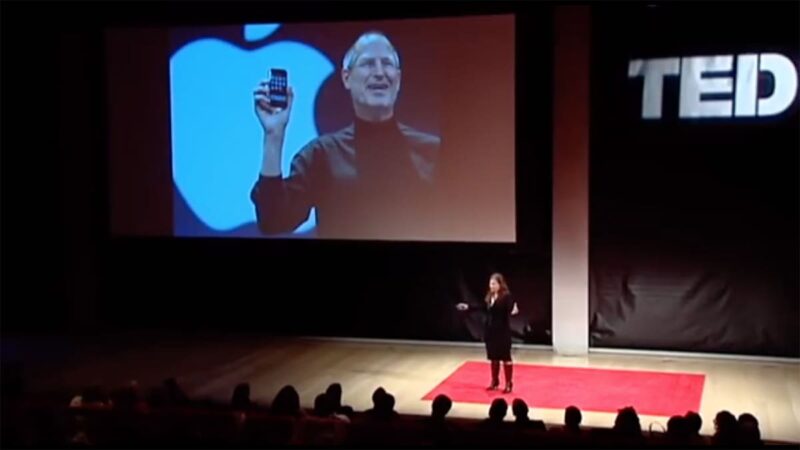
The secret structure of great talks
From the “I have a dream” speech to Steve Jobs’ iPhone launch, many great talks have a common structure that helps their message resonate with listeners. Watch Nancy Duarte’s TEDx Talk that’s garnered over 3 million views.

Presentation formats guide
Get tips on how to determine your presentation format. This guide will help you consider audience size, presentation setting, and the delivery method that best suits your communication needs.
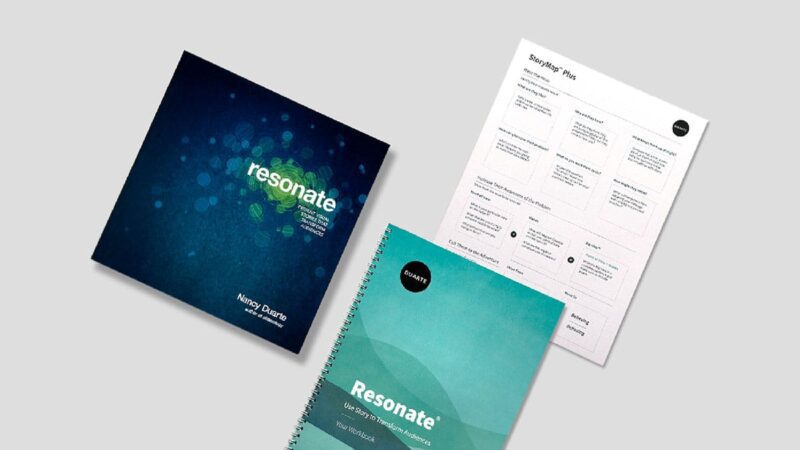
Resonate ® workshop overview
Learn how the world’s greatest speakers use story to persuade. Develop a story structure that powerfully expresses your ideas, applying the principles of empathy, contrast, and variety.
How to Write Incredible Calls to Action (with Examples)

What if I say, “Subscribe to our email newsletter at the end of the article?” Probably, you’ll skip it and forget when reaching the subscription button. Why? Because a compelling call to action is not only about using action words. CTAs should appear at the right place and contain the right words to lead to conversion.
A CTA is a suggestion to people to perform a certain action: subscribe, download an ebook, schedule a call, etc. Website owners place them in various parts of the page, depending on the goals, such as:
- above the fold;
- in the middle of an article;
- next to the lead form;
- in the right rail and many other places.
How should you arrange CTAs to encourage the audience to do what’s expected? This post will enumerate some helpful tips for successful call-to-action writing and show real-world examples from various spheres.

Image credit: Freepik
7 Proven Tips for Crafting Effective CTAs
Choose the right action verb.
CTAs usually appear precisely at the end of the message. It’s the last opportunity to reach out to consumers and point them in the right direction on their purchase journey. Where can you see them? On buttons, ads, banners, pop-ups, slide-ins, or at the end of videos. In any case, you have limited space for them. That’s why the CTA should be short, concise, and punchy.
Use a command verb at the beginning of the CTA copy. Compare the following variants and think of what will be more effective:
- Start your 14-day free trial period now.
- A 14-day trial period is available.
The first option is the clear winner because it tells the audience what to do. Remember that a strong call to action eliminates as much thought as possible. Choose the needed verb to match your situation and purpose, such as:
- sign up, subscribe, register now/get access
- download, start free trial;
- learn more, click here;
- buy/purchase, shop, order.
Use Power Words and Emotional Triggers
Another crucial component of call-to-action writing is power words . These are words that appeal to emotions and trigger the desire to click. While action verbs tell readers what to do and what will happen after clicking a link, power words subtly nudge people to the desired page. They rely on people’s emotions as a motivation to proceed, such as:
- fear : mistake, nightmare, painful, crisis, danger;
- encouragement : amazing, astonishing, life-changing, astounding, effortless;
- lust : thrilling, pleasurable, mouthwatering, compelling, engaging;
- anger : misleading, diminish, infuriating, annoying;
- greed : double, profit, explode, quadruple, extra, reduced;
- safety : proven, risk-free, moneyback, secure, refund;
- curiosity : lost, never seen before, unconventional, invitation only, confidential.
A strong CTA is the one people feel , not just comprehend. For example, “Secure your spot for the concert of a lifetime now,” will elicit a different response from viewers than, “Get your tickets for the concert now!” due to phrases like “lifetime” and “secure”. Another way to evoke enthusiasm is to leverage punctuation like an ellipsis or an exclamation mark.
Create Urgency and Scarcity
As most purchases are emotional rather than rational, another motivator can be a fear of missing out (FOMO). It’s one of the most widely-used tactics in e-commerce, where sellers show the number of remaining goods or the time left until the discount expires. So you can do it in the CTA.
The more people think, the less likely they will buy, remember? A sense of urgency/scarcity encourages people to act without much consideration. You can also find FOMO in social proof. If someone uses this product or service, others will be interested in joining the crowd. You can employ this idea in the CTA. Find a problem that your audience is experiencing. Emphasize it, show people they are not alone, and provide a solution.
Highlight the Benefits and Value Proposition
There is hardly anything more persuasive than a benefit . It works as simply as suggesting some perks for clicking the button. In other words, what are consumers going to gain from it? Will it enable people to perform their jobs more effectively, get in shape, or save money? You can add a tangible benefit like a discount or promotion. To show readers the value of clicking, start the CTA with words like “save” or “redeem” like “Save 15% by calling today!”
Or you can combine a USP and CTA in a single statement to persuade potential customers to take action. By highlighting what makes your product or service unique and motivating the user to take a specific action in line with that USP, you can increase the chances of converting them into leads or customers. Here’s an example of a USP/CTA mash-up:
“Get the best deals on luxury vacations - Book now and save 50%!”
Here you mention the action you expect users to perform (“ book now” ) and bring up a reason to do it ( “save 50%” ).
Personalize the CTA for the Target Audience
Personalization is one of the easiest ways to elicit emotions. It shows users that you value them and take a genuine interest in guiding them through the purchase journey smoothly. That’s why personalized CTAs can be so effective. According to Hubspot, tailored CTAs outperform standard CTAs by 202% .
Suppose a new website visitor, John, adds some products to the cart but leaves without buying them. You can show an exit-intent pop-up before he closes the tab with a personalized advertising call to action, such as: “John, get 10% off your first purchase! Plus, free shipping on orders over $50. Shop now and start saving!”
But if it was your existing customer, Rebecca, you could show her another pop-up, such as: “Welcome back, Rebecca! As a valued customer, we’d like to offer you 15% off your next purchase. Take advantage of this exclusive offer by making your purchase right away!”
Consider your audience when crafting your message, and address them specifically. You can segment people by age, gender, profession, level of proficiency in using your software, and other traits to offer the most relevant products and services.
Apart from writing a tailored message in your CTA, personalization can also be achieved by using new tools for sales documents creation. If you go with an interactive sales deck or proposal, you can add an impactful CTA by embedding your own calendar in the message, so that your potential customer can book their next meeting simply by reading your proposal.
Include Numbers If Relevant
Numbers catch the readers’ attention because they stand out on the page with text. So it’s another way to persuade people to click. Numbers also provide information that audiences want, like phone numbers, pricing, or advantages. For example, “Learn a new language in just 30 days with our intensive course.” It’s easy to spot the numbers, so viewers will immediately grasp the possible advantages of responding to your CTA.
You can also include a price in the ad copy and CTA. Why should you do it? On the one hand, you may scare away users from clicking the button and reading more about the product. On the other, if people deliberately respond to the ad knowing about your pricing, it shows their interest in the offer. It reduces the chances of bouncing from the landing page, increasing the return on ad spend.
Test and Optimize the CTA
Calls to action are tricky since you won’t know how effective they are until you put them to the test in real life. An idea that seems terrific on paper may not work well in practice. Thus, you need to understand why the CTA performs poorly and what doesn’t appeal to viewers. But how do you determine the need to change something? Through A/B testing.
A CTA is one of the most accessible and suitable page elements for the A/B test. A small change in word choice can have a significant impact. A/B testing lets you find the best option not only in terms of wording but also in placement, colors, size, etc.
Examples of Incredible CTAs
Now that we know the best practices for organizing CTAs, let’s examine how different companies do it. We’ll analyze call-to-action examples of online stores, SaaS companies, and nonprofit organizations.
E-commerce CTAs

Screenshot taken on the official Converse website
The first example under consideration is from Converse, a renowned lifestyle brand. The company uses several tips mentioned above:
- the language is simple to comprehend;
- numbers are showing the benefits of performing a particular action, such as 15% off the next order for signing up;
- the CTAs stand out from the rest of the content because they are bold or contrasting.
Ulster Weavers

Screenshot taken on Ulster Weavers
In this example from Ulster Weavers, we see the emphasis on FOMO. The bag is at a lower price, but only one item is available, so the retailer leaves us less time to think but to click the “Add to Cart” or “Buy it now” button.

Screenshot taken on the official Kusmi Tea website
Kusmi Tea decided to play with words and use the CTA “Enjoy now” instead of a basic “Click here” or “Shop now”. Don’t be afraid to get creative, as Kusmi Tea does in this screenshot. You can also notice that there is a lot of space around the button. This trick and the contrasting black color on the orange background make the CTA more visible.
Service-Based Call-to-Action Examples

Screenshot taken on the official Salesforce website
Here we can see several CTAs. Salesforce directs the viewer’s attention to them in the following ways:
- “Start free trial” is in the hero section of the website and is filled with color. So we understand it’s more important than the “Watch demo” button next to it.
- “Try for free” is filled with a contrasting green color for more emphasis. It also denotes no obligation to pay at the moment of clicking.
- The “Let’s chat” button is also noticeable. The photo on it aims to create a personal connection with the visitors and increase the likelihood of them engaging in a chat.
Time Doctor

Screenshot taken on the official Time Doctor website
When adding creativity to your CTA, be careful with misleading users. For example, the screenshot from Time Doctor illustrates two CTAs on the exit-intent pop-up:
- “Yes, help me increase my team’s productivity.”
- “No, I don’t need insight on what my team is doing.”
Unfortunately, they lack information about what will happen after choosing each. While you may guess the second button will close the pop-up, the first one may be confusing. Will I schedule a call, download the app, or get to the checkout page? No idea.

Screenshot taken on the official Exabytes website
This screenshot from Exabytes demonstrates a personalized approach. The CTA contains a personal pronoun, “My”, creating a sense of ownership and exclusivity in the customer’s mind.
Nonprofit CTAs
Elevation church.

Screenshot taken from the newsletter from the official Elevation Church website
It’s an email from Elevation Church. We can see that the organization displayed creativity in its “READY. SET. SHOP” advertising call to action. What may be the reason for that? It can be a powerful way to reach younger generations and differentiate an email from other generic promotions.
African Wildlife Foundation

Screenshot taken on the official African Wildlife Foundation website
Another nonprofit with impactful calls to action is African Wildlife Foundation. They are one of the first things you notice on the page. CTAs are concise and inspire supporters to learn more about the organization or donate immediately.
Over to You
Calls to action are indispensable elements of web forms , ad campaigns, emails, and social media content. What are the tips for designing them? We’ve looked at the top seven strategies, including:
- beginning with a powerful verb;
- appealing to emotions;
- leveraging numbers;
- offering benefits;
- instilling a sense of urgency;
- personalizing CTAs according to user preferences, behavior, and types;
- testing various aspects of CTAs thoroughly.
These tips will help you amplify your conversion rates and find the key to your audience.

Kate Parish
Related posts.

TikTok’s Insta Dupe, Updates to query matching for Google Ads, RIP Universal Analytics, and more…

How to get your Amazon Ads to the top of the search results page

Five ways to amplify your reach with Walmart Connect
Commerce media at cannes, new meta ai business tools, elon’s apology, and more…, see why brands have relied on marin to manage over $48 billion in spend.

- How to Write ____
How to Write a Great Call to Action

Table of Contents
Persuasive content writing—website pages, blogs, marketing campaigns, newsletters, and digital ad copy—all have one thing in common. They demand the perfect call to action. If you need more subscribers, sales, or a jumpstart to your leads-to-conversion rates, then it’s time to use a great call to action! And learning how to write a call to action is easier than you might think. Let’s get started.
What Is a Call to Action?
A killer call to action does two things: It tells the reader what you want them to do, and it provides the motivation to do so. It is basically a few words or a phrase that you use to convince the reader to take action and do it now!
Use Action Words
Your goal is to motivate the reader to DO something, to take action. Think of the CTA as a verbal command—you are telling them what to do next and why it is essential. Therefore, you will need to use action words to do the job. Check out these CTA examples that start with an action verb:
- Get It Today
- Join For Free
- Buy It Here
- Watch It Now
- Send Me Specials
Convey a Sense of Urgency
Knowing how to write a compelling call to action is one thing. Knowing how to add a sense of urgency to it is taking it to the next level. When something is time-sensitive, we tend to pay more attention to it. We reread it because we don’t want to miss out by being late. A call to action that employs urgent words or a reminder that time is running out is an excellent way to get the reader to click on the CTA button quickly.
Here are some examples of CTAs that suggest a feeling of urgency:
- Save 15% Today!
- Time Is Limited
- Claim Your Free Trial
- We Need Your Help!
- Limited Edition
- First Order Free—Shop Today!
Short and Sweet
Keeping the call to action short and sweet is the key. Strive to be concise, not too wordy. That being said, there’s nothing wrong with having a call to action that is a full sentence. Or maybe even two. But, in most cases, a shorter, direct CTA is the best bet. Focus on what is most important in your message. Keep it brief and straightforward. Too many words, too many options may spell too many chances for the reader to get distracted and leave the page. So, opt for a succinct, easily identifiable call to action. For example, try these CTAs:
- Sign Up Free
- Get Started
Use a CTA Button
A clickable call to action button is simple to use. It clearly stands out on the page, and the reader knows exactly what to do. Keep it to less than five words. Otherwise, it just looks crowded and messy on the button. Use a contrasting color to grab attention. And avoid using “Click Here” for a CTA button. It’s outdated and will make your marketing look amateurish. Instead, opt for a simple CTA button like these:
- Discover More
- Sign Up and Save 20%
- Start Your Free Trial Today
- Donate Here
Use Hyperlink Text in a Long Form CTA
A call to action can also effectively be used in anchor text—the blue, underlined clickable text in a sentence containing a hyperlink. You may need to offer more incentives or reasons behind why you want the reader to take action. Offer a little backstory. Present an example. Explain how you can help. Check out these examples:
- Ready to build your new home? Let’s start this journey together. Give us a call today .
- When you’re ready to start the application process , we will walk you through it line by line.
- Want to provide food and shelter to an animal in need? Donations to our shelter can save a life. We appreciate your support!
Find Out What Works
It’s important to find out what works… and what doesn’t . Just because you’ve come up with a great call to action doesn’t necessarily mean it’s the right call to action for your ad campaign. Some CTAs rank lower than others in terms of conversion rates. Marketing campaigns often run experiments to see which types of CTAs are more successful than others. For instance, “Sign Up” doesn’t do as well as “Learn More” in some settings. Apparently, users associate “Sign Up” with entering their credit card or ending up on a mailing list. In comparison, “Learn More” doesn’t carry the connotation of commitment.
Therefore, you may have to experiment with a few different CTAs until you find the one that gets you the most clicks.
Writing a great call to action is easy once you understand the basics. Aim to create a CTA that is strong, well-crafted, and geared to your specific audience.
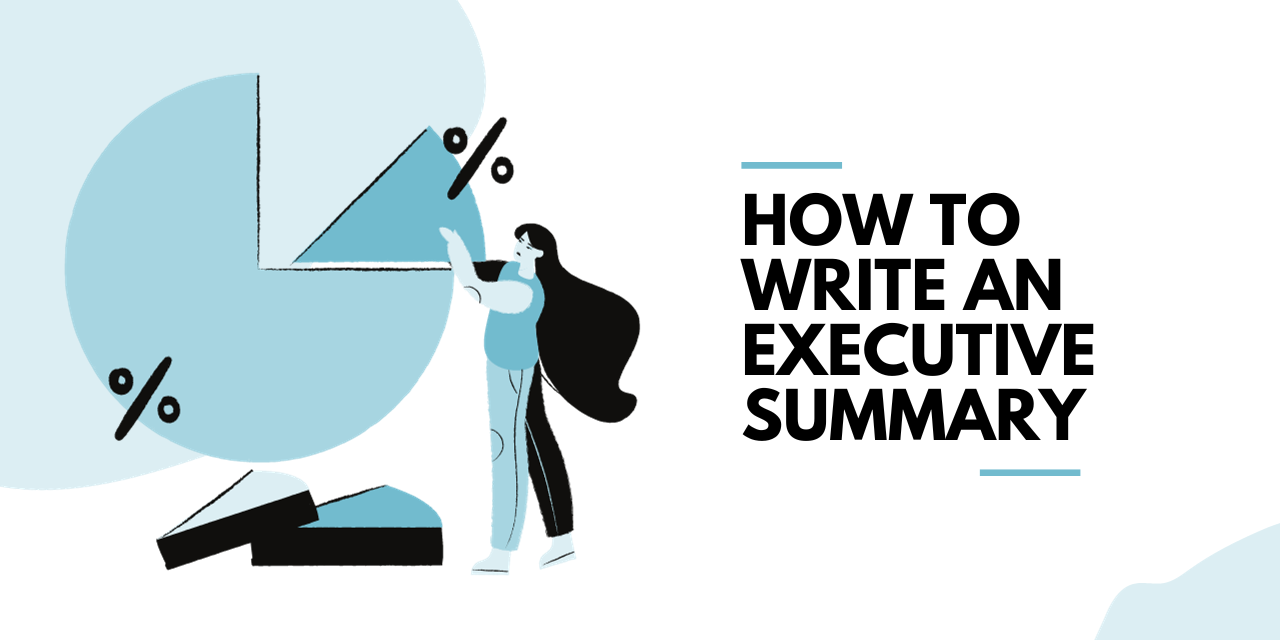
- Business Communication
How to Write an Executive Summary
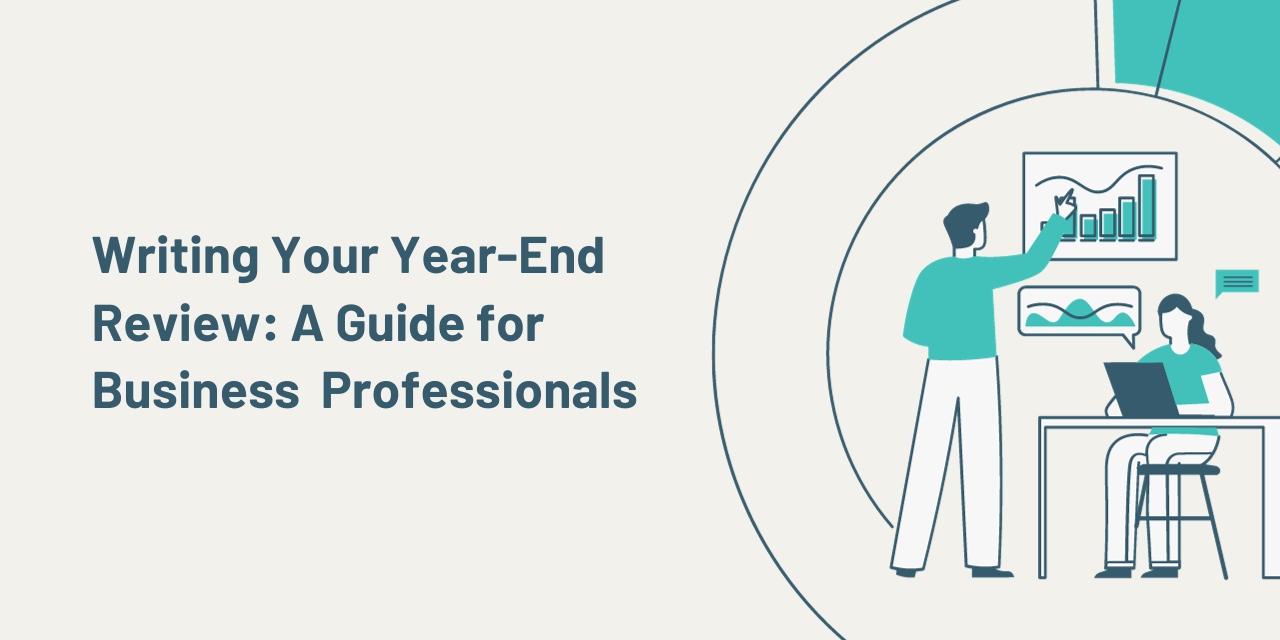
Writing Your Year-End Performance Review
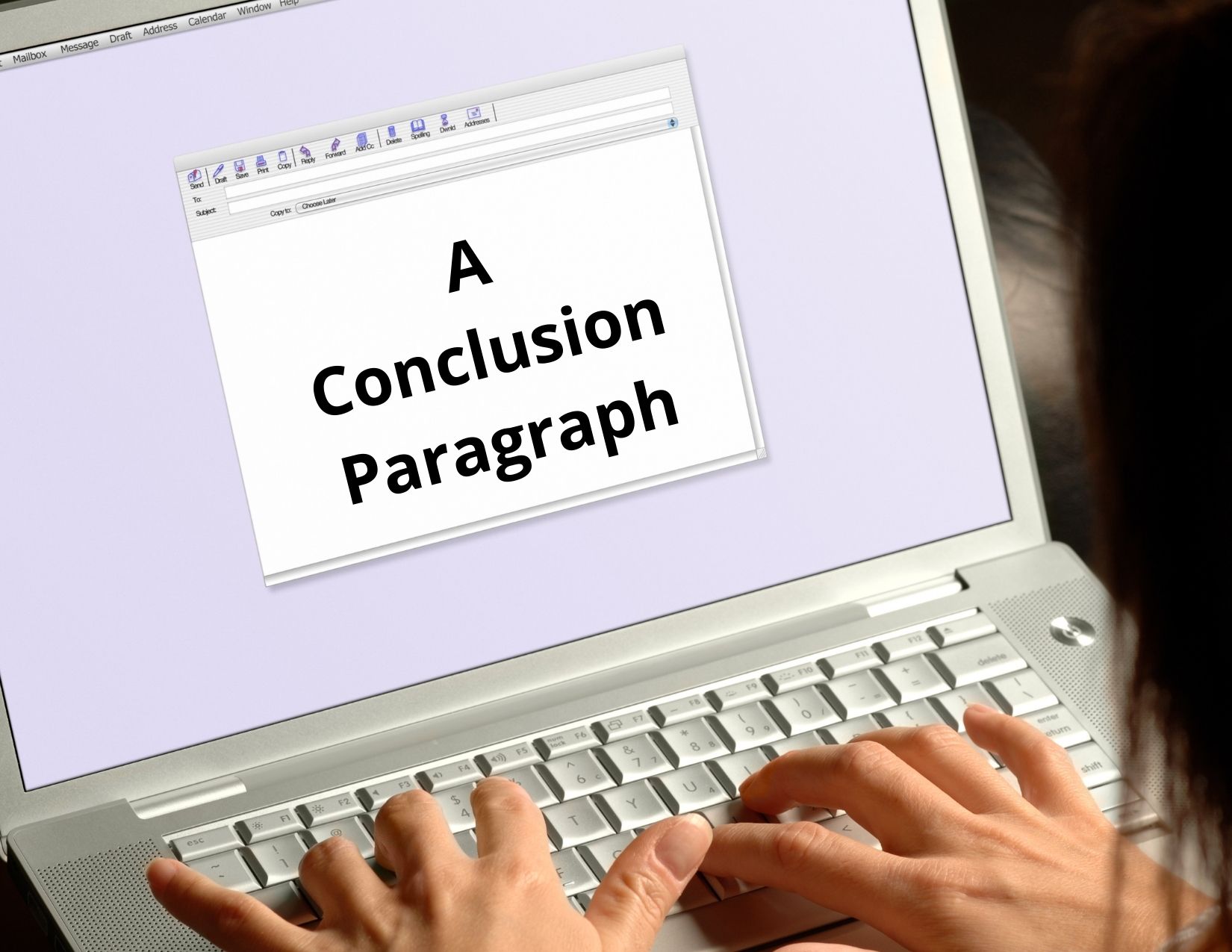
How To Write A Great Conclusion Paragraph
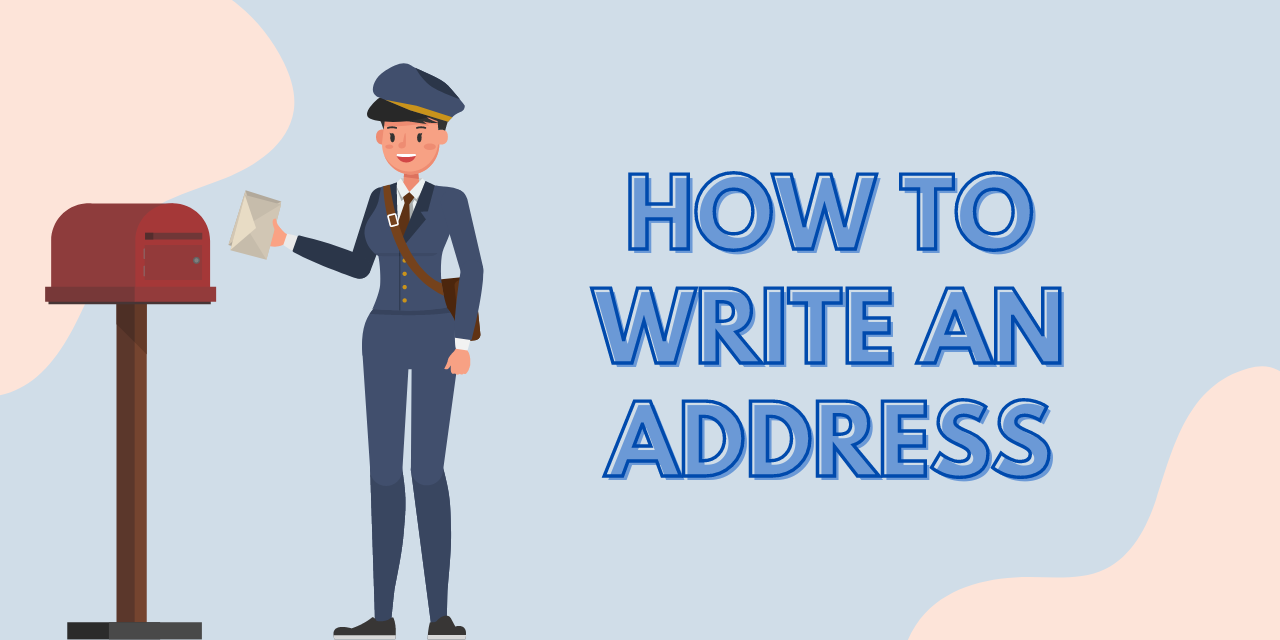
- Frequently Asked
How to Write an Address

How To Write a Whitepaper Document
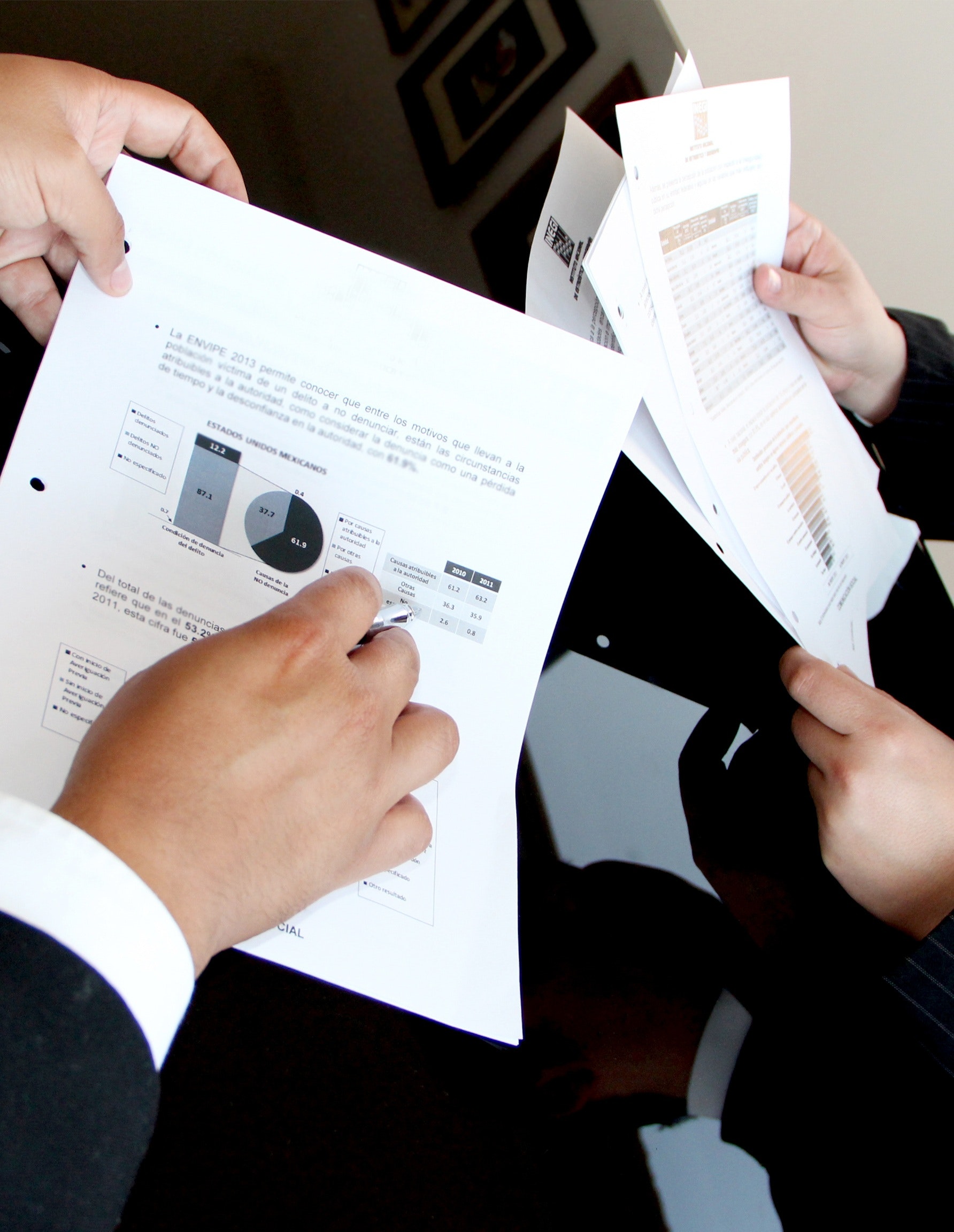
How to Write a Business Plan
Join the thousands who have sharpened their business writing skills with our award winning courses..
Copyright © 2024 Businesswritingblog.com.
Business growth
Marketing tips
16 call to action examples (and how to write a CTA)

What comes to mind when I try to think of a powerful CTA (call to action) is the one my dad expertly executed daily by bellowing at me to get a job . Fresh from a college experience that promised the world but mainly delivered a mountain of student debt, I was under the assumption that adulthood was supposed to be full of quirky adventures and unexpected meet-cutes, not unsolicited career advice from a man who still struggles to connect to Bluetooth.
Eventually, his CTA successfully motivated me to become a productive member of society. And that's the magic of a compelling CTA—it jolts you out of your passiveness and into action. In my case, I got a job despite a lifelong belief that work is something to avoid unless absolutely necessary. (Look at me now, Dad!)
Just as personal CTAs can lead to transformative life decisions, marketing CTAs have the potential to significantly impact user engagement and conversion. Want to craft your own magnetic calls to action? Keep reading for tips and examples of what makes great CTAs, well, great.
Table of contents:
What is a call to action?
A call to action is a prompt or message, usually formatted as a button or link, that encourages the audience to take a specific action.
CTAs are commonly used in marketing and sales contexts to guide users toward the next step in their journey, whether that's purchasing a product, signing up for a newsletter, or forwarding that chain email to all of their friends to avoid eight years of bad luck.
I know what you're thinking: "I'm a human adult with a brain. I'm not going to let a shiny button on the internet tell me what to do." But the reality is that the psychology behind CTAs taps into our innate desires and instincts, making us more inclined to follow through. Remember that one time you got lost down a YouTube rabbit hole, and six hours later, you're watching a documentary on bioluminescence in deep sea creatures? You have a few "Watch next" or "Smash that like button!" CTAs to thank.
Types of CTAs
You should calibrate your call to action with the relevant stage of a customer's journey. From the curious browser lured in by a "Learn more" button, to the nearly convinced shopper beckoned with a "Why choose us?" link, and finally to the ready-to-purchase consumer presented with a decisive "Buy now" directive—you want to ensure the user is always met with a suitable and enticing invitation, guiding them seamlessly down the funnel. Here's a primer on some of the most common types of CTAs.
|
|
|
|
|---|---|---|---|
| Encourages users to fill out a form, providing their information for various purposes | Contact page, request for quote page, or as part of lead generation forms | "Get a free quote" |
| Invites users to explore further content by clicking on a link or button | End of blog posts, related articles sections, or teasers | "Want to learn more? Click here to read the full article" |
| Directs users to a page or section highlighting the key features of a product or service | Homepage, product pages, or service descriptions | "Discover the key features that make our new smartphone stand out" |
| Encourages users to share content or products on their social media platforms | Near the content being shared, such as articles, images, or videos | "Share this amazing deal on Facebook" |
| Guides potential customers toward making a purchase after they've shown interest or engaged with your content | Product pages, shopping carts, or as part of drip marketing campaigns | "Add to cart and enjoy 20% off your first purchase" |
| Used to seal the deal or complete a transaction, often found in the final steps of the checkout process | Product pages, checkout pages, or limited-time offer banners | "Limited stock available. Buy now to secure your item!" |
| Promotes an upcoming event and encourages users to register or learn more about it | Event's landing page, email invitations, or display banners | "Register for our webinar" |
| Suggests other relevant content to keep users engaged and exploring your website | End of articles, blog posts, or in related articles sections | "Explore more on this topic" |
The effectiveness of a CTA depends on its copy, design, placement, and relevance to the user. The choice of words can significantly impact user engagement, as phrases like "Snag your copy" might resonate more than a generic "Download now," depending on your audience. Identify which action(s) will bring the most value to your business, then use your CTA to steer users in the right direction.
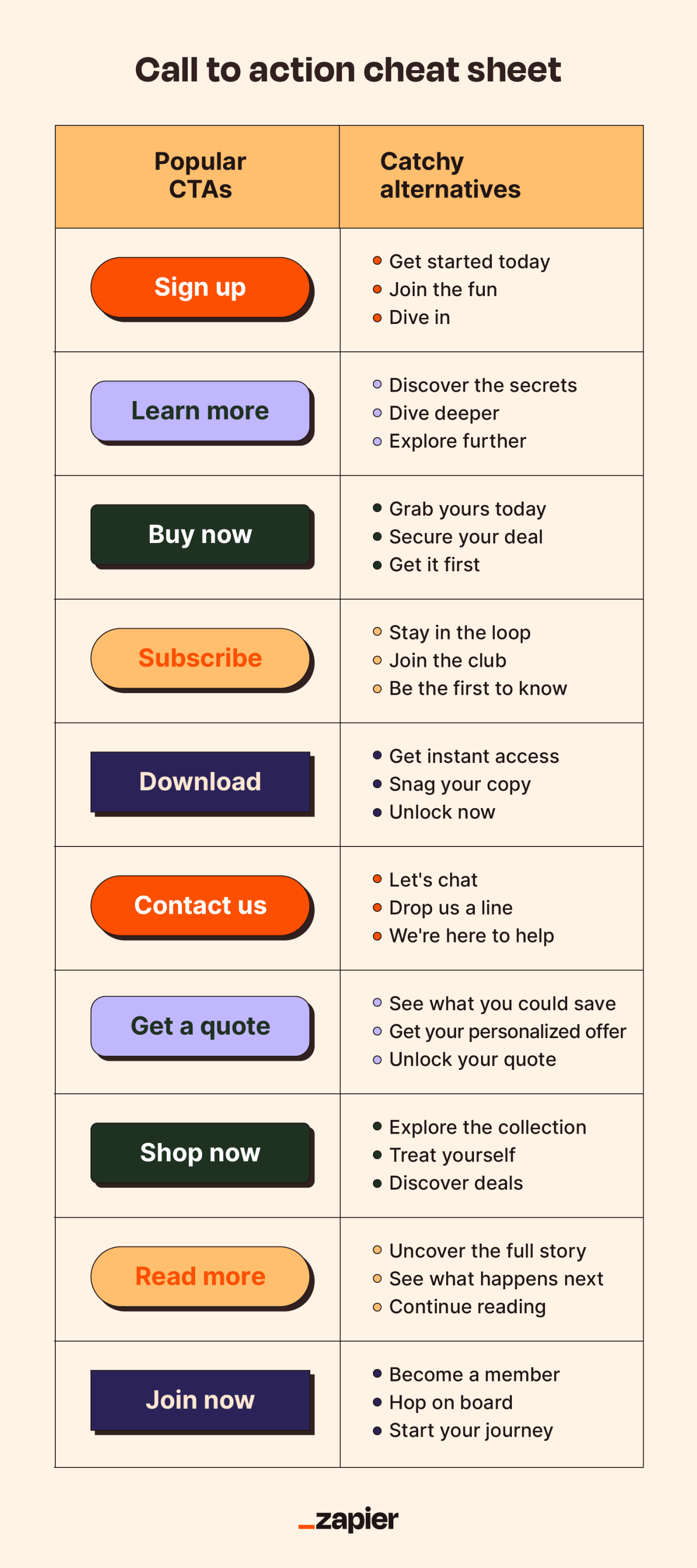
Why calls to action work
As a user of the beloved internet, you've absolutely seen calls to action that were pushy or patronizing, begging the question: "do I really need someone to tell me where to click?" But just like the difference between an aggressive sales rep and a sales rep that actually listens, a CTA that's written with care can get you a conversion without the negative connotations.
Why? Because having a strong CTA in your online sales pitch fits the psychology of your visitors.
But more than that, a call to action—like any good sales closer—acts as a climax to the pitch. It serves the same function as a joke's punchline, and without a CTA, the visitor is left in a sort of directionless limbo.
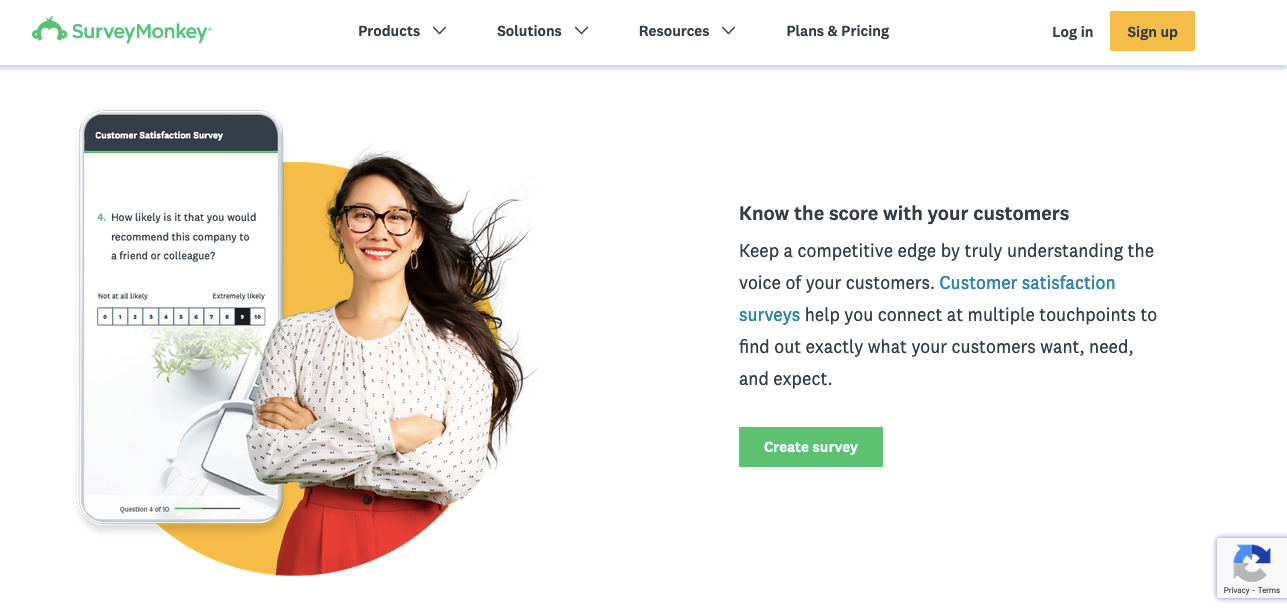
All in all, the call to action is the best online equivalent we can get to a personalized, face-to-face sales closer. We may not be able to tailor our final pitch to a particular customer, but we can use the same techniques and strategies on a broader, more inclusive scale. And therein lies the art of writing a CTA.
How to write a call to action
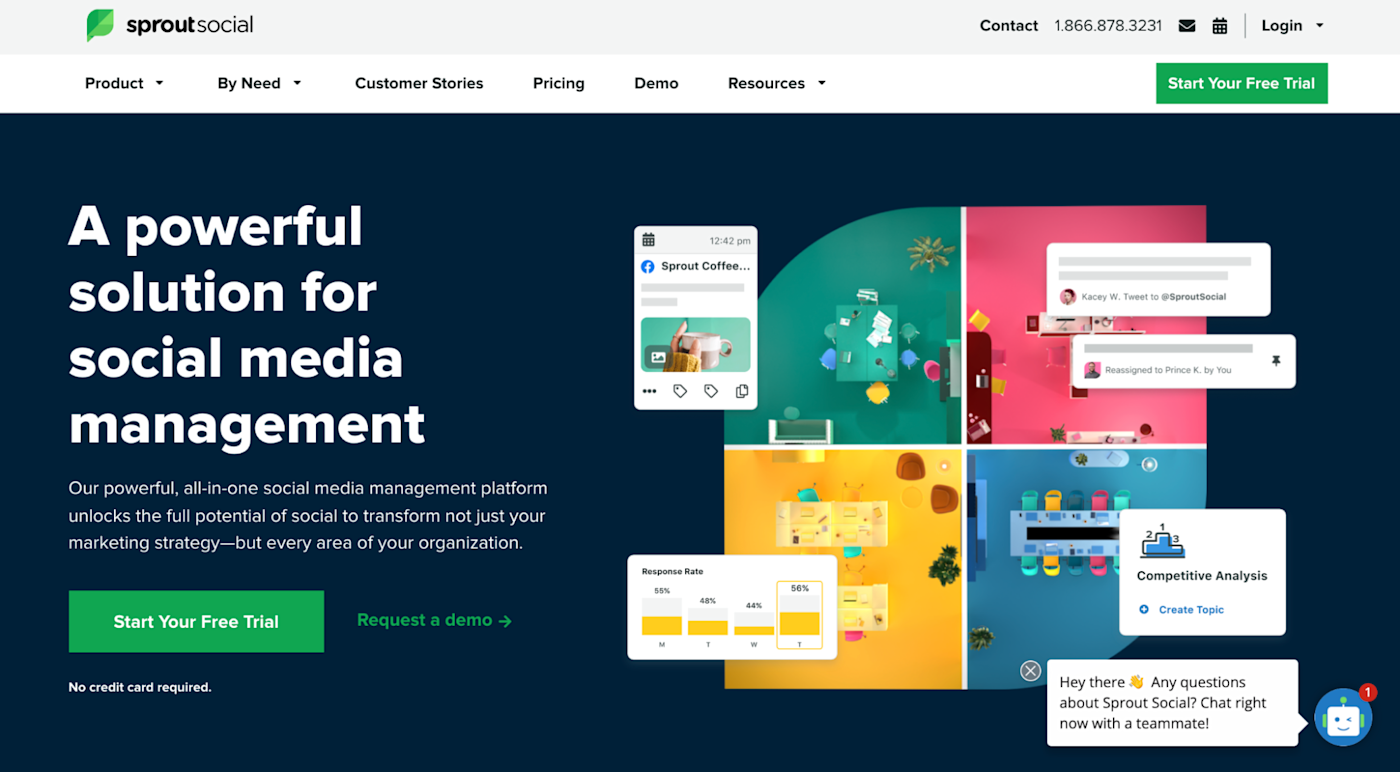
Your calls to action should be unique, specific to where it's featured as well as your particular audience and targets. That said, the best CTAs do share some characteristics that you can apply wherever they may be.
If you're looking for one secret to effective CTAs, here it is: give them a reason to click, share, or hand over their email address . More important than the wording, placement, or color of your CTA is the underlying incentive a person has to follow it. How will answering your call to action help them?
A good call to action restates its benefit bluntly and succinctly.
If you're offering a discount, remind them what percentage.
If they're getting a free PDF, mention the words "free" and "PDF."
If you're using a standard link, typically you write the incentive in your CTA's anchor text (the clickable text). In the case of social media posts and ads, you should reserve the last line in your message for your call to action, so mention any benefits there.
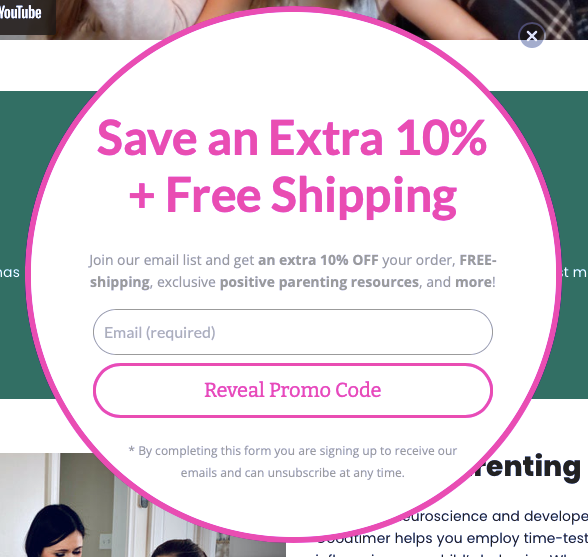
If you're using a button CTA, you have to limit the number of characters you use, so it's better to add secondary text. While the button can say something basic like "buy now," nearby you should include a line or two to remind visitors about the advantages to clicking.
Transparency
For starters, say exactly what will happen when you click. Remove all mystery with specifics. For example, saying "start your download automatically" is more descriptive than "click here to download." (For button CTAs, with limited space, you can include secondary text nearby.)
You want to acknowledge any user doubts and assuage their fears. If visitors are worried about security, they're not going to click, so reassure them that you understand their concerns. One of the big fears, in the case of email signups, is spam. You might want to gently remind visitors that you won't share their information and that you'll only email them once a week, twice a month, or whatever the case is, to keep their imagination in check.
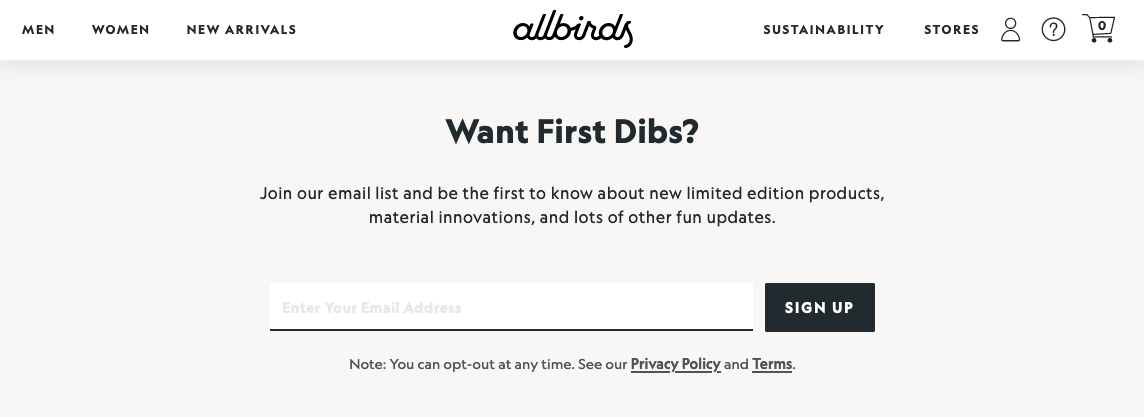
You can build trust just by being upfront about everything from the beginning. You'll find people are more receptive to your CTA pitches when they know precisely what to expect.
Command and wording
Don't be shy about calls to action! Some people soften their language to avoid being pushy, but CTAs should be strong and unapologetic. After all, if you followed rule #1 (incentive), then what you're offering is beneficial to the visitor.
That's not to say you should be rude or demanding (please don't); there's a perfect balance somewhere in there between a strong suggestion and a forceful command. Above all, the reader must always feel they have a choice; your call to action is there to convince them of the choice you think they should make.
Share this post
Join our newsletter
Subscribe for more deals
This makes the statement sound stronger, and at the same time, clearly communicates what the user should do.
Likewise, avoid wording that weakens your call to action, including "please" (no matter what Grammarly tells you) and modifiers like "could" and "would." There's a time and place for gentle language, but calls to action are not one of them.
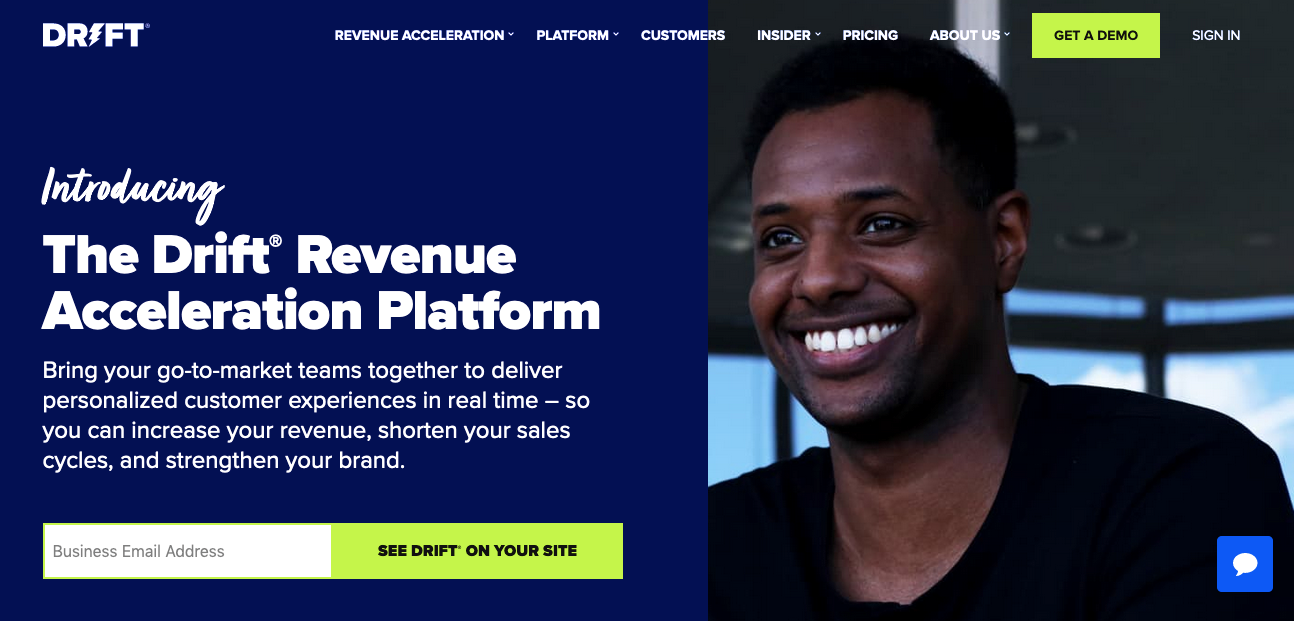
Word choice is important to CTAs, not only for making a persuasive argument, but also for fitting the space allotted.
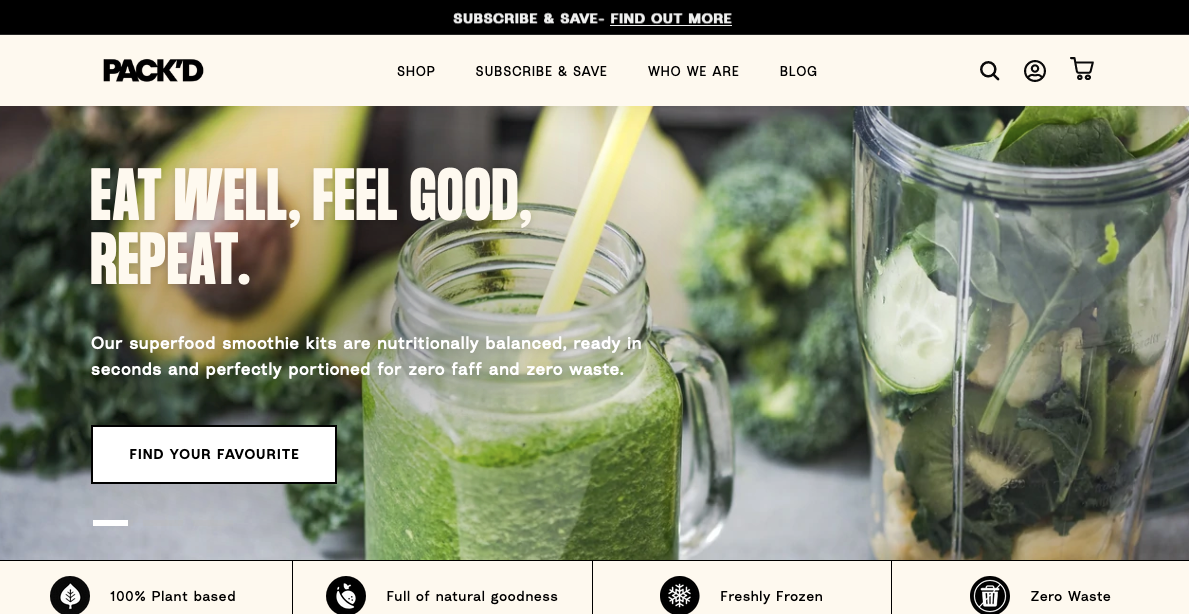
They're not foolproof, but in my experience, these words tend to improve CTA performance and the effectiveness of most sales copy. And because most of them are short, you should have no problem fitting them into your CTA space.
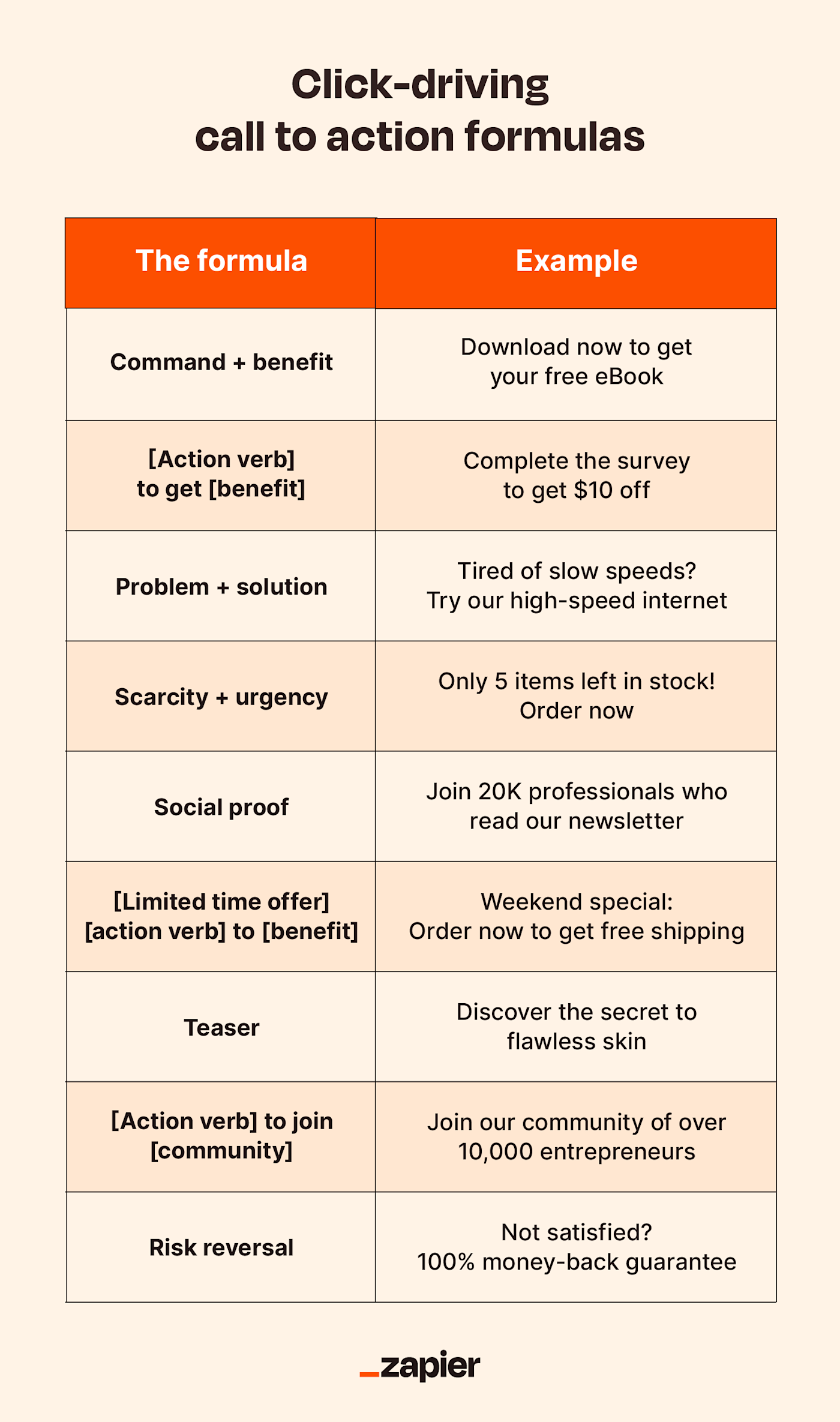
How to design a call to action
Now that we've covered the writing, let's talk about how your CTA should look. The design, layout, and typography of your call to action all play major roles in its success.
CTA design best practices
If you're placing your call to action on a web page or other content you design yourself, you want to place it at the top of your visual hierarchy. Your CTA should be the most noticeable element on the page. To achieve this, you want to pull out all your design tricks:
Contrasting colors: CTAs should generally contrast with the rest of the page's design. Visitors shouldn't have to work to find what to do next. Use a vibrant color for your CTA, especially against a dull background. Can you spot it from six feet away? Good.
Optimal size: Make the button and text larger than the surrounding elements but not so large that it overwhelms other content. It should also be easily clickable, especially on mobile devices.
Clear typography: Use a legible font that complements your brand. Ensure the text is large enough to read but doesn't crowd the button. You can play with typography to emphasize key words. Commonly, operative words like "free" are set in a different color or sometimes even a different font to attract more attention.
Negative space: Surround your call to action with plenty of negative, or empty, space. Setting your CTA apart from the other elements makes it more noticeable and gives it more importance in the eyes of your visitors.
Emoji use: Some brands find success with emojis, but if you choose that approach, remember that a little goes a long way.
Consistent styling: While CTAs should stand out, they should still align with your brand's overall design aesthetic. Consistency in design builds trust.
Call to action testing and iteration
Last but not least, you should evaluate how successful your final call to action is and identify room for improvement. Creating your CTA may feel like a lot of guesswork and shooting in the dark—because it is. Testing it is much more clear cut.
To get a basic idea of your CTA's performance, take a look at your analytics. Compare the page traffic to the number of conversions, and see what percentage of your total visitors clicked.
If your conversion rate is significantly lower, it's worth doing an A/B test on your design and copy. Try two different versions of your call to action, experimenting with different phrasing, colors, or fonts, and see which one performs better with your target audience. It's the most efficient way to reveal what works and what doesn't with concrete, empirical data, ensuring your CTA resonates with the target audience and drives the desired action.
16 call to action examples (and why they work)
Let's dissect some real-life CTA examples to learn how to use strategic copy, design, and placement to transform an ordinary CTA into a magnetic, can't-resist-clicking force.
1. JD + Kate Industries

CTA placement: Exit intent popup
CTA type: Lead to purchase
What it does right: Attention-grabbing, offers a valuable incentive, humorous and lighthearted
The brazen use of "WAIT" isn't a gentle suggestion; it's a command. Like someone grabbing your elbow just as you're about to duck out without a goodbye. It's intrusive, but in a way that makes you think, "Alright, what did I miss?"
Combine that with the sheer audacity of telling someone they've forgotten to buy not just one candle but HUNDREDS of candles. It's dramatic, it's over-the-top, and frankly, it's memorable. With copy like that, it's hard to resist giving away your email address because one can only wonder what their emails would be like.
2. Giftwrap.ai
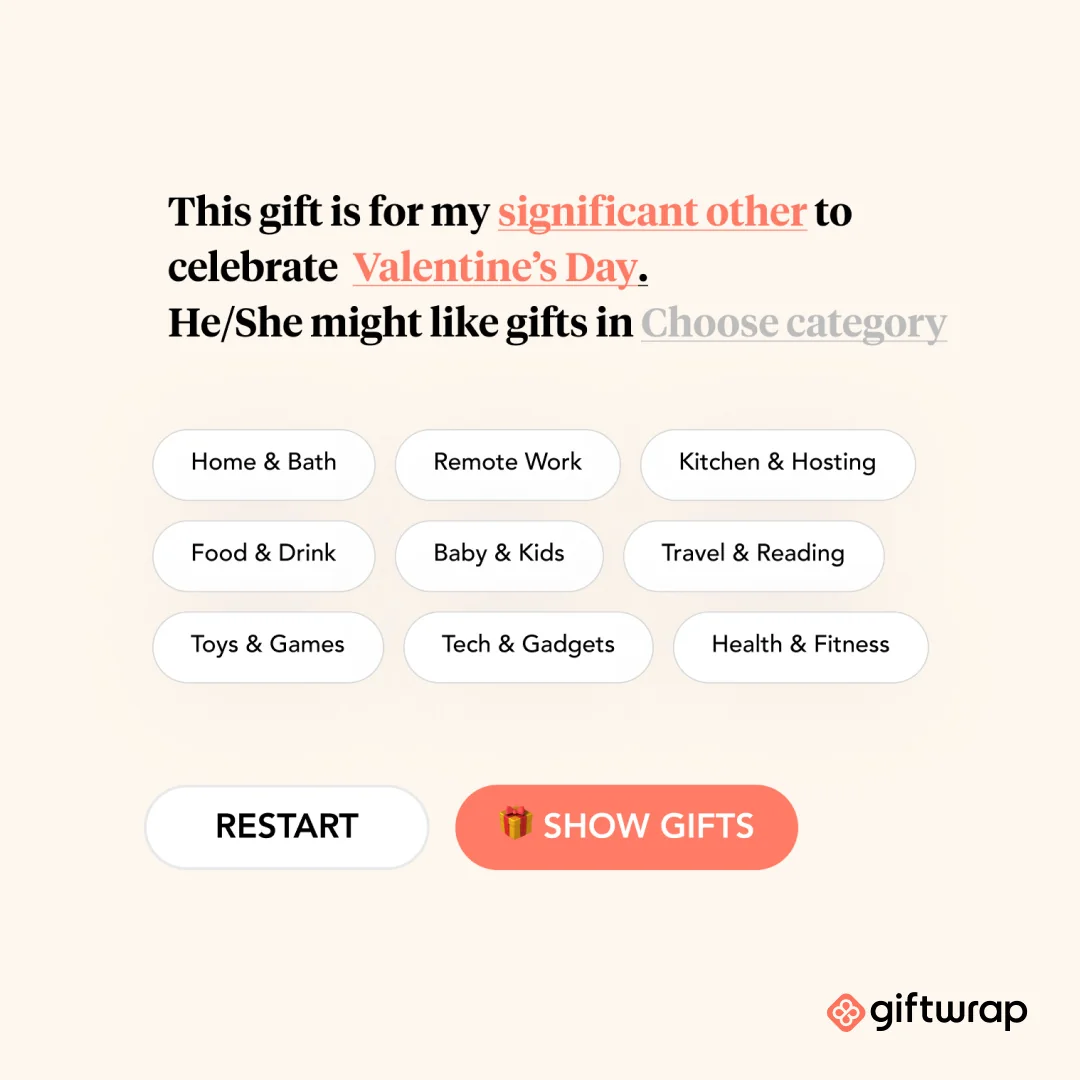
CTA placement: Display ad
CTA type: Lead generation
What it does right: Engaging, personalized, visually appealing
It's refreshing to see something that doesn't pretend to know you better than you know yourself. Instead of telling you what your significant other might want, it's asking you to fill in the blanks. A little bit of personalization without the personal touch. Clever, really.
As for the CTA button, the emoji is a nice touch. Plus, the use of "show" rather than "buy" or "see" is like a little magic trick. "Voila! Here are your gift options."
3. Who Gives A Crap

CTA placement: Facebook ad
What it does right: Benefit-oriented language makes the CTA more appealing to users and encourages them to take action
By comparing "Us" and "Them," they're not only offering a quantitative argument (385 sheets versus a paltry 299), but they're also injecting a bit of humor. And while I've never been one to count sheets, if you're telling me I get more for my money and it'll look cute next to my collection of HUNDREDS of candles, I'm sold. Also, describing the competitor as "objectively very boring" is a sentiment I've often used to describe my social life, but to see it on toilet paper? Well, that's something.
"28% cheaper than Charmin," followed by a "Shop Now" button isn't just a call to action; it's a call to revolution! A revolution of, well, saving on toilet paper and perhaps bringing a touch of flair to a decidedly unglamorous aspect of life.
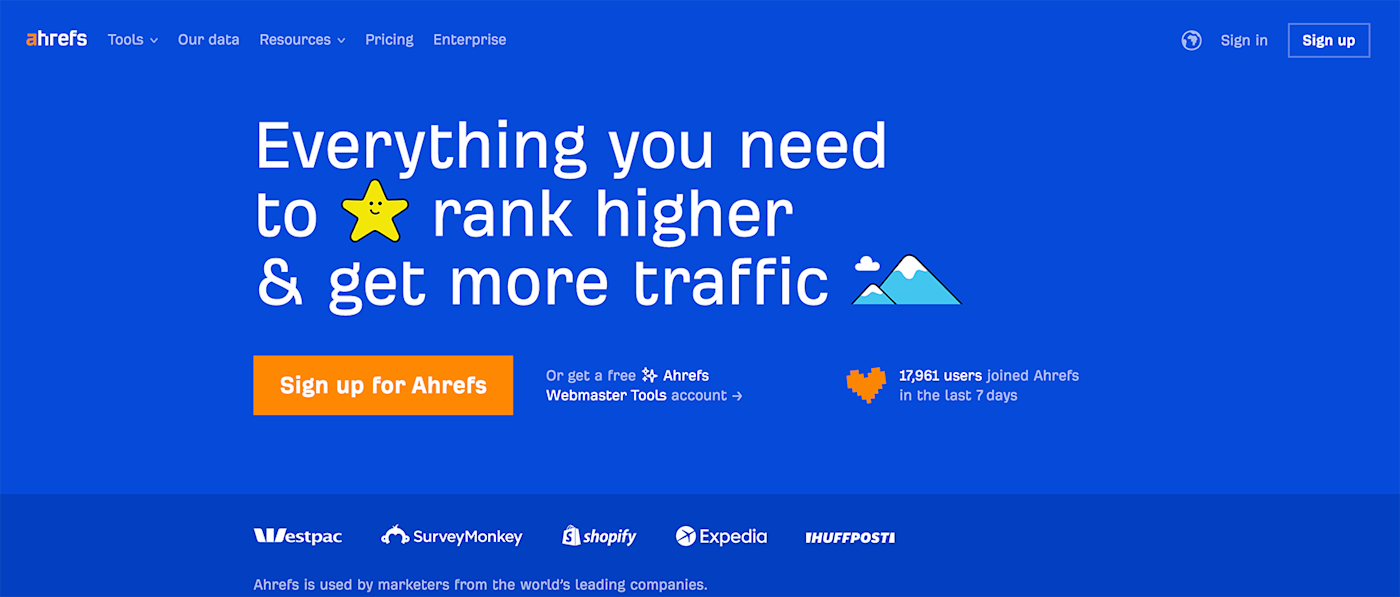
CTA placement: Homepage header
What it does right: Creates curiosity, addresses pain points, social proof
There's something oddly reassuring about a direct, no-nonsense headline promising exactly what every website on this overcrowded internet wants: visibility.
The name-dropping of heavy-hitter customers serves as a strong endorsement. It's not saying, "Look who trusts us," but rather, "Look who you'd be in company with." And that "17,961 users joined Ahrefs in the last 7 days" is a nice touch. It's not boastful, but it's certainly not modest. It's a subtle prod to the undecided that says, "While you're contemplating, thousands have already decided."
This CTA is a perfect blend of self-assuredness, social proof, and just the right amount of peer pressure.
5. Ruggable

CTA placement: eCommerce email
CTA type: Limited-time offer
What it does right: Straightforward, creates a sense of urgency, sparks curiosity
There's something unapologetically direct about this ad. "Final hours to save until next week Black Friday"—it's not asking you, it's telling you. Time's running out, and if you're the type who thrives on the thrill of a last-minute decision, this is your moment.
The CTA is a master class in suspense. That "% OFF" lurking behind the button is like when someone says they've got news, but they'll tell you later—except instead of being left alone with your intrusive thoughts, conjuring up worst-case scenarios, you get a sweet discount on a cute, machine-washable rug.
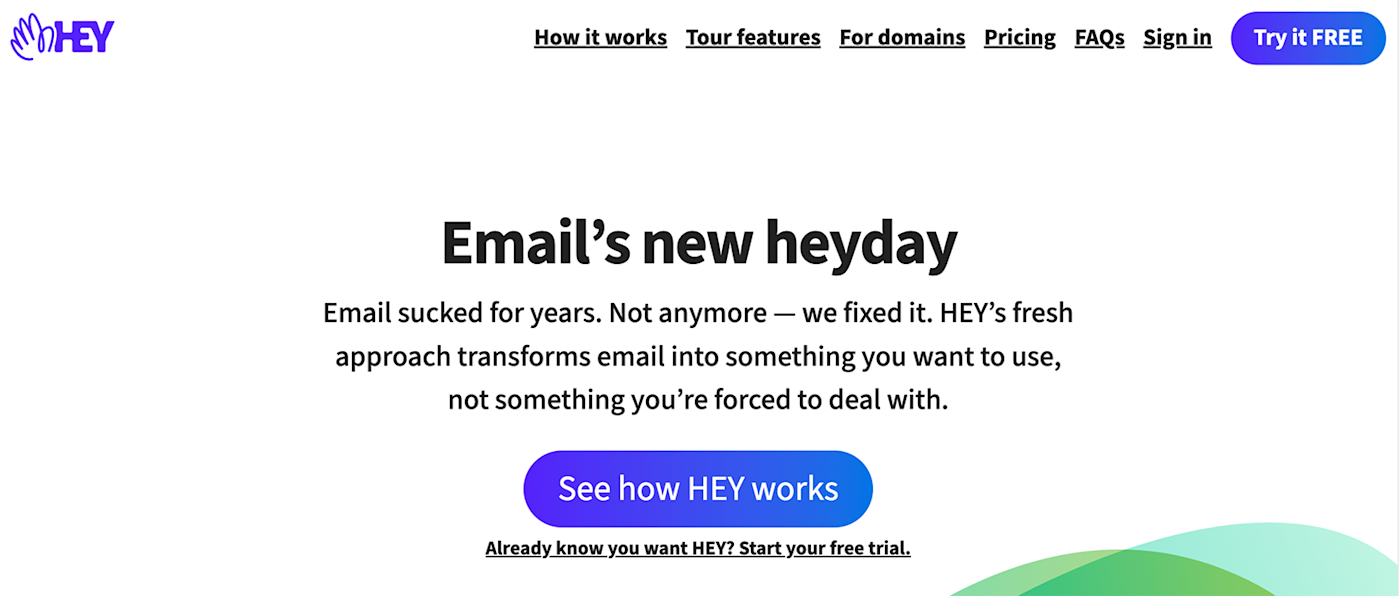
CTA type: Product demo
What it does right: Solution-oriented, benefit-driven, relatable
"Email sucked for years. Not anymore—we fixed it." You mean that thing everyone's been complaining about since the dawn of the internet? It's about time, and I'm all ears.
The rest of the copy succinctly addresses customer pain points and aspirational desires. It paints a picture of a world where checking your email might feel more like reading a postcard from a friend rather than sifting through a pile of bills.
The CTA button, "See how HEY works," is straightforward. No flowery language, no over-the-top promises. Just a simple invitation.

7. Big Blanket Co
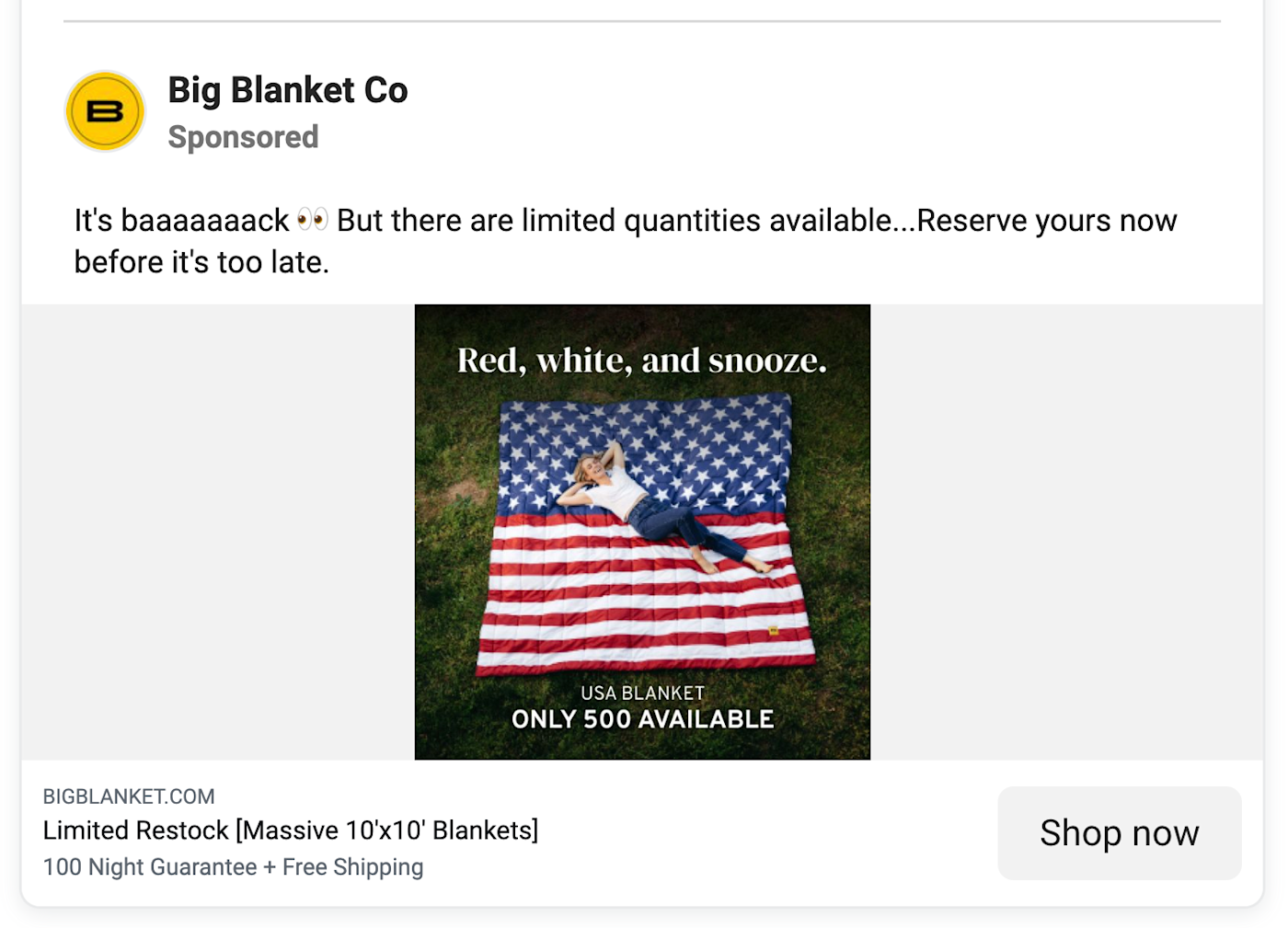
What it does right: Creates a sense of urgency, visually appealing, reassuring
The urgency of "limited quantities available...Reserve yours now before it's too late" is classic retail psychology. It's both an announcement and a challenge, like when a kid hears the whistle signaling the end of adult swim and races to be the first one to cannonball into the pool.
The "Limited Restock [Massive 10'x10' Blankets] 100 Night Guarantee + Free Shipping" is the clincher. It promises a combination of rarity, quality, reliability, and convenience, like a call to action Megazord.
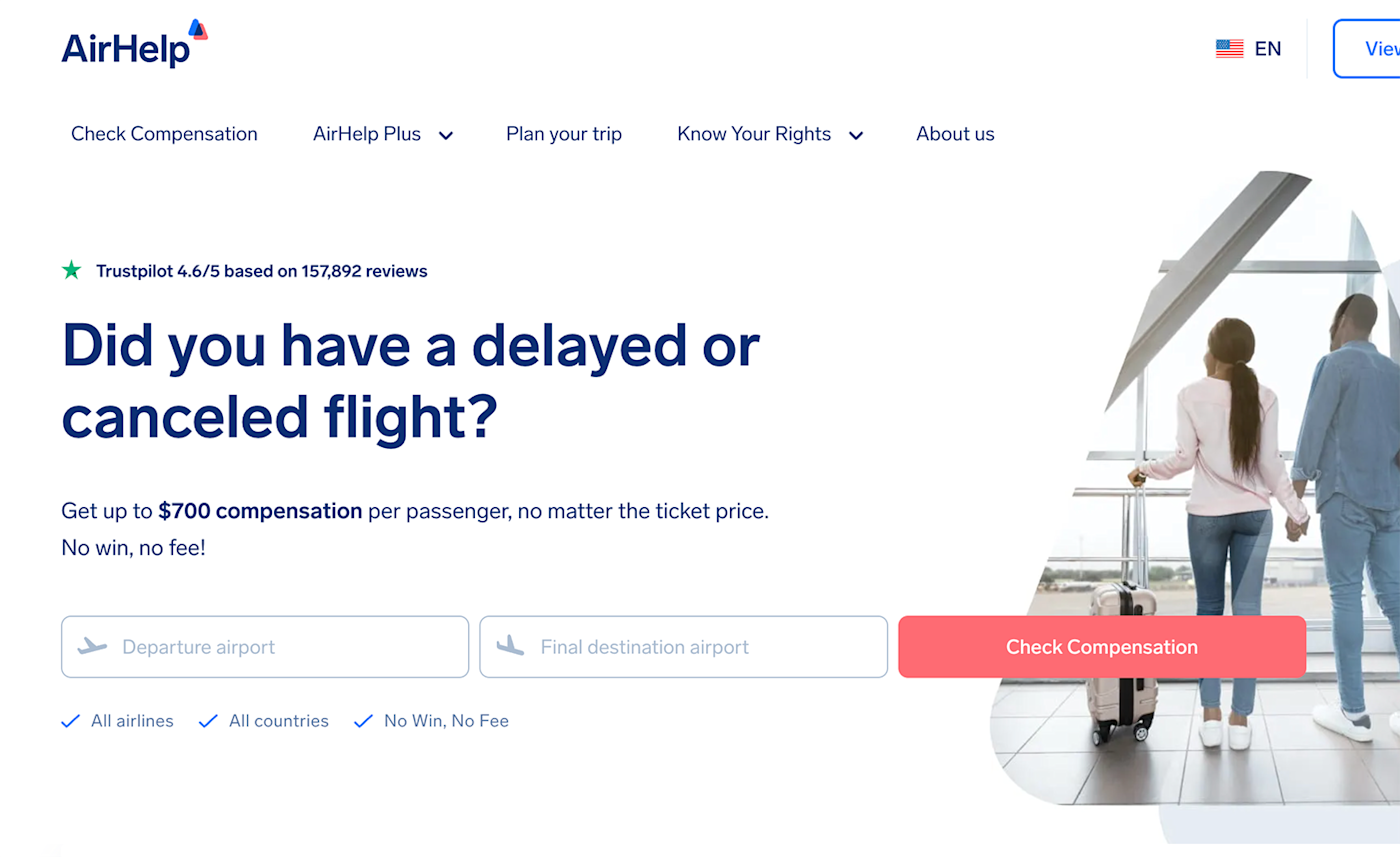
What it does right: Addresses pain points, benefit-oriented, actionable
The genius of this homepage lies not just in its promises but in its initial question—a direct prod at the pain point of its target audience that immediately evokes a visceral response. Most, if not all, travelers will mentally answer "yes" to this, recalling their own airport nightmares. It's a calculated reminder of a situation everyone wants to avoid, making the solution they offer even more enticing.
"Get up to $700 compensation per passenger, no matter the ticket price." The clarity here is commendable. They're not promising the world, but a very tangible, specific amount. And the Trustpilot rating is a nod to credibility. It's like a friend vouching for a restaurant they swear by, but in this case, it's 157,892 friends.
The two fields for the departure and destination airports are a clever touch. It's interactive, pulling me in, like when a quiz promises to tell me which '90s sitcom character I am based on my questionable life choices. (I'm George Costanza.) The button, with its sharp contrast to the rest of the page, effectively captures attention while still aligning with the brand's colors and aesthetic. "Check compensation" offers an inviting, low-effort action, subtly guiding users toward their potential relief without overwhelming them.
In a world where we're constantly sold solutions to problems we didn't know we had, this CTA addresses a very real grievance with a straightforward promise. And in the often convoluted world of travel woes, that's a breath of fresh, cabin-pressurized air.
9. Crazy Egg

What it does right: Actionable, benefit-oriented, simple
Crazy Egg's CTA isn't trying too hard to impress. It's just good—well thought out, concise, and to the point.
First, the headline: "Make your website better. Instantly." A rather bold proclamation but commendably straightforward. Its use of the word "instantly" suggests that Crazy Egg has the answers, and they're not going to waste your time.
The "Show me my Heatmap" CTA button is, once again, admirably direct. It's not pleading for a click or asking for a moment of your time. It's telling you, in no uncertain terms, what's on the other side of that click.
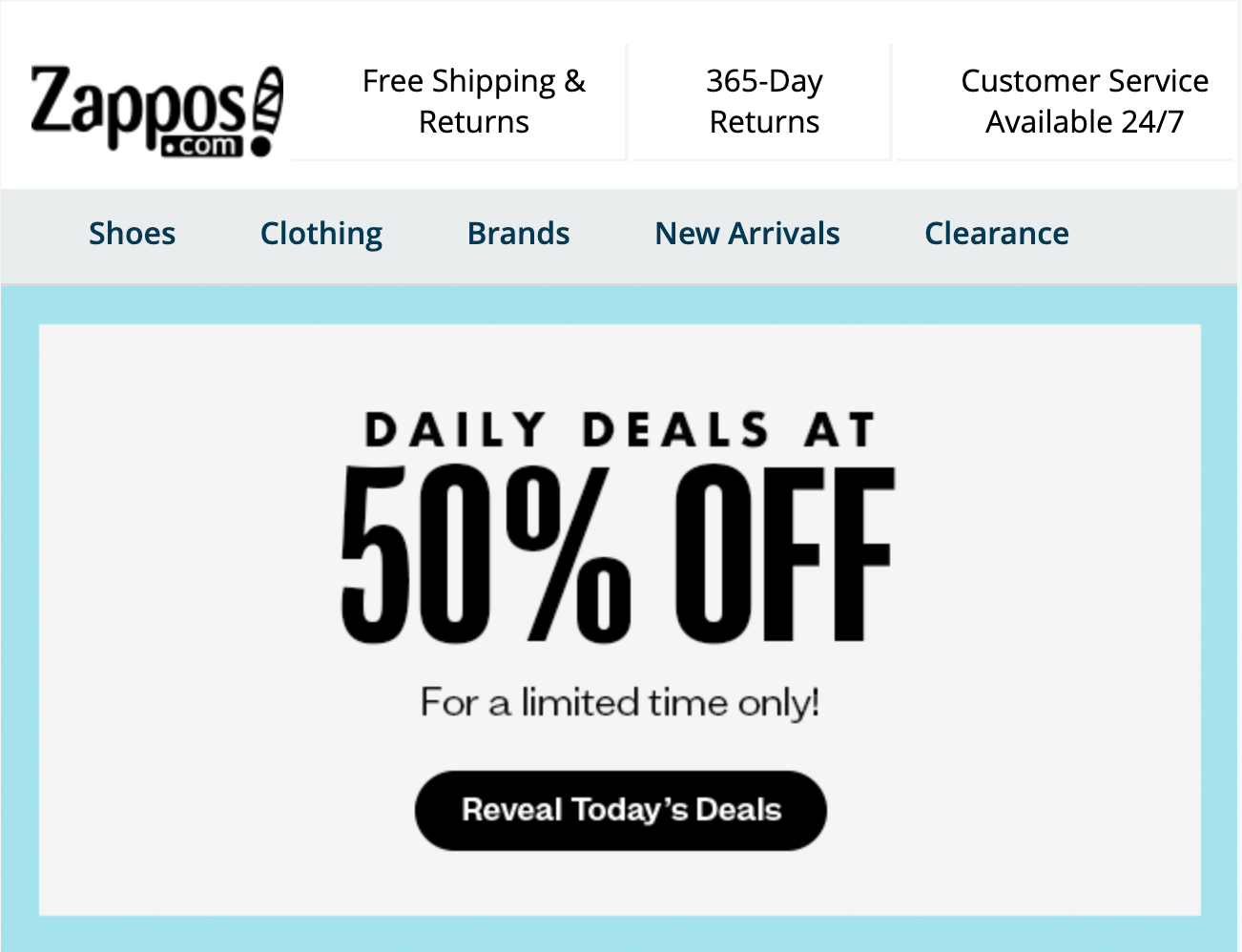
What it does right: Clear and concise, visually appealing, strong call to action verb
First off, big ups to Zappos for not making me do math. Half off? I'm already intrigued and haven't even seen the shoes yet.
"Reveal today's deals" feels like a game show moment. What's behind door number one? A pair of boots? New house slippers? It's that momentary thrill, like unwrapping a gift—even if you end up paying for it yourself.
In an endless sea of emails screaming for attention, this one from Zappos does what it needs to do: it grabs you, shakes you gently by the shoulders, and says, "Hey, want something good for half off?" And in this economy, who can say no?
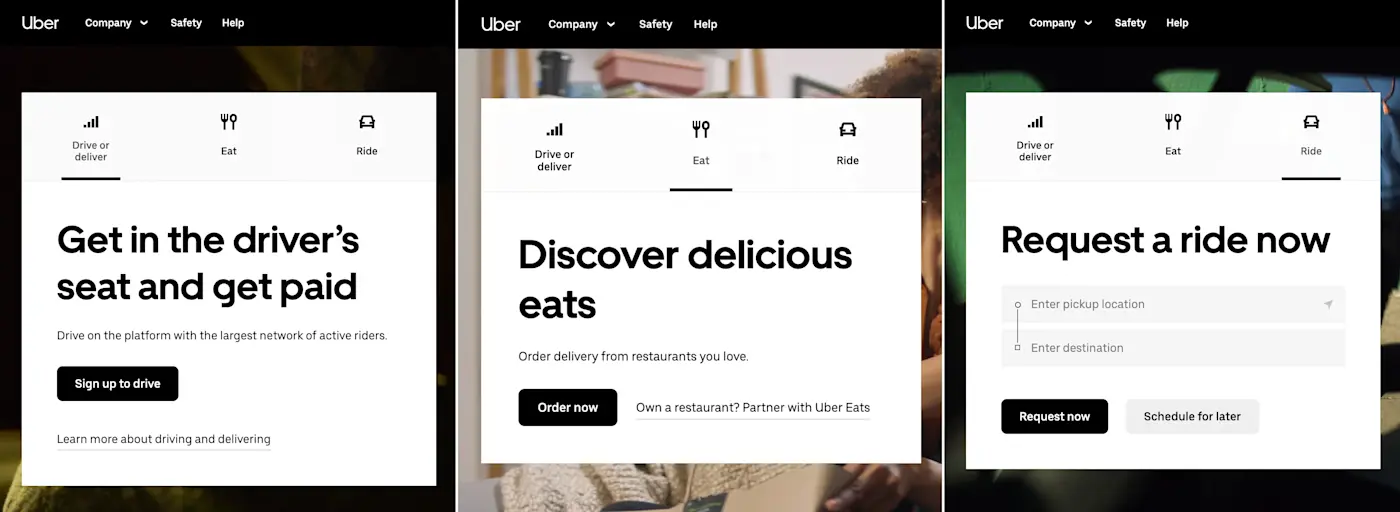
CTA placement: Landing page header
What it does right: Interactive and dynamic, personalized, sparks curiosity
By providing three clear choices (drive or deliver, eat, and ride), Uber shows that they understand and cater to the diverse needs of their users. This personalized approach instantly makes the user feel valued and attended to, whether they need a ride to the airport or just want to stuff their face.
The interactive nature of this dynamic content creates a sense of empowerment and involvement for the user. Even the tens of people unfamiliar with all of Uber's offerings will be intrigued by the distinct options, sparking curiosity and potentially leading them to explore other services beyond their original intention.
12. CareerBuilder
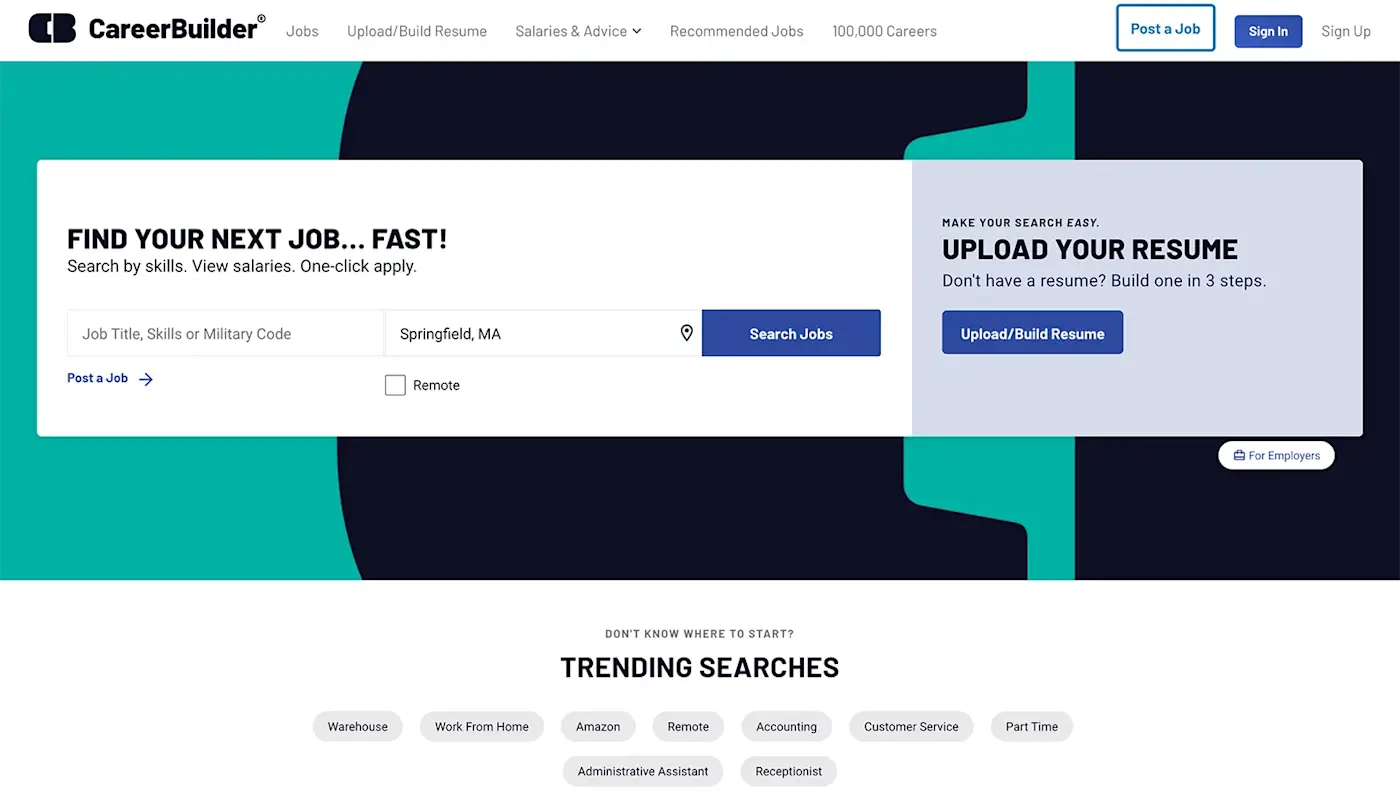
What it does right: Clear and concise, click-worthy secondary CTA
"Find your next job…fast!" Who are you, my dad? Although I suppose if someone's clicking their way onto a job-finding website, they're there for one reason: to snag a job, and preferably one that doesn't make them want to put a campfire out with their face.
CareerBuilder doesn't dilly-dally—they allow you to type in your wildly specific and/or desperate job requirements. And who's going to turn down the resume help offered in the secondary CTA? Talk about a lead magnet.
13. Airtable
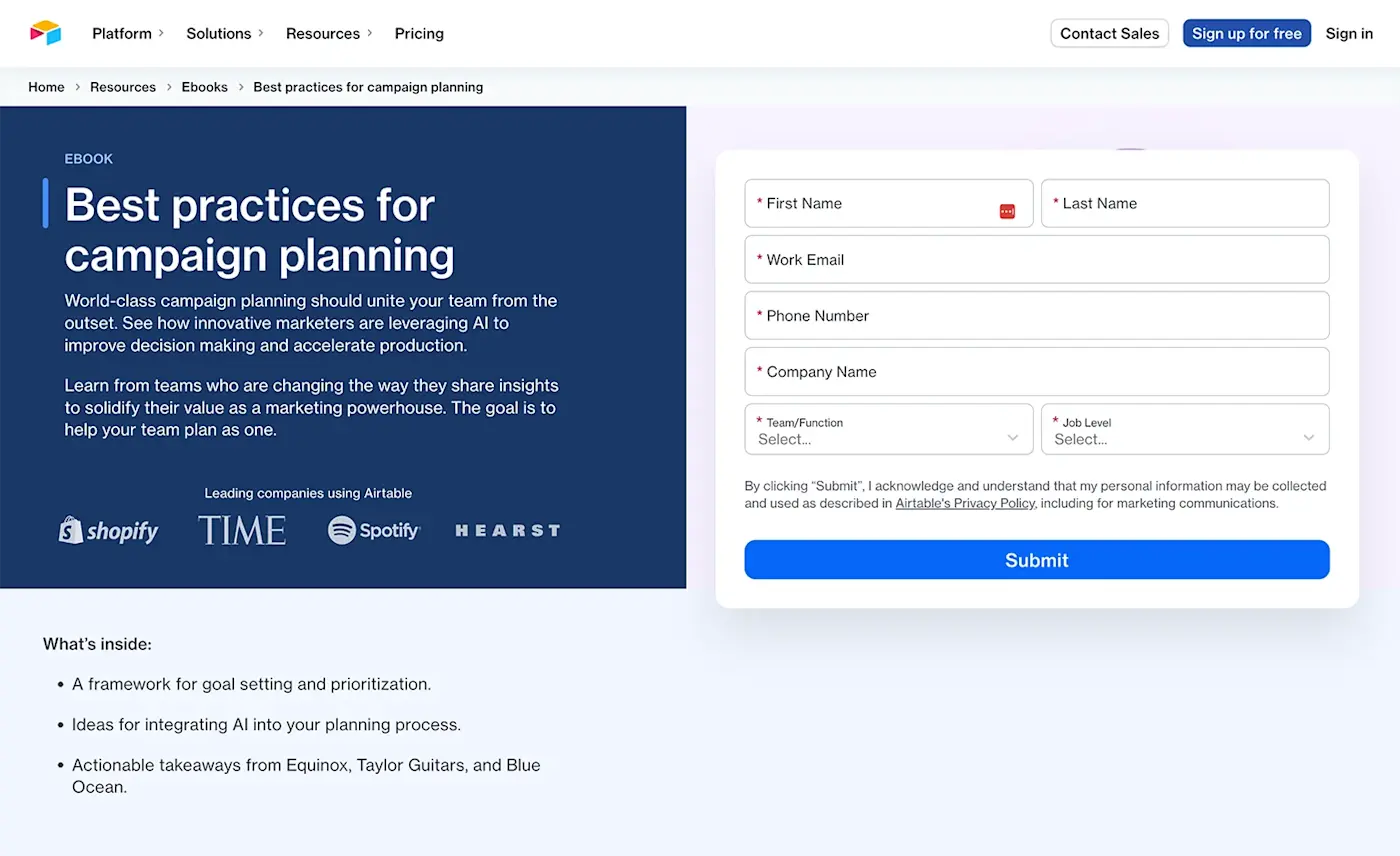
CTA type: Gated content
What it does right: Social proof, sneak preview, clear and concise
You may be wondering why I included a very basic "submit" button in a CTA showcase, but pairing a straightforward button with great supporting elements like the headline, social proof, and sneak preview, is like sipping top-shelf wine from an old jelly jar. Sometimes, the simple stuff just ties everything together.
The large headline is as direct as my comments on whether a hotdog is a sandwich. (It's not.) Aimed at the so-called professionals in campaign planning, it speaks to a certain crowd, much like literally anything speaks to Swifties looking for Taylor's latest Easter egg.
The mention of leading companies like Shopify, Time magazine, Spotify, and Hearst adds credibility and trustworthiness. It's basically saying, "If these giants trust us, maybe you, in your comparatively minuscule existence, should, too."
The bullet list detailing what's inside the eBook provides clarity on the content, letting users know exactly what to expect, including insider tidbits from recognized brands. So, not only do you get smarter, but you also get to casually name-drop at the next girls' night. "I've been implementing campaign planning strategies inspired by Equinox and Taylor Guitars. NBD."
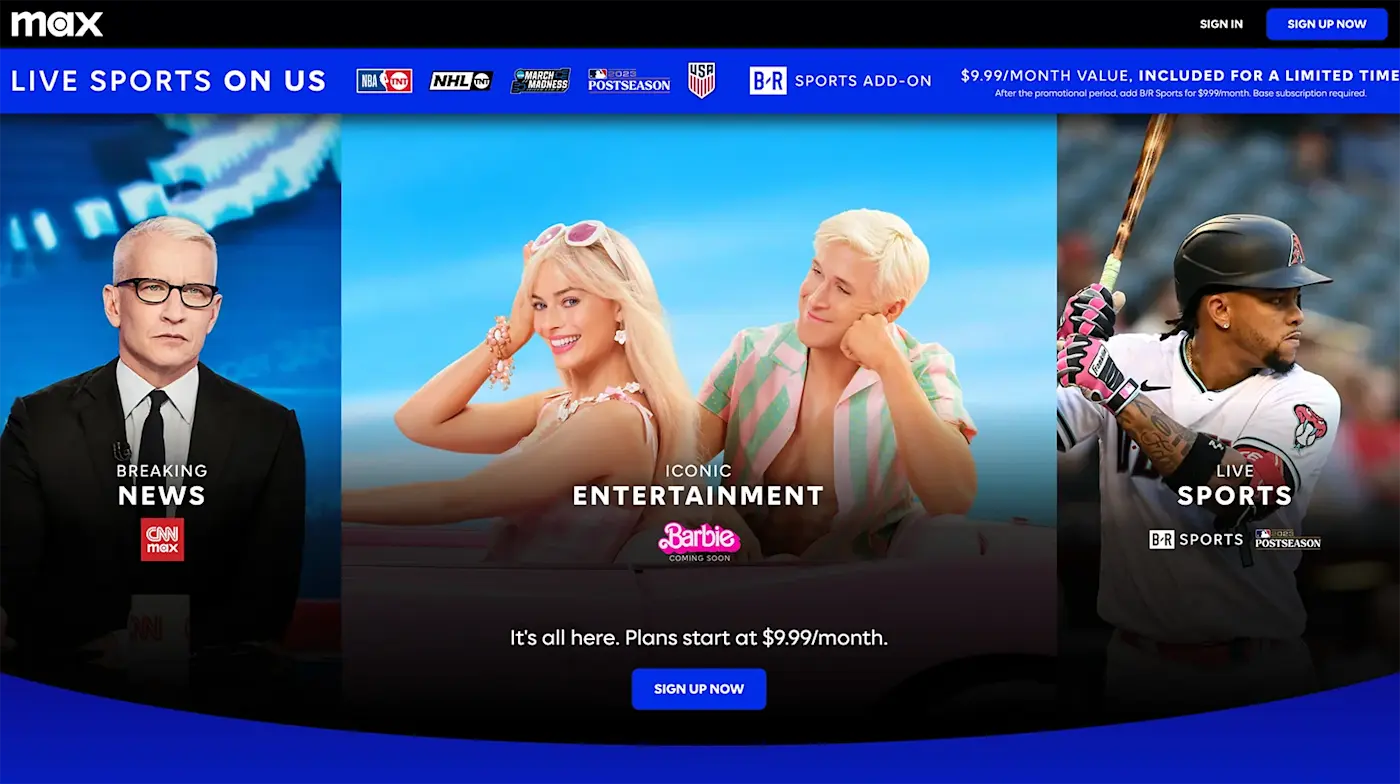
CTA type: Closing the sale
What it does right: Showcases diverse selection, clear and concise, highlights affordability
Max presents an impactful CTA through the Neapolitan ice cream of hero images, featuring Anderson Cooper, Ketel Marte, and Margot Robbie with Ryan Gosling. Collectively, these three flavors depict a panoramic view of Max's offerings, emphasizing a wide variety of choices only rivaled by the Cheesecake Factory menu.
In a world drowning in content, they've managed, quite succinctly, to sum it all up with "It's all here. Plans start at $9.99/month." The ensuing "Sign up now" button invites visitors to subscribe, anchoring the CTA by providing a straightforward pathway to accessing all the consumable content your heart desires.
15. Adobe Stock

CTA placement: Google Search ad
CTA type: Free trial
What it does right: Benefit-oriented, actionable, relevant to the target audience
This paid search ad nails the CTA with a clear and easy-to-understand message. The headline "Free trial - Find the right image faster" immediately grabs attention by offering a low-risk way to experience the service. It also addresses a common pain point for users, highlighting the platform's efficiency.
In very few words, Adobe found a way to combine attention-grabbing language, address user concerns, highlight the platform's strengths, and offer a valuable deal, making for a cleverly crafted CTA. If I were into such things, I might even click on it. But I have people for that.

CTA placement: Email
CTA type: Event promotion
What it does right: Multiple engagement opportunities, attention-grabbing, personalized
Much like the free sample stations at Costco, the strategic placement of three CTA buttons ensures the reader has multiple opportunities to engage, regardless of how far they wander (or scroll).
The header image immediately grabs attention with its vibrant graphic detailing key event highlights. This provides a quick snapshot of what to expect and builds anticipation.
Personalizing the body of the email to address readers by name creates a sense of intimacy. Instantly, they're all ears and feeling special.
Improve your CTAs now, free!
While my dad's approach might have lacked the finesse of a well-designed button or the allure of clever copy, the sentiment was clear. And that's the heart of every good CTA. Whether you're nudging a visitor to make a purchase or nudging your offspring out of the nest, the principle remains the same. CTAs are about engaging your audience, prompting action, and, occasionally, a very pointed reminder to update your LinkedIn profile.
Related reading:
Get productivity tips delivered straight to your inbox
We’ll email you 1-3 times per week—and never share your information.

Allisa Boulette
Based in New England, Allisa is a content marketer and small business owner who hopes to make the internet a more interesting place than she found it. When she’s not working, you can find her lying very still not doing anything.
Related articles

Google Local Services Ads: What they are and how to use them
Google Local Services Ads: What they are and...

14 content marketing examples to get the creative juices flowing
14 content marketing examples to get the...

AI in advertising: Examples, tools, and what to expect next
AI in advertising: Examples, tools, and what...
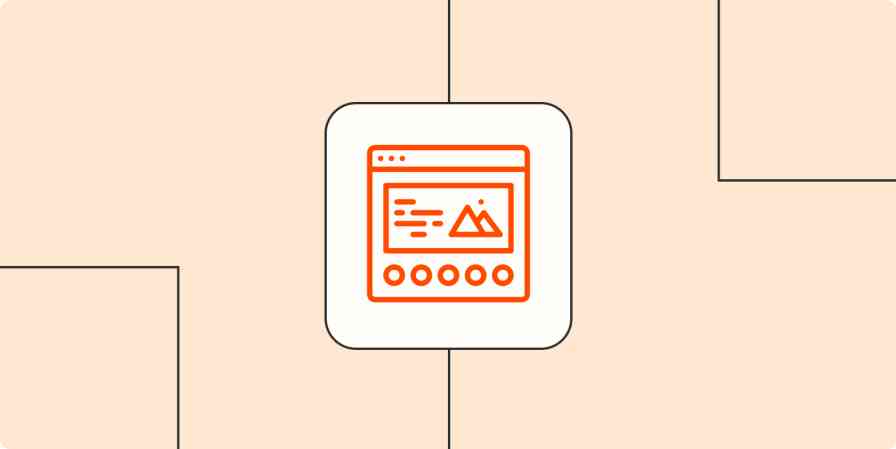
20 landing page examples to help you increase conversions
20 landing page examples to help you...
Improve your productivity automatically. Use Zapier to get your apps working together.

- Writing Tips
How to Write a Call to Action (with Examples)

- By Bethan McGloin
- Aug 13, 2023
Share this article:
If you’re pursuing a career as a content writer or looking to land more freelance clients, you’ll need to understand how to write a call to action.
In this post, we’ll be sharing:
- What a call to action is
- Five tips on writing a call to action
- Three examples of effective calls to action at work
Let’s get started!
What Is a Call to Action?
In content marketing and copywriting, a call to action (often abbreviated to CTA) refers to a short line or phrase that prompts the audience to perform an action.
A call to action might encourage readers to:
- Purchase a product or service
- Visit a web page
- Download an ebook
- Subscribe to a mailing list or newsletter
- Make a lifestyle change
Calls to action can appear anywhere within a piece of content, though they’re usually placed toward the end and often take the form of a button, an image, or a link embedded in the text.
But in order for a call to action to succeed in converting readers , it needs to attract attention and give them a reason for following through.
Read on to discover how you can craft an effective call to action.
How to Write a Call to Action
1. keep context in mind.
First and foremost, keep in mind that the length and style of a call to action will depend on its context.
A call to action within a blog post, for example, will tend to be a sentence or two that follows naturally from the rest of the piece.
On the other hand, emails, product descriptions, or social media ads will rely on a single word or phrase, often presented as a button to click.
So, when writing your call to action, make sure you tailor it to the content it’s part of.
2. Make Use of FOMO
In order to encourage your audience to respond to a call to action, you need to appeal to their emotions.
One of the strongest emotions is fear – specifically, fear of missing out (FOMO) . FOMO can be a powerful tool for converting readers into customers or clients.
You can make use of FOMO by providing a call to action that:
- Emphasizes exclusivity
Sign up now to receive your unique members-only discount.
Click that subscription button for access to top-secret recipes!
- Suggests urgency
Seats are selling out fast – secure yours now!
For the next 24 hours only, receive a free ebook when you sign up.
By appealing to your audience’s emotions, you give them more of a reason to act on your call to action.
3. Propose a Solution to a Problem
Another way to hook an audience with a powerful call to action is by promising solutions and concrete results.
Start by identifying a problem, then make it clear how following through with the call to action will solve that problem.
And don’t forget to include numbers, figures, and other statistics to back up what you’re promising!
Sick of pesky pests and annoying insects? Order the new sound-based repellent and enjoy a bug-free home in just one week!
4. Pick Strong Verbs
The power of a call to action lies in the verbs you choose to use. This is especially true for a shorter call to action, such as a button in an email, where you don’t have as much space to rely on appeals to your audience’s emotions.
Strong, imperative verbs often found in calls to action include:
Pair these verbs with a relevant subject or embellish them with an expressive adverb, and you’ve got a snappy call to action for your audience to follow through on.
5. Provide a Clear Course of Action
In order for your audience to follow through on the action you want them to take, they need to know exactly what that action is and how to do it.
You could write a masterful piece of copy explaining exactly why your readers should subscribe to your newsletter, but that won’t do much good if you don’t tell them how to!
This is where instructions, links, pop-ups, and buttons that allow your readers to easily take the next step are essential.
Three Great Call-to-Action Examples
Now that we’ve discussed how to write an effective call to action, here are three real-world examples to help inspire your own.
1. Converse
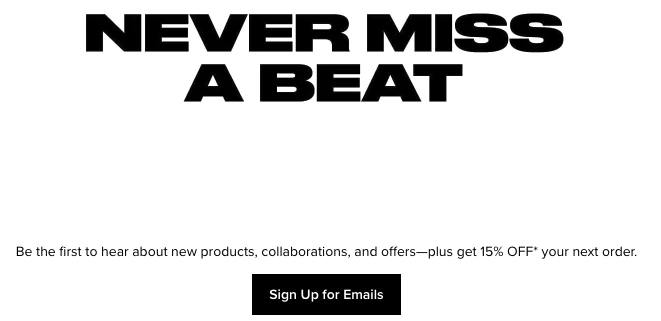
This call to action on the Converse store’s landing page attracts attention with its bold headline, then targets readers’ FOMO with the phrase “be the first to hear.”
If that wasn’t enough, it adds an extra incentive for customers to sign up (with a 15% off deal) and a handy button that opens a pop-up window where you can enter your email address.
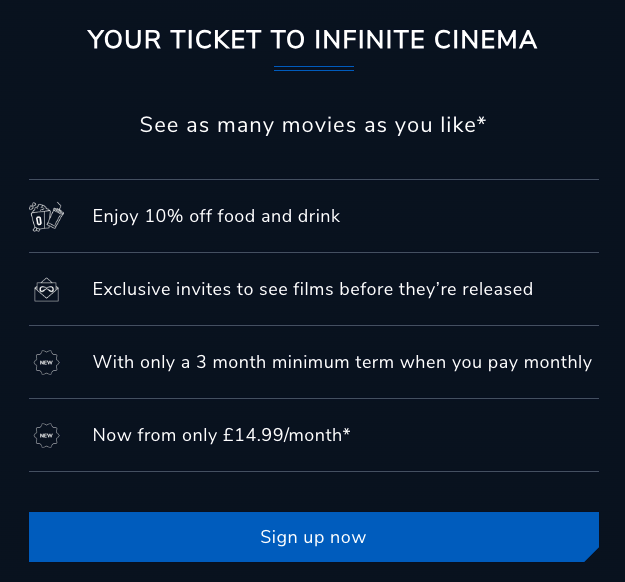
Cinema chain ODEON promotes its myLIMITLESS cinema pass with a call to action listing the many benefits customers can expect for signing up.
Complete with facts and figures, this call to action also highlights “exclusive invites” to appeal to readers’ FOMO.
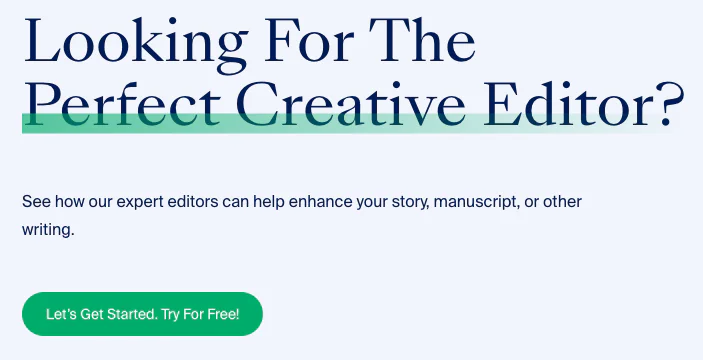
Proofreading and editing provider Proofed demonstrates this call to action on their page for authors .
The targeted headline and copy show they know their audience, while the button takes you directly to their document submission page. The use of the imperative “try” and the promise of a free trial is certain to pique some interest, too!
Becoming A Freelance Writer
Whether you’re a budding copywriter looking to hone your abilities or in the market for a career change, our Becoming A Freelance Writer course will help you gain the confidence and skills you need to thrive as a freelance writer.
Still not convinced? You can try our course for free , no strings attached.
Related posts:

Start your journey
Kick-start a flexible new career, time for a change.
Sign up for a Knowadays free trial – it’s your first step towards a new career.
Leave a Comment
Your email address will not be published.

The Final Touch: Perfecting Your Essay Conclusion for Lasting Impression
So, you’ve finished writing your awesome essay, but you’re wondering, “Do I really need a conclusion?” Well, let me tell you, YES, you do! Trust me, most writers wonder that. Some often ignore the conclusion part altogether. That is a grave mistake, especially when you are trying to make a point through your writing.
1Source: https://pixabay.com/photos/technology-laptop-keyboard-computer-791029/
I know, I know. The entire process of writing it is very tiring. Now again, putting extra effort into it is too much work. Well, don’t worry. Crafting a perfect conclusion might be tricky, but you can always get help with essay writing and learn the craft to do so.
There are various online academic platforms like MyAssignmenHelp.com that provide essay writing help to students whenever they need it. Most students prefer to choose this option while writing a conclusion. Now, you must be wondering what makes the concluding note the talk of the town. See, the conclusion is like the cherry on top of your essay sundae. How? Well, keep reading to find that out –
Summing it Up
Think of your conclusion as a recap of everything you’ve talked about in your essay. It’s more like a chance to remind your reader of the main points you’ve made and why they matter. You’re basically saying, “Hey, remember all that cool stuff I just told you? Here’s why it’s important.”
Leaving a Lasting Impression
Imagine finishing a movie, and it just ends abruptly without any closure. Not cool, right? Well, that’s how your essay would feel without a conclusion. You have to finish well something you have started, right? The concluding note is your chance to make a final impression and leave them nodding their heads like, “Wow, that was insightful!”
Connecting the Dots
Throughout your essay, you’ve been laying down breadcrumbs of information for your reader to follow. Your conclusion is where you bring all those breadcrumbs together and show how they lead to your main point. It’s like connecting the dots to reveal the big picture. Without a conclusion, your essay might feel disjointed and confusing.
Call to Action
Now, this part is crucial. Your conclusion is where you can inspire action in your reader. Whether it’s urging them to think differently, take action, or explore further, your conclusion is your chance to make a lasting impact. You want your reader to finish your essay feeling motivated and ready to tackle the world.
Avoiding the Cliffhanger
Have you ever watched a TV show that ends on a cliffhanger, and you’re left hanging, dying to know what happens next? Yeah, that’s not the vibe you want with your essay. Your conclusion should wrap things up nicely, leaving your reader satisfied and fulfilled. No cliffhangers allowed!
Steps To Long-Lasting Perfection
Now, let us learn how to make it happen.
- Summarize Your Main Points
First things first, you want to give your reader a quick recap of the main points you’ve covered in your essay. Think of it like hitting the highlights reel of a movie. You want to jog their memory and remind them of all the awesome stuff you’ve talked about.
- Reiterate Your Thesis Statement
Your thesis statement is the backbone of your essay—it’s the main idea around which everything else revolves. In your conclusion, you want to bring it back front and center. Remind your reader of your thesis statement and show them how you’ve supported it throughout your essay.
- Provide Closure
Think of your conclusion as the grand finale of a fireworks show. You want to go out with a bang! Tie up any loose ends and bring your essay to a satisfying conclusion to give your reader a sense of closure. You want them to finish reading, feeling like they’ve reached the end of a journey.
- Leave Them Thinking
You don’t want your conclusion to be the end of the conversation – you want it to be the start of something new. Leave your reader with something to ponder. Whether it’s a thought-provoking question, a call to action, or a suggestion for further exploration, give them a reason to keep thinking about your essay long after they’ve finished reading.
- Avoid Introducing New Ideas
One common mistake people make in their conclusions is introducing new ideas that haven’t been discussed earlier in the essay. This can leave your reader feeling confused and wondering where these new ideas came from. Stick to the main points you’ve already covered and resist the temptation to add anything new.
- End with Impact
Last but not least, you want to end your conclusion with a bang. Leave your reader with a powerful quote, a memorable anecdote, or a thought-provoking statement that will stick with them long after they’ve finished reading. You want your conclusion to leave a lasting impression and make your essay unforgettable.
- Reflect on the Significance
Take a moment in your conclusion to reflect on the significance of your topic. Why does it matter? How does it relate to the bigger picture? By highlighting the importance of your essay’s subject matter, you help your reader understand its relevance and impact in the real world.
- Emphasize the Key Takeaways
As you wrap up your essay, emphasize the key takeaways you want your reader to remember. What are the main lessons or insights they should walk away with? By reinforcing these key points, you ensure that your message resonates with your audience and sticks in their minds long after they’ve finished reading.
- Connect to the Introduction
A great way to bring your essay full circle is by connecting your conclusion back to the introduction. Consider revisiting a theme, anecdote, or question that you introduced at the beginning of your essay. This helps create a sense of cohesion and closure, leaving your reader with a satisfying sense of completion.
- Inspire Action or Further Exploration
Finally, use your conclusion to inspire action or encourage further exploration of your topic. Whether advocating for a specific course of action, suggesting areas for future research, or inviting readers to engage with the subject matter in their own lives, give your audience a reason to care and take the next step.
So, now that you know the secret sauce of writing the perfect essay, get on with it. Put these tips into action, and watch your conclusion shine!

Insights Success is an archway that caters to Entrepreneurs’ quench of technology and business updates which are currently ruling the business world.
We are ceaselessly proving the best platform for leading companies, which aids indefinite progress while creating meaningful learning experiences for the visitors and invaluable brand awareness for the clients.
Quick Links
- Advertise With Us
- Privacy Policy
- Terms & Conditions
- Speech Writing
- Delivery Techniques
- PowerPoint & Visuals
- Speaker Habits
- Speaker Resources
Speech Critiques
- Book Reviews
- Browse Articles
- ALL Articles
- Learn About Us
- About Six Minutes
- Meet Our Authors
- Write for Us
- Advertise With Us
5 Keys to End Your Speech with a Great Call-to-Action
Yet many speakers miss a fantastic opportunity with a call-to-action that is wishy-washy, hypothetical, or ill-constructed. Even worse, some speakers omit the call-to-action entirely.
A poor call-to-action undermines the effectiveness of your speech; a great call-to-action stirs your audience to act enthusiastically.
In this article, we reveal the qualities of a strong speech call-to-action which will lead your audience to act.
What is a Speech Call-To-Action?
A speech call-to-action is an explicit appeal to your audience to take a specific action following your speech. A call-to-action is most often made at the conclusion of a persuasive speech.
“ If you have been persuasive and your audience is emotionally invested, the best time for action is now. ”
For example, you might call on your audience to…
- … adopt a new business process
- … sponsor an event
- … attend an event
- … fund a research initiative
- … register to vote
- … join a club
- … train for a marathon
- … read out loud to their children
- … donate money to a charity
- … travel to Saskatchewan
- … buy a fire extinguisher
- … eat more vegetables
- … use public transit
Guidelines for a Strong Speech Call-to-Action
Your call-to-action and your approach to delivering it may vary according to your audience and your speaking style. While there is no rigid formula, there are a number of guidelines which will improve the effectiveness of your call-to-action.
- Make your call-to-action clear and direct.
- Have your audience act quickly.
- Lower barriers to action.
- Focus on benefits for your audience.
- Customize your call-to-action for each person.
1. Make your call-to-action clear and direct.
Don’t hint. Don’t imply. Don’t suggest.
It’s not a whisper-to-think-about- action; it’s a call-to -action.
Use direct language, and eliminate wishy-washy phrases.
- Instead of “Maybe you could think about joining…”, say “Join…”
- Instead of “It would be good to train for…”, say “Train for… “
Don’t assume that your audience will “figure out” what needs to be done. (I have made this mistake in the past and regretted it.) If members of your audience walk out of the room thinking “Wow, this sounds great, but I’m just not sure what to do…”, your call-to-action was not clear enough.
2. Have your audience act quickly.
If you have been persuasive and your audience is emotionally invested, the best time for action is now. The longer it takes to initiate the action, the more likely that your audience will lose motivation.
So, an ideal call-to-action is one which your audience can act on immediately, perhaps even before they leave the room. If this isn’t feasible, then aim for actions which can reasonably be completed (or at least started) within hours or a day or two.
3. Lower barriers to action.
To help your audience act quickly, eliminate as many (trivial or non-trivial) barriers as you can.
For example, ask the following questions about your audience.
- Do they need to sign up? Bring forms and pens and pass them out.
- Do they need to read additional information? Bring handouts, or copies of books, or website references.
- Do they need approval before they can act? Make the first call-to-action to organize the meeting with stakeholders.
- Do they need to pay? Accept as many forms of payment as possible.
A common psychological barrier is the perception that the suggested action is too big or too risky. This is a legitimate concern, and is often best handled by dividing the call-to-action into several small (less risky) actions.
For example, “train for a marathon” may be too large of a call-to-action for a non-runner. A better call-to-action would be to join a running club or train for a shorter race.
4. Focus on benefits for your audience.
“ A poor call-to-action undermines the effectiveness of your speech; a great call-to-action stirs your audience to act enthusiastically. ”
Always frame your call-to-action in the audience’s best interest.
For example, don’t say this:
- What I’d really like you to do is…
- It would make me so happy if you…
- My foundation has set a target of X that we can reach with your help…
Making you (the speaker) happy is (probably) not highly motivating for your audience.
Instead, say this:
- Build your financial wealth by…
- Make your community a safer place to live for yourself and your children by…
- When you volunteer, you build your skills and gain valuable experience…
Surround the call-to-action with a description of how their lives will be improved when they act. Paint a prosperous vision.
5. Customize your call-to-action for each person.
Audiences don’t act; individuals act. Rather than addressing the group as a whole, focus your call-to-action on each individual in your audience.
Suppose your goal is to have a new business process adopted. Each individual in the room may play a different role in accomplishing this.
- For the person who controls the budget, the call-to-action is to allocate the necessary funds.
- For the personnel manager, the call-to-action is to delegate staff to work on the initiative.
- For others, the call-to-action may be to attend in-depth training about the new process.
Audience analysis is critical . If you know who is in your audience, and understand their motivations and capabilities, you will be able to personalize the call-to-action for them.
Put it into Practice
By working on the planning and execution of the call-to-action in your speeches, you’ll become a more persuasive and effective speaker.
Look back to your last persuasive speech.
- Did you make a clear and direct call-to-action?
- Was your audience able to act quickly on it?
- Did you make an extra effort to lower barriers to action?
- Did you highlight the benefits for your audience?
- Did you address individuals rather than the group with a personal call-to-action?
If the answer to any of the above questions was “no”, then how could your call-to-action have been improved?
Please share this...
This is one of many public speaking articles featured on Six Minutes . Subscribe to Six Minutes for free to receive future articles.
Image credit: Megaphone man at the Metro 4 by Hazzat ( CC BY 2.0 )
Add a Comment Cancel reply
E-Mail (hidden)
Subscribe - It's Free!
| Follow Us |
Similar Articles You May Like...
- 10 Ways to End Your Speech with a Bang
- The Ladder of Abstraction and the Public Speaker
- Speech Critique: Dan Pink (TED 2009)
- Bookending Your Speech: A Master Technique
- Speech Analysis: Gettysburg Address – Abraham Lincoln
- Presentation Power: Four Ways to Persuade
Find More Articles Tagged:
11 comments.
This is a great article. I found in it very useful tactics. thanks a lot.
Brilliant!… can’t wait to put into action. thank you
I really like your tips #3 & 4 about focusing on audience benefits and lowering barriers to action.
Not sure how the tip about personalising the call-to-action should work though. Might you have (say) 3 calls to action if there are 3 decision-makers in the audience?
Very useful to my line of work. Thanks. Keep it up
What would be a good call to action for drug abuse?
Thank you, I found this very helpful in some situations. I definitely recommend this.
My teacher sent me here It really helped. Thank you for taking your precious time to make something to help others even though you didn’t have to. It is very much appreciated
Thank you soooo much it really helped me on my essay for school thank you so much .😊😊😊
I am working on reframing a call to action for a speech THANK YOU for the help ahead of time
How do you write a call-to-action about global warming?
I appreciate your six minute articles Thank you
Recent Tweets
5 Keys to End Your Speech with a Great Call-to-Action https://t.co/a8rputDpUk by @6minutes — @red_suraj Nov 6th, 2017
“A poor call-to-action undermines the effectiveness of your speech; a great call-to-action stirs your audience to a… https://t.co/VbYz3VcxvH — @ToppComm Jul 3rd, 2018
Ending a speech in a meaningful, impactful way is CHALLENGING! Luckily, we have helpful guidelines from @6minutes o… https://t.co/3z46iJn6Os — @speakupcamb Aug 7th, 2018
5 Keys to End Your Speech with a Great Call-to-Action https://t.co/8E7KimKeRE by @6minutes — Mel Sherwood – Pitch & Presentation Specialist (@MelSherwood_) Sep 7th, 2018
5 Keys to End Your Speech with a Great Call-to-Action https://t.co/vkMpPLLHwK by @6minutes — Marcie Hill (@Marcie_Hill) Sep 17th, 2018
5 Keys to End Your Speech with a Great Call-to-Action https://t.co/W8ctelzMPc — @surajd_ Oct 25th, 2018
As a #publicspeaker, you want to see your listeners taking action because of you. To help your audience take action… https://t.co/d4Vf5nSgtS — @GregoryCNSmith Nov 14th, 2018
What is a Speech Call-To-Action? In this article, we reveal the qualities of a strong speech call-to-action which w… https://t.co/nrUtrhIzPS — Free You Up VA (@freeyouupva) Dec 29th, 2018
As Toastmasters, or public speakers, we are usually trying to persuade our audience to take action. Check out his… https://t.co/Tf9LF5ocKj — IS Toastmasters 1424 (@istm1424) Mar 4th, 2019
“Surround the call-to-action with a description of how their lives will be improved when they act. Paint a prospero… https://t.co/ZPGExX28nM — Oke’ Toastmasters (@oketoast) Mar 4th, 2019
Featured Articles
- Majora Carter (TED, 2006) Energy, Passion, Speaking Rate
- Hans Rosling (TED, 2006) 6 Techniques to Present Data
- J.A. Gamache (Toastmasters, 2007) Gestures, Prop, Writing
- Steve Jobs (Stanford, 2005) Figures of speech, rule of three
- Al Gore (TED, 2006) Humor, audience interaction
- Dick Hardt (OSCON, 2005) Lessig Method of Presentation
Books We Recommend
| [ ] | [ ] | [ ] |
| [ ] | [ ] | [ ] |
| [ ] | [ ] | [ ] |
| Follow Six Minutes |
Six Minutes Copyright © 2007-2022 All Rights Reserved.
Read our permissions policy , privacy policy , or disclosure policy .
Comments? Questions? Contact us .
7 Call to Action Examples You Have Never Seen Before
At great risk to my sanity, I went online with the intention of finding as much advertising as I could.
The goal: to find call to action examples (CTAs) that were fresh, original, unique, and compelling.
My discovery: Almost everyone is using generic CTAs. Safe, boring, and forgettable. The 7 innovative call to action examples I found made those brands stand out immediately.
Your opportunity: By changing 2-3 words of a call to action, brands can stand out in a small way from the hopelessly ordinary competition.
Less than 0.00001% of CTAs Are Unique
This is not a scientific number. I came up with it out of spite after an exhausting search.
Refresh the examples in a listicle about calls to action, my editor said.
I thought this was going to be easy.
It was a nightmare.
Websites for brands large and small were universally boring in terms of calls to action. The most tantalizing offer I could find was usually “Free Trial”, which brought me to a page with miles of fine print.
I thought maybe the aggressive pay-per-click advertisers would put together some compelling calls to action. Nope. The name of the game there is using every conversion hack at once.
Here’s a typically boring call to action example that most people are using :

I think this offer hits every cliche tactic: the ticking clock, a warning emoji about sell-out risk, money-back guarantee, a steep discount, etc.
Then I tried social media, which was even worse. Facebook gave me nothing in the way of an inventive CTA. Absolutely nothing.
I checked Reddit–as always, a wonderful place, just not for buying things.
On X (fka: Twitter), I was hoping to find some good scammy infoproducts, maybe some clever hardsells. But I was disappointed. I could have made a full quilt that spelled out “unoriginal” with all the thread emojis inviting me to click and read a tweet-storm. Here’s why that trend is played out: 🧵/23
My wife told me that TikTok has been ruined by advertisers and influencers–so I was really excited about that. This is where the real ingenuity must be.
Nope. It’s a simple SHOP button that overlays influencer videos. That’s it.
But in the end, I prevailed. I found 7 examples of brands actually trying something new with their call to action. They used this small detail to support their brand image or speak to their audience.
7 Truly Unique Call to Action Examples
1. cloudflare.

“Under attack?”
That is a viable button you can click on Cloudflare’s site.
I love it.
Cloudflare has positioned themselves as a cybersecurity version of calling 911 when there’s an intruder in your house. And they did it using two words, a question mark, and a construction-zone orange button in the navbar.
I assume the majority of people who click that button are like me: not currently under attack, but curious about what the next steps would be if they were.
I wanted to learn more because of the clever call to action. If the button had said Learn More, I never would have clicked it.
2. Backcountry

The online outdoor retailer Backcountry hires the people who stay up around the fire fighting about which hiking stove weighs less. You know the type: Gearheads.
This is a huge selling point for Backcountry. When people buy kayaks, avalanche beacons, and so on, they really want to know that this gear works.
Call a Gearhead. Text a Gearhead. These are creative, on-brand calls to action nested in a familiar dropdown menu.
You have a question about climbing rope? Now you are talking with a woman who climbs 3 times a week.
3. LINGs CARS.com

This is actually a fairly tame example of the calls to action on LINGsCARS.com , one of the most successful car leasing services in the UK.
Ling broke every rule of web design to bring us this masterpiece. I know neons are in right now, but most people aren’t using all of the neons, at once, with a paisley background.
CrazyEgg will lock me out of WordPress if I actually recommend a call to action that includes three Order Now buttons that blink at random intervals. So I am not going to do that.
I will say with 100% certainty, however, that I have never seen call to action examples quite like this ever before.
4. Niki Whittle

Niki Whittle is an online personal stylist who has helped thousands of clients find joy instead of anxiety at the prospect of getting dressed and going out into the world.
The text of her CTA button speaks directly to that goal: Help me enjoy getting dressed!
If you swapped out Niki’s personalized text for a basic “Find Out More” button, I think the call to action would suffer.
Her choice of text is intimate. No adult is going to ask for help getting dressed unless they fully trust the other party to understand where they are coming from. The way that Niki has framed the call to action shows that she understands.

Due to California regulations, the beverage brand Ceria couldn’t exactly say what their new product was. With the help of the marketing agency Mother, Ceria found a clever way to get their audience to connect.
The call to action they used was a Spotify playlist people could download by scanning a barcode styled like the familiar Spotify audio waveform.
There’s a cool story behind this ad campaign, which appeared online and in-print in California.
I’m not going to rehash it here because you should go visit the site of the people who did the work , not hear about it third-hand, looking at screenshots I took while I was way behind schedule writing this post.

6. AllTrails

Have you ever seen a limited time offer that isn’t pushy?
AllTrails nails it with this email they sent me. If I go outside, this weekend only , they’ll plant a tree on my behalf.
It’s a positive push, encouraging me to do something for my health, and it won’t cost me a dime. Until AllTrails called me to action, I just had weekend plans. Now I am saving the forest.
The invitation to “Join In” isn’t super original, I know, even with those cute little tree icons.
But the call to action is social. It’s not “Register” or “Find out more”, it’s about connecting with other people. AllTrails has 50 million users. This is a real community, and AllTrails is smart to frame it that way.
7. Avocado Green Mattress

Avocado Green Mattress has upcycled bedroom furniture people can buy to complement their organic mattresses.
The call to action is “Shop Zero Waste” is a clear call to the type of buyer who is willing to pay a premium to minimize their impact on the environment. “Shop” would work, but it doesn’t highlight the key selling point of their furniture.
It’s a small detail, but most people buying online have 5-7 tabs open. I know I do. With buyers scanning all these different sites, I think it makes sense to foreground your unique features in the button text.
More Call To Action Examples
Here are some twists on classic calls to action. I can’t say I’d never seen these types of tactics before, but the following examples are well done.
The call to action text speaks to the audience, aligns with the brand image, or is simply more inviting than a generic “Try Now” button.
Kati Curtis Design

Kati Curtis Design opted for a slight variation on the Get In Touch call to action by including her name.
I’m not going to belabor the point about what’s going on here, but this slight personalization will absolutely stand out.
I think this is a good idea if you are the face of your business as opposed to a brand. “Get In Touch With The Owner” could work, too.

Havenly is an online interior design service company. I liked the invitation for customers to “Find Their Style.”
They could have stuck with “Learn More” or “Book a Consultation,” but those aren’t personal at all. Those are also fairly passive calls to action, versus “Find Your Style,” which is much more active.

Birchbox , the popular cosmetics subscription box opted to use an invitation style call to action:
“Build Your Box”
It’s intuitive, on-brand, and crisp.
One issue people have with subscription services is that they get products they don’t want. With this short call to action, Birchbox is countering that objection by offering their customers an active role in building their own box.
Art & Logic

Art & Logic is a software development company with an approachable call to action.
Yes, they decided to go with “Let’s talk about your project” instead of something sterile or gimmicky.
Building custom business software is insanely complex, but Art & Logic makes the next steps as easy as possible.
Make your website better. Instantly.
Keep reading about copywriting.

How To Balance Deep Copywriting Research With a Deadline
All the words you see on product packaging, the marketing emails you receive, the websites you browse, and even the advertisements delivered to your mailbox…

Most Copywriting Tips are Vague and Generic–Not These 9
Great copywriters aren’t born, they’re made. In fact, you don’t even have to be a great writer to nail the copywriting thing. You just need…

Everything I Know About Copywriting After Making $500K
$500K? Lucky, the disbeliever will say. You just got lucky with your words. Maybe. But most copywriters aren’t counting on luck or magic to put…

At great risk to my sanity, I went online with the intention of finding as much advertising as I could. The goal: to find call…
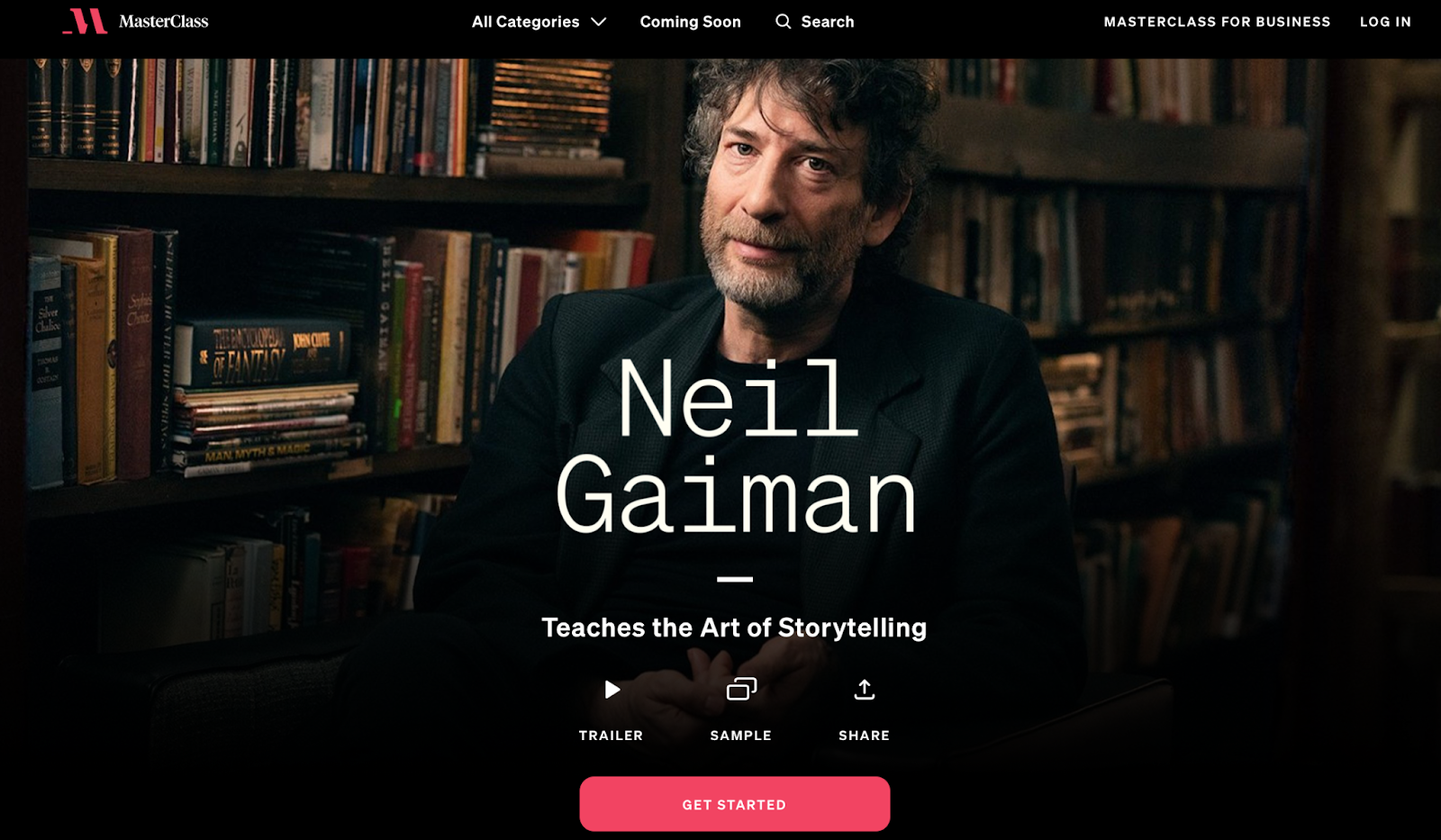
Best Creative Writing Courses Compared
Taking a creative writing course will help you to become a better writer. It will teach you how to tell a story, write descriptively, and…

How to Create Winning Headlines in 9 Simple Steps
In any ad, everything depends on the headline. It’s why some copywriters are known to spend 50% of their time on just the headline. As…

The Five Sales Letters Every Marketer Should Know, Hands Down
If you want your visitors to buy, instead of bouncing off your site like a basketball… Ask yourself: What’s missing from my funnel? What’s missing…

15 Habits of Website Visitors That Will Completely Change the Way You Write Website Content
For the most part, website visitors are quite predictable. This gives you, a business owner, a huge advantage. Why? Psychology!

The Biggest Lie in Copywriting
I am an artist. Or at least that’s what 90% of the people I speak to think when I tell them what it is I…

How To Increase Your Landing Page Conversions by Asking a Question
It’s believed that it takes users (who have no idea of what your site does) exactly three seconds to orient themselves and make up their…

Copywriting For Social Media Ads: It’s Not What You Say, It’s How You Say It
Many might say that social media ads are interruption advertising in a modern form. However, there is definitely something less abrasive about a sponsored tweet…

16 Helpful Copywriting Articles To Launch You Into Web Writing Greatness
We all need a little help… from time to time. Actually, as online copywriters striving for greatness, we need all the help we can get….

62 Power Words That Will Help You Sell
Have you ever read a landing page, sales letter or even blog post which has unequivocally sold you on a product? The type of content…

How to Become a Better Copywriter: 21 Tips from the Experts
Want to get better results from your web pages? Then you have to get the copy right. Whether you’re writing landing page copy or tweaking…

How To Increase Conversions By Forgetting The CTA
Your target customer has zero interest in your CTA. He/she doesn’t particularly care about the call, the signup, or even the purchase. He/she isn’t really…
Over 300,000 websites use Crazy Egg to improve what's working, fix what isn't and test new ideas.
Last Updated on July 27, 2017

Nice to meet you.
Enter your email to receive our weekly G2 Tea newsletter with the hottest marketing news, trends, and expert opinions.
15 Great Call to Action Examples That Simply Work
May 18, 2021
by Nathan Ojaokomo

- Why create a call to action?
Best practices for creating CTAs that work
- 15 call-to-action examples to draw inspiration from
Your ability to write ads, landing pages, or emails that make readers take action – whether it’s to buy something, download an eBook, join your email list, or something else – is one of the keys to becoming a successful marketer.
While it’s one thing to write headlines or introductions that hook a reader, it’s an entirely different ball game to make these readers take action after reading your copy. To make your audience or readers take action, you need to pay more than the usual attention to creating a compelling call to action (CTA) .
We’re going to share real-life examples of CTAs you can use to improve your conversions and grow your business. You’ll also learn why you need a strong call to action and how to write CTAs that work.
A call to action is used to prompt an audience to take a specific action.
When you think about the last time you downloaded an eBook, enrolled for an email course, or signed up for a software’s free trial, you will discover that a CTA was the final nudge that made you take action.
Common examples of CTAs you can find on websites, landing pages, emails, and ads are “Buy now,” “Subscribe,” “Sign Up,” and “Learn More”. These CTAs serve as a bridge between your audience and conversion.
Why should you create a strong call to action?
Many marketers make the mistake of thinking that CTAs are not necessary, especially since a call to action only takes up a small part of their website, email, or landing page. They also imagine that slapping common CTA examples like “Buy Now” or “Subscribe” on their copy would convert well for them.
But the truth is that your conversions would tank if you don’t create strong CTAs. Why? The average daily time spent on social media in 2020 was 145 minutes compared to only 111 minutes in 2015 – meaning people now consume more content than ever before. As a marketer, this means you’re literally in direct competition for people’s attention against Zoom calls, TikTok, Netflix, Instagram, and other social platforms.
In a world where attention spans are lower because of the many content and information channels available today, you’d be doing a disservice to your readers if you don’t use strong CTAs. A good CTA should grab people’s attention , make them notice what they stand to gain, and prompt them to take action.
So how can you create a strong call to action? First, you need to set the right foundation.
Before you write a CTA
No builder sets out to build a house without having a plan or laying the foundation. Similarly, you need to set the foundation for your CTAs before you begin writing.
Here are two questions that can help you lay the groundwork:
- What is your goal?
- Who is your audience?
What is your goal?
When writing CTAs, start with an end goal in mind. What action do you want your audience to take? Do you want them to sign up for your newsletter? Book a demo? Buy your products?
Whatever the goal is, it should be specific and straightforward. Don’t bombard your audience with too many options at once. Offering several choices confuses the audience and hurts your conversion rate opportunity.
Who is your audience?
Knowing your audience goes deeper than creating a random “Marketing Mary” persona. You need to understand your audience’s fears and desires well. Once you’ve identified who your audience is and what you want them to do, it’s time to start writing your CTA.
While there are no set or rigid rules when creating CTAs, a few principles can help you write strong CTAs. These principles work whether you’re writing a call to action for your websites, ads, social media captions, or emails.
Keep your CTA above the fold
A fold is the part of your website that visitors see before they start scrolling.
It’d be a waste of website real estate to hide your call to action in a place other than the first part of your website that visitors see. You can still use images, logos, and other graphics along with your CTA above the fold.
Don’t just tell people to do something
In 1978, Harvard professor Ellen Langer carried out a study that showed the power of using the word “because” . The study was conducted in front of a busy copy machine on the Harvard College campus.
Participants were asked to try to skip the queue using three different pitches:
- “Excuse me. I have five pages. May I use the xerox machine?”
- “Excuse me. I have five pages. May I use the xerox machine because I’m in a rush?”
- “Excuse me. I have five pages. May I use the xerox machine because I have to make copies?”
The results?
The first statement without “because” got a 60% favorable response. But that response was dwarfed by the 94% and 93% favorable responses from the other two pitches that used “because”.
Instead of just telling people to do something, tell them why they should do it.
Use a call to value instead of a call to action
Like telling your audience why they should do something, a call to value helps hammer on the benefits your audience can get from taking a particular action. Don’t say “Shop now” when you could say “Shop now and get 30% off of your order.”
Create a sense of urgency
Remember how you always rushed your assignment the night before you had to submit it? Without a submission deadline, you probably wouldn’t have completed as many assignments as you did in high school. The same thing happens with your marketing messages.
Without a sense of urgency, your audience would most likely not take any form of action. To create a sense of urgency, you can use phrases like “limited offer,” “now,” “XXX seats left” in your CTAs.
Your CTA should also make your audience fear that they’ll miss out on something if they don’t act quickly.
Strike a balance between creativity and simplicity
Don’t try to be too smart or witty by using phrases or words your audience doesn’t know. Nobody is going to hand you a medal for lacing your call to action and messaging with big words. Instead, use words, phrases, and terms that your audience uses in their daily conversations.
Use power words and phrases
A compelling call to action uses powerful words and phrases. Here’s a list of powerful words and phrases you can use in your CTA:
- Deadline
- Freebie
- On-demand
- Seize
- Try for free
- Start your free trial
Adjust CTAs to different devices
The way your call to action appears on a mobile phone differs from how it appears on a desktop. Make sure you optimize your CTA buttons to match the different devices your audience uses.
Employ social proof
Social proof, no matter how small, goes a long way into making your CTAs work. In a world where everyone claims to be the best, social proof helps your audience see that you’re not the one tooting your horn.
Social proof could be in the form of big company or client logos, star ratings from review sites, testimonials from customers, or some stats like the number of email subscribers you have.
Consider your CTA length
No rule book says that your CTA needs to be a specific length. The length of your call to action often depends on your offer and understanding of your audience. So don’t sweat it. Besides, you can always test which length works best for you.
Always keep testing
One exciting thing about CTAs is that you can test almost everything about them to see what works. You can test your call to action’s copy, button, button size, placement, and even the colors using an effective CTA conversion strategy .
15 call-to-action examples to draw inspiration from
You don’t always have to start from scratch or reinvent the wheel when creating a call to action. Here are some CTA examples that can inspire you, spanning across website, email, landing page, and ad CTA examples.
1. Get a free savings assessment
Even though G2’s homepage has a couple of good CTAs, the one on the header navigation bar stands out for many reasons.

First, it catches the eye immediately because its color scheme contrasts with the background and the rest of the page. It also contains the word “Free,” a word everyone loves to hear.
The use of figures and a clear benefit in the “Reduce your software costs by 18% overnight” line also makes clicking the CTA a no-brainer.
2. Start a 7-day trial for $7
Customers want to know what they’ll be getting before they click anything on your site. Ahrefs could have conveniently made their CTA read “Start a 7-day trial” without mentioning the $7 part.

While this can cause more visitors to click on the CTA, only a small percentage of them would proceed after hitting a paywall. If your audience has to pay before using your tool, clarify it in the call to action.
3. Learn more
“Learn more” is one of the most common CTAs on websites. While it may not work for everyone, it works well for Apple...well, because they’re Apple. Since they’re already on top of their audiences’ minds, Apple doesn’t need to say much to move people to action.
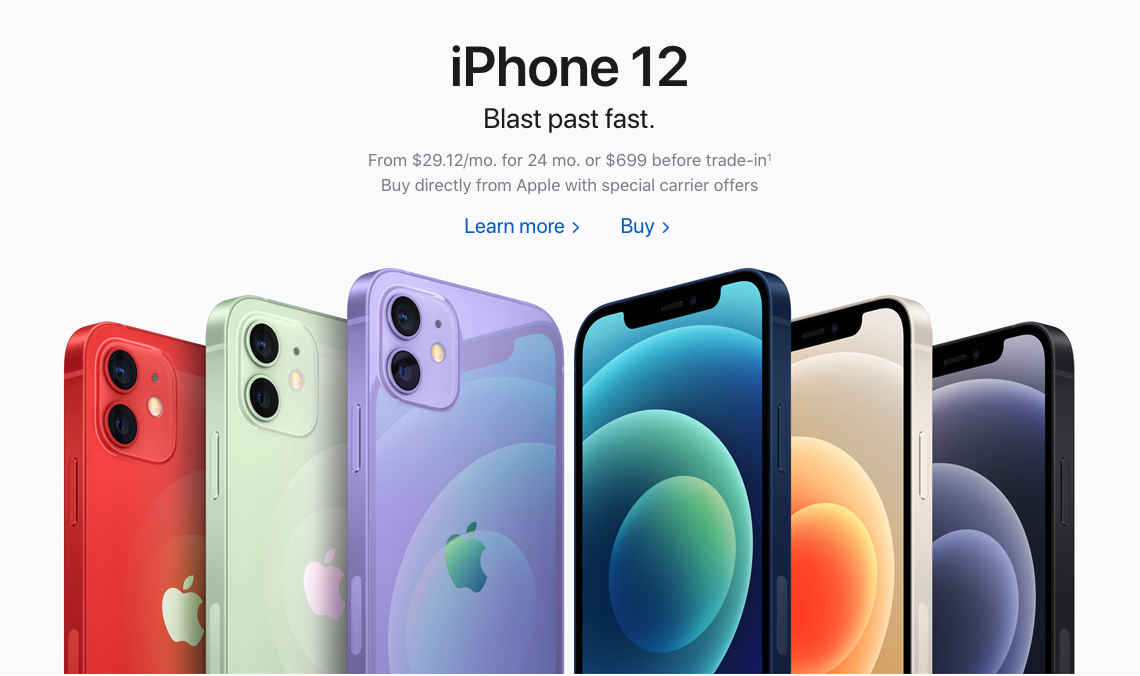
You’d also notice that although the call to action isn’t a button, it’s still easily identifiable because its color differs from the rest of the text.
4. Plant now
Click A Tree’s website design looks clean and on-brand. The image choice clearly shows what the organization is all about. The use of brown (earth) and green (leaves) as their colors also points to the organization’s mission to plant more trees.
All these elements combine to make the “Plant now” CTA work. “Now” also creates a sense of urgency.
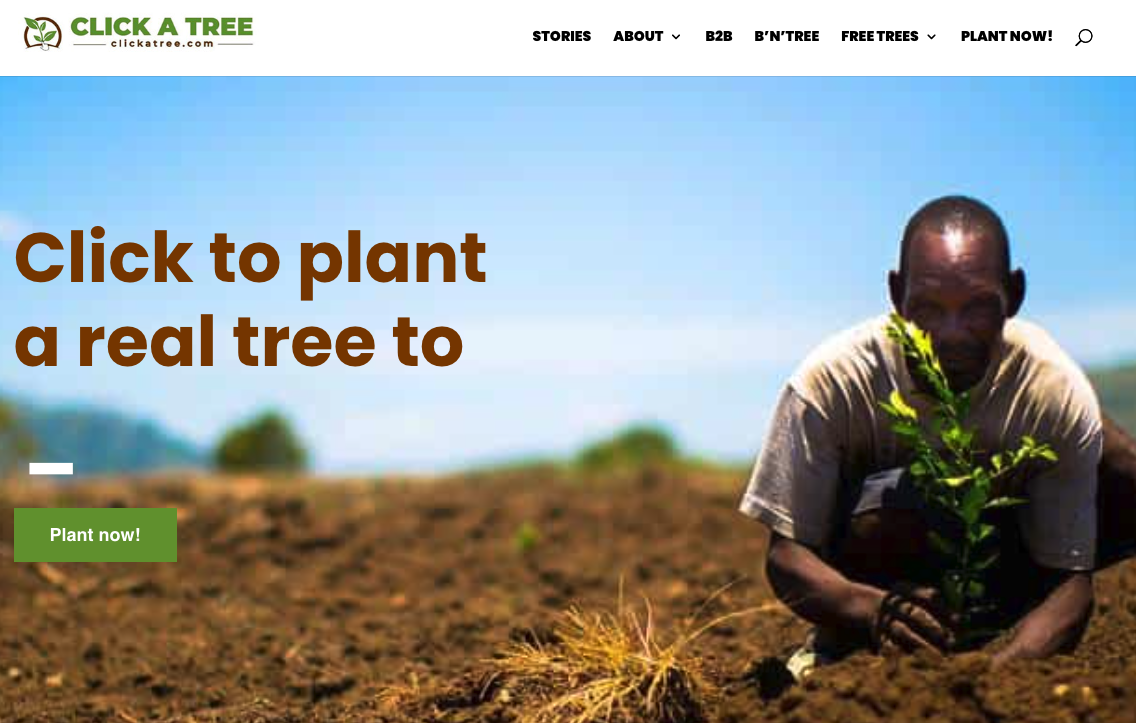
5. Get started – it’s free
Many company websites, especially SaaS companies, use the “Get started” CTA. However, Webflow takes it a step further by adding “ it’s free” at the end of their CTA.
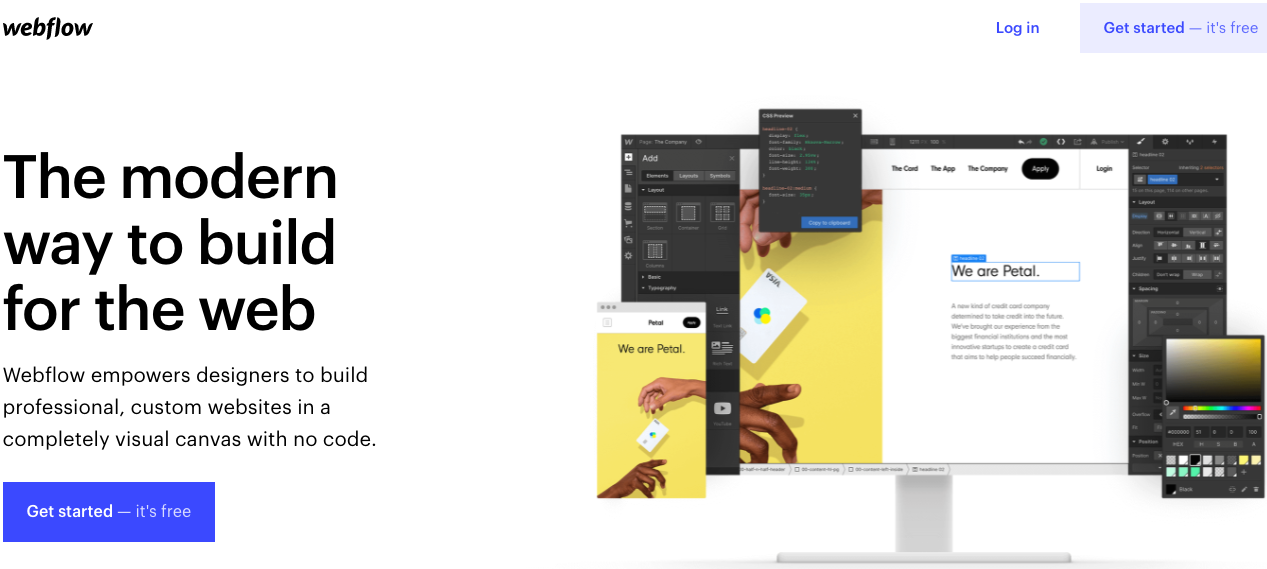
This little addition helps resolve some objections around pricing that may come up in a visitor’s mind.
6. See how addictive email can be
Over the years, Tarzan Kay has built a successful business through email marketing. And with her website headline, she shows visitors what they would get when they click the CTA button.
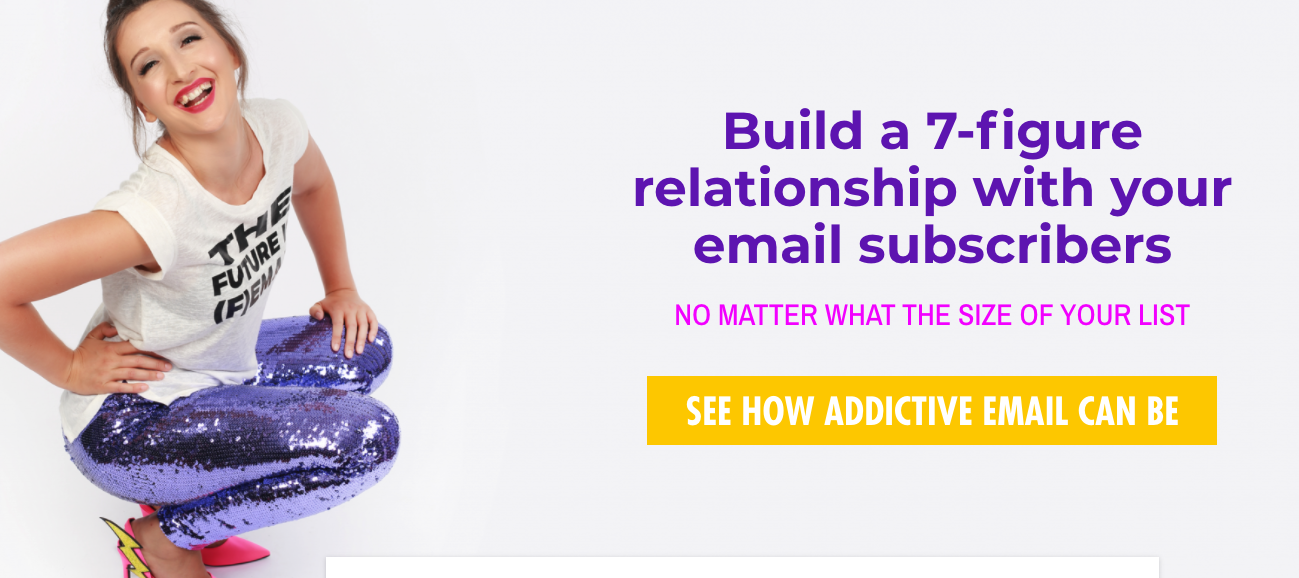
Yes, that giant CTA button. Although the button is hard to miss, it’s not pushy or salesy. Instead, it gives visitors the feeling that they would be gaining front seat rows to see how email marketing can work for them.
7. Get 30 days free
Want to know what’s better than getting a week-long free trial? Getting 30 days free.
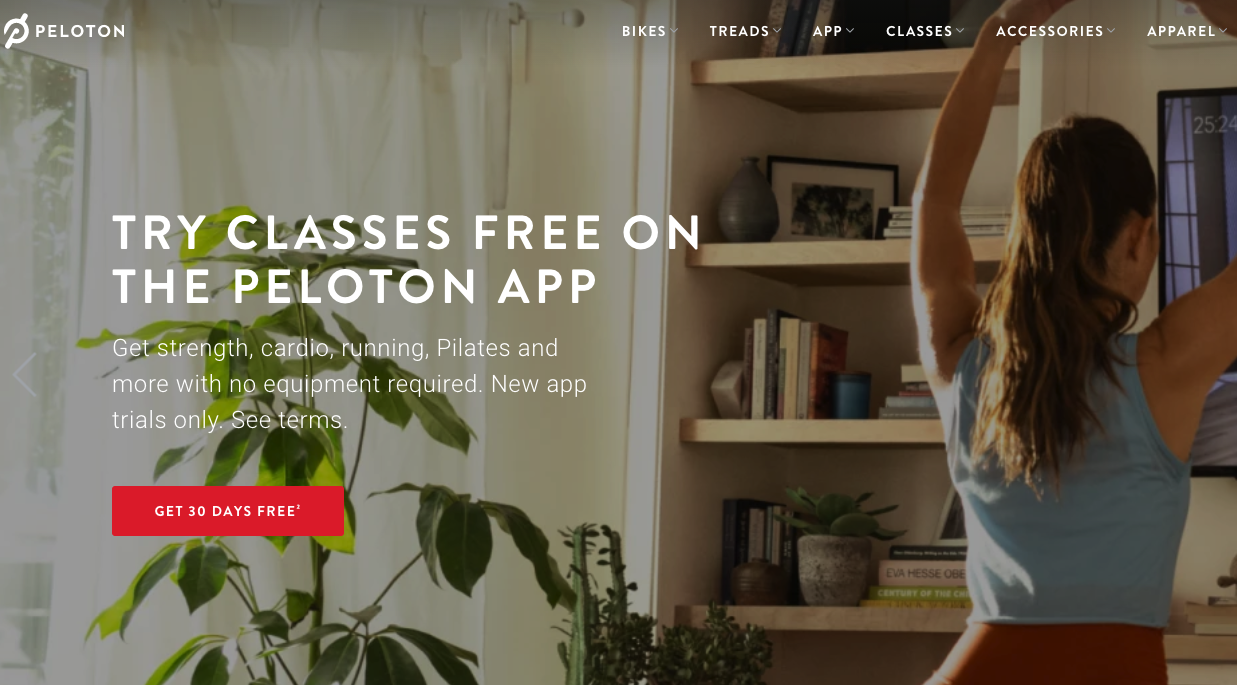
Peloton uses the “Get 30 days free” CTA to attract and convert visitors who want to get fit. This CTA is excellent because 30 days is more than enough time for a person to tell whether Peleton’s program is working for them or not.
8. Start winning more
It’s not only in your homepage headline that you can highlight your products or services’ most significant benefits. You can and should use these benefits in your call-to-action copy too. Winning is something anyone who plays games wants to achieve. And Metafy here brilliantly highlights this with their “Start winning more” CTA.
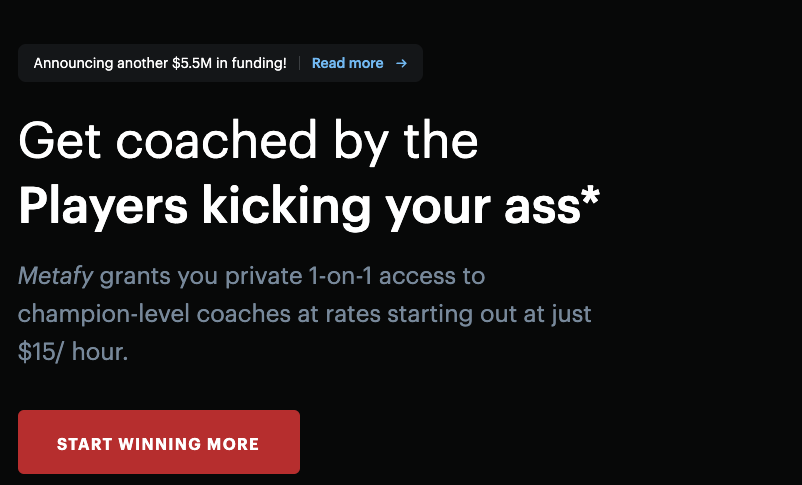
9. Schedule your free strategy session
Like we mentioned earlier, knowing your audience is vital to writing strong CTAs. Here, Pedro clearly defines that he serves SaaS companies that have trouble converting visitors into customers.
SaaS business owners know that a small percentage change (say 5% uptick) in their conversions can blow their revenue out of the water. Pedro knows this too, and that’s why his CTA offering a free strategy session (emphasis on free) looks like a steal.
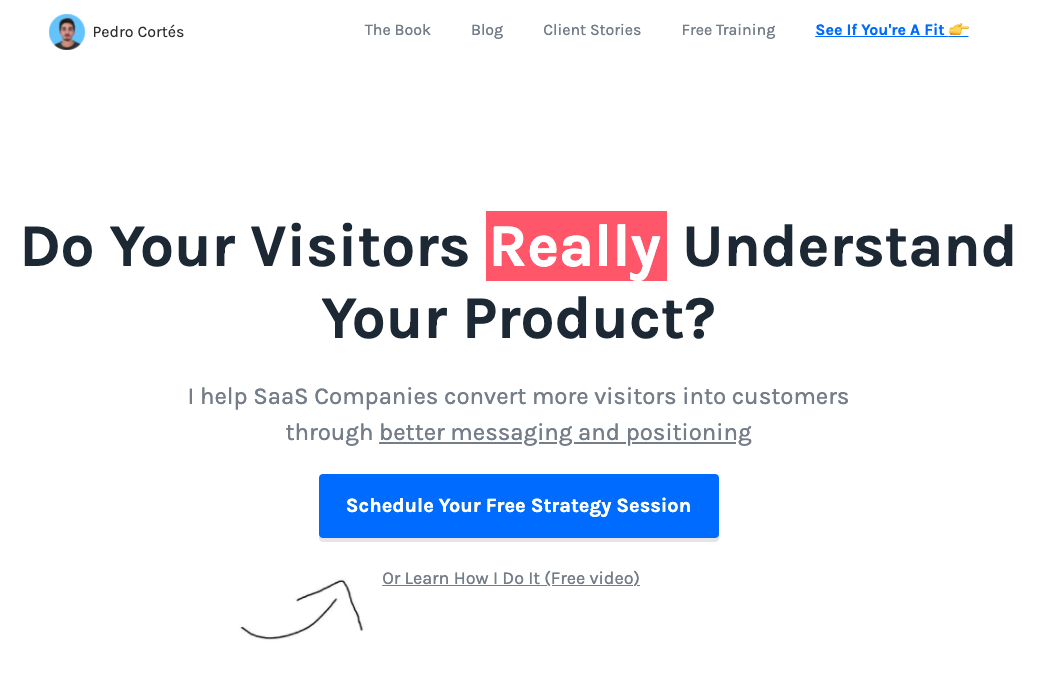
10. Subscribe to our newsletter
Let’s start with the classic “Subscribe to our newsletter”.
Although many companies have email sign-up boxes that use this CTA, these companies often offer zero motivation to make their audience actually subscribe. Really Good Emails gives their visitors compelling reasons why they should subscribe to their email list.
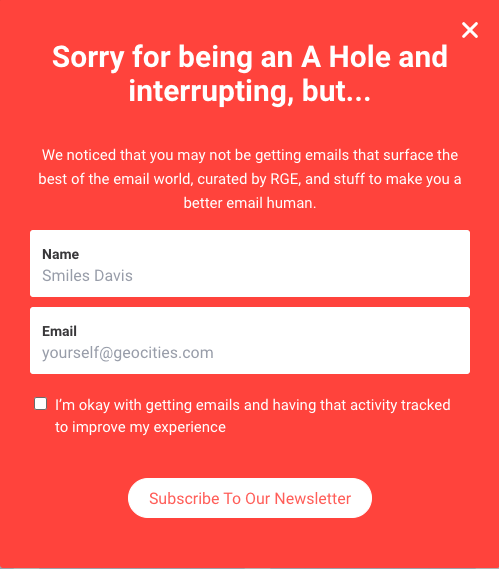
11. Start saving
Black Friday deals come and go every year, and almost everyone with an email gets bombarded by deals from different companies.
To help their customers make the most of these deals, Bluehost uses a simple “Start saving” CTA. This call to action works because it offers a clear benefit. Thanks to the button’s deep blue color on a lighter background, it’s also hard to miss.
12. Go pro yearly and save 45%
Many customers would rather pay $10 monthly instead of $100 per year, even though the yearly subscription cost less in the long run.
In this email CTA example, Bannersnack not only highlights that customers would be saving 45% if they move to a yearly subscription. But they also mention other benefits like “No more missed payment” and “no more worries”.
13. Start streaming
HBOmax is a video streaming platform . And it’s only right that they use a “Start streaming” CTA in their emails.
While the CTA is not super creative, they did make it stand out by using different colors for the CTA button and the background.
14. Get more time
ClickUp is a time and project management tool for big and small businesses.
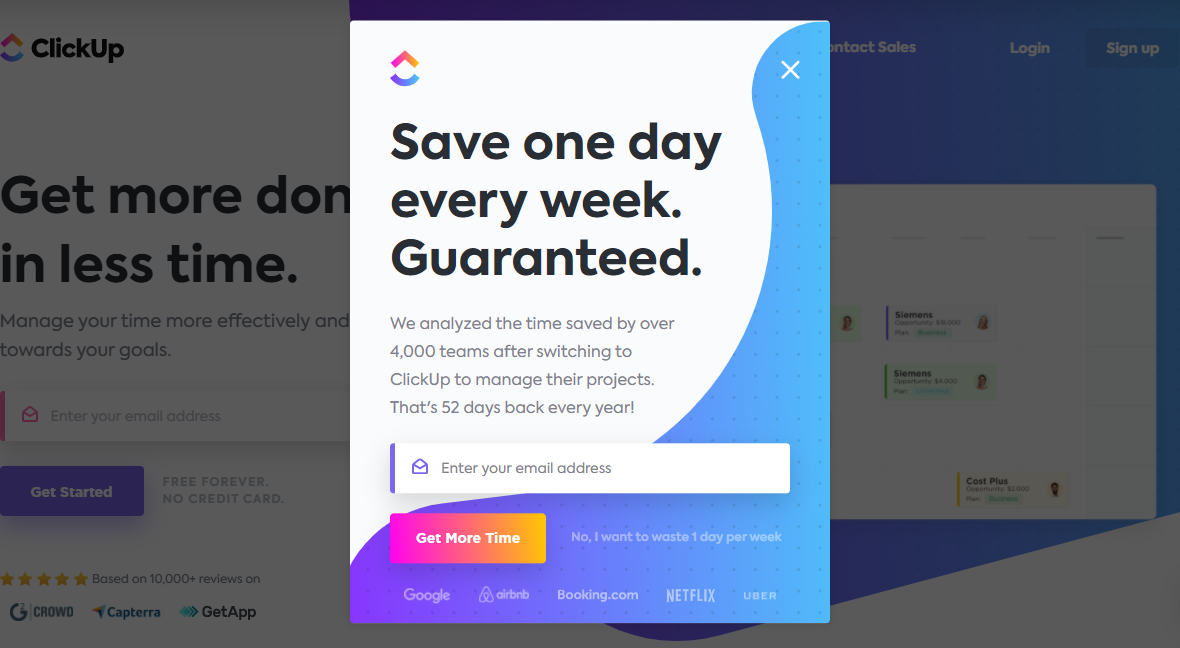
Their email pop-up box decided to ditch the traditional “join our newsletter” and use “Get more time” instead.
Why does this work? Anyone interested in gaining back more time would be interested in the “Get more time” CTA. Besides bringing their value upfront, ClickUp also uses social proof (by displaying company logos) and a cheeky “No, I want to waste one day per week” line beside their call to action.
15. Start creating
In this email, Vimeo announces its new features that allow users to create and showcase videos online.
Instead of focusing on themselves, Vimeo used a CTA that focuses on the reason why people use Vimeo in the first place: to create.
It’s time to get to work, now that you’ve seen CTA examples that can inspire you to create a call to action that converts more of your audience into leads and customers.
Before you write, keep in mind to know your audience well and the specific action you want them to take. Your CTAs should be above the fold, start with powerful words, create a sense of urgency, have some form of social proof, and tell people why they need to take action.
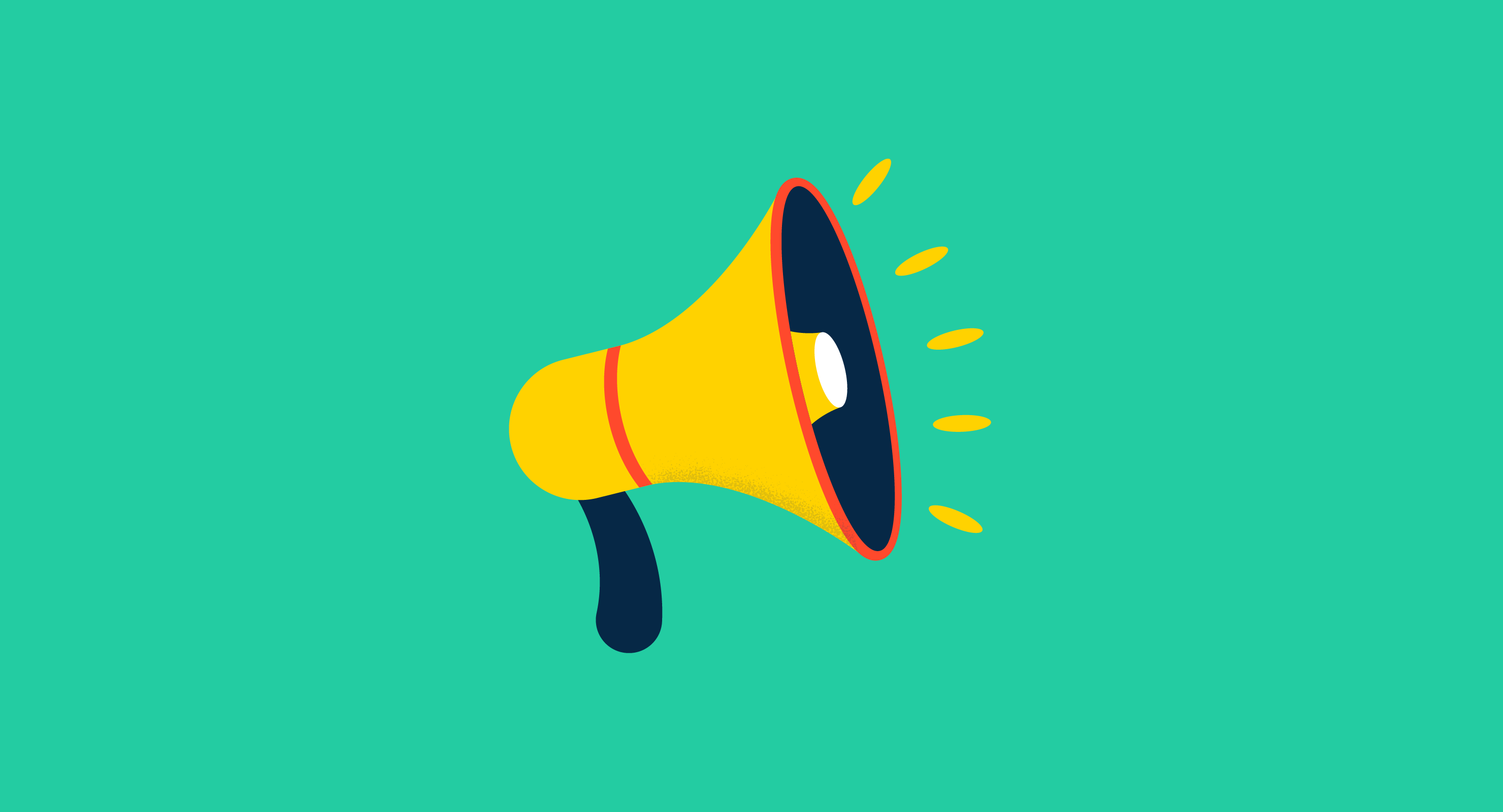
Use marketing software to help elevate your call to action game, acquire more leads, and close more sales.

Nathan is a B2B SaaS content writer . When he’s not helping software brands build more authority, generate better traffic, or convert more leads, you’ll find him binging on Marvel’s latest movies.
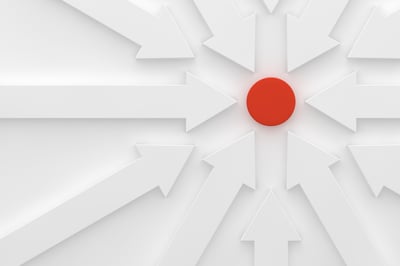
Contributor Network
Facebook retargeting isn't exactly new to the paid social advertising world.

Even if you create the best products in the world, your e-commerce store will fail if you...

Imagine a world where everyone who landed on your website bought your product.

Never miss a post.
Subscribe to keep your fingers on the tech pulse.
By submitting this form, you are agreeing to receive marketing communications from G2.

Want more articles like this?
Subscribe to G2 Tea and get the latest marketing news and trends delivered straight to your inbox.
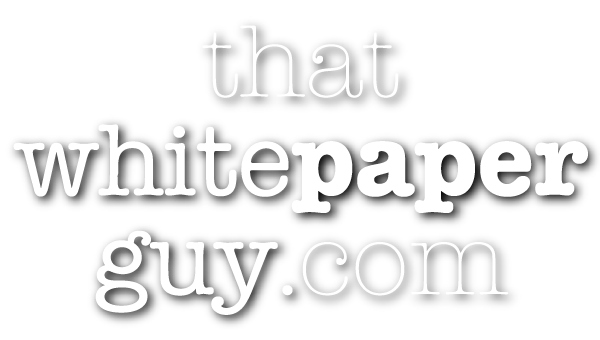
How to make an effective call to action in a white paper
Any white paper without an effective call to action is wasting a huge opportunity..
A call to action answers the question, “What do we want our ideal prospect to do after they finish reading our white paper?”

Knowing how to craft one can make a big difference in your results.
Here are 10 tips on how to write a more effective call to action in your next white paper.
Tip #1: Put it at the end
A call to action is not like a “Buy now” button that you can sprinkle all through an online sales letter.
You use it once, right at the end of your white paper. That means at the end of your concluding summary.
Tip #2: Keep it short, clear, and precise
A call to action doesn’t have to be long and involved. In fact, it can be conveyed in one sentence.
Here’s the simple formula I use to write a call to action: “To find out more about how your business can gain [key benefit explained in white paper] with [product or company name], [do something].”
The rest of these tips focus on the “do something” part of this formula.
Tip #3: Don’t be vague
In a call to action, you want to be as precise as possible.
Think of this like giving directions. Do you say, “Go down here a-ways and after that you’ll need to make a turn?” or do you say, “Keep going on Main Street for three blocks, and then turn right at the stoplight.”
As a rule, the more specific the call to action, the better… and the easier it is to measure the results.
So tell them something specific:
- Go to this landing page.
- View a short demo.
- Take an online survey.
- Request a free trial of our product.
Tip #4: Don’t send them to your home page
A phrase like, “For more information, visit AcmeSoftware.com” is not an effective call to action.
The only exception is a business with quite a simple value proposition and just a few pages on the web.
For example, I wrote a white paper for one client that uses proprietary software to cut corporate wireless costs. The value proposition was easy to see, and their website only had three pages.
For that white paper, I used this call to action:
“To find out how much your business can save on wireless, contact [company name] at [phone number] or visit [website] for a free analysis.”
Tip #5: Don’t ask for the order
Many salespeople think that a call to action means to ask for the order. After all, they’ve been taught, “Always be closing!”
Just like in this notorious speech by Alec Baldwin from the movie version of Glengarry Glenn Ross. (Click to watch, but beware of extreme profanity).
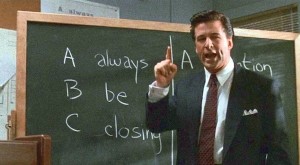
There’s nothing wrong with selling, at the right time and in the right place. But a white paper is not the time or place.
Instead of selling, a white paper works best if it helps, teaches, and explains.
There will be time for selling later, after your company has established more trust with the prospect.
Tip #6: Build your white paper into your sales cycle
Most B2B companies that use white papers have a more complex sales cycle than the one I mentioned above.
For best results, build your white paper into the company’s sales cycle.
How? Talk to the sales manager or product manager and explain the plans for the white paper.
Discuss where this paper fits into the sales cycle, and what makes sense for the next step.
This may take some hard thinking and negotiating. But without it, your call to action can never be as powerful.
Tip #7: Consider your purpose and audience
Your call to action should ideally match the purpose and intended audience for your white paper. This is where your white paper planning comes in.
Let’s say your purpose is to generate leads, and your target audience is COOs in mid-range enterprises with problems making good hires.
You probably can’t ask a busy executive to download a demo version of your HR software to test-drive it.
But you could ask them to take a 2-minute survey to see how their company’s hiring process compares to other firms in the same sector.
Be imaginative, and come up with an easy next step.
Tip #8: Deliver prospects to your website
Another good tactic is an ROI calculator, where a prospect can enter numbers into a widget and see how much they could save or profit with your solution.
A ROI calculator can be ideal for a CFO audience.
But keep it believable. Don’t just pull numbers out of thin air. Use real customer experiences or metrics to build your calculations.
Always be looking for ways to get an interested prospect to interact further with the company, most likely through its website.
Tip #9: Get the resources to create the next step
But wait a minute, that 2-minute survey doesn’t exist yet. Neither does that ROI calculator.
So you better get busy.
In other words, if there isn’t already a “next step” in your sales cycle, you need to create one.
And if you can’t do that all by yourself, you may need a researcher, a writer, and a Web developer… and the resources to engage them.
This suggestion goes beyond creating a call to action, but it will help generate much better results.
Tip #10: Think ahead to the NEXT call to action
At the end of the next step, always have another call to action to keep prospects engaged.
Perhaps this is a good time to ask them to watch a short video, or subscribe to your e-newsetter of monthly tips.
Your goal in each step is to engage each prospect more, collect a little more information from them, and draw them deeper into your sales funnel.
In other words, build a cascade of conversions, each drawing them closer and closer to the company.
Do you have any tips on making calls to action? Please leave your comment below.
Want to hear whenever there’s a fresh article on this site? Subscribe here to stay in the know on long-form content . From time to time, we’ll also send you word about some great new resource or training. And you can unsubscribe any time.

About Gordon Graham
Worked on 320+ white papers for clients from Silicon Valley to Switzerland, on everything from choosing enterprise software to designing virtual worlds for kids, for clients from tiny startups to 3M, Google, and Verizon. Wrote White Papers for Dummies which earned 60+ 5-star ratings on Amazon. Won 16 awards from the Society for Technical Communication. Named AWAI 2019 Copywriter of the Year.
If you liked this post...

You asked me: Is copywriting different from content writing?
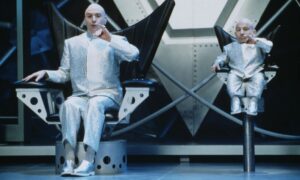
Quick tip: Use AI to make a Mini-Me
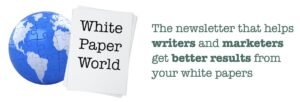
White Paper World 42: June 14, 2024
Leave a comment cancel reply.
This site is protected by reCAPTCHA and the Google Privacy Policy and Terms of Service apply.
Need a great white paper?
Imperial College London Imperial College London
Latest news.

Sleep evolution enigma and student becomes CEO for a day: News from Imperial

Climate insurance idea wins top prize in Business School competition

Fellowship to support venture capital experts in life science and deep tech
- Tools and reference
- Digital skills training
- Web skills materials
Writing calls to action

Using colour blocks as CTAs
You can highlight call to actions using link text in a colour block.
Find out how to add a colour block to your page.
The dictionary definition of a call to action is “ an exhortation or stimulus to do something in order to achieve an aim or deal with a problem ”.
When we talk about a call to action (CTA) online we are referring to a piece of content intended to prompt a user to perform a specific act, typically taking the form of an instruction or directive.
It is, quite literally, a "call" to take an "action."
The action you want people to take could be anything: download a document, sign up for a webinar, get a voucher, attend an event, etc.
A CTA can be placed in your marketing materials; on your website, in an email or in a blog post. They can also take different forms; as a button, as a link or in an advert.
Call to action do’s
- Do use verbs like; read, register, watch, download, join, donate, buy.
- Do keep CTA text short, concise, jargon-free and actionable . e.g. Read Imperial Magazine
- Do convey a sense of urgency – use language to convince users waiting to take action would result in missing an opportunity. e.g. CTA could read “REGISTER NOW” next to text “limited spaces available”.
- Do write CTAs in the first person i.e. “Start my free trial”.
- Do include extra information in or around the CTA to build trust – include numbers or information that show what the person will get e.g. CTA reads “Start my free trial” next to page text “ The best wireless headset is yours free for 60 days”
- Do ensure the CTA text tells the reader what happens next i.e. ‘Download Imperial Magazine, PDF’ actually links to and opens the magazine PDF.
- Do use bold, contrasting CTAs on your page that make an impact.
- Do place the CTA in a prominent position on the page or repeat it in long content, i.e at the top of the page or in the sidebar.
- Do create specific landing pages or surveys so that the CTA links through to defined content and not just a ‘contact us’ page.
- Do remember to track your CTAs and update ones that are not getting desired results.
Call to action don’ts
- Don’t use generic terms like ‘click here’ or 'read more' multiple times on a page - as these are not accessible .
- Don’t place the CTA at the bottom of the page
- Don’t go on too long, use concise text
- Don’t link to content unrelated to the CTA
- Don’t leave CTAs on your page that are out of date
You can see an example of a CTA button and colour block at the top of this page.
Try adding a call to action button, a document download button or a colour block to your College web page.
For more information on CTAs read 17 Best Practices for Crazy-Effective Call-To-Actions Buttons or 6 Proven Ways to Boost the Conversion Rates of Your Call-to-Action Buttons.
Get the Reddit app
Our mission is simple but profound: empowering each other to succeed academically, professionally, and personally. Here, you will find a treasure trove of insights, suggestions, and advice evolved through fellow college students, mentors, and instructors from special parts of the sector.
What Is a Call to Action in an Essay?
As a student honing the art of persuasive writing, understanding the concept of a call to action in a story is essential to getting the reader to act or think again. A call to action is a formal call or direction at the end of a story, encouraging the audience to take a particular course or think about a particular idea.
Essentially, the call to action is the culmination of the author’s persuasive efforts, prompting the reader to move beyond jargon and engage with the ideas presented strongly It can take a variety of forms, such as suggestions for further research, appeals for lifestyle change, or require individual reflection and action.
The well-crafted call to movement is compelling and actionable, encouraging the reader to reply logically to the thoughts explored in the article. Whether it’s selling advocacy, encouraging important self-reflection, or advocating for precise coverage adjustments, a call-to-action can grab a reader’s attention and inspire them to take precise motion to the desired final results.
Also, consider readers’ interests, values, and potential barriers to action and tailor calls to action to specific audiences and contexts Through calls to action and reader motivation and by matching their concerns, students can maximize its impact and effectiveness, ultimately achieving the desired motivational outcomes.
- Election 2024
- Entertainment
- Newsletters
- Photography
- Personal Finance
- AP Investigations
- AP Buyline Personal Finance
- AP Buyline Shopping
- Press Releases
- Israel-Hamas War
- Russia-Ukraine War
- Global elections
- Asia Pacific
- Latin America
- Middle East
- Election Results
- Delegate Tracker
- AP & Elections
- Auto Racing
- 2024 Paris Olympic Games
- Movie reviews
- Book reviews
- Financial Markets
- Business Highlights
- Financial wellness
- Artificial Intelligence
- Social Media
Orlando Cepeda dies
The Supreme Court overturned Roe v. Wade in 2022. Here’s the state of abortion rights now in the US
Judges, state lawmakers and voters are deciding the future of abortion in the U.S. two years after the Supreme Court jolted the legal status quo with a ruling that overturned Roe v. Wade
FILE - People march through downtown Amarillo to protest a lawsuit to ban the abortion drug mifepristone, Feb. 11, 2023, in Amarillo, Texas. Two years after the U.S. Supreme Court ended a nationwide right to abortion, travel and pills have become big parts of the issue.(AP Photo/Justin Rex, File)
- Copy Link copied
FILE - Paul Meacham holds high a sign that reads “Ohio is pro-life” as the crowd prays during the Ohio March for Life rally at the Ohio State House in Columbus, Ohio, Friday, Oct. 6, 2023. Two years after the U.S. Supreme Court ended a nationwide right to abortion, travel and pills have become big parts of the issue. (AP Photo/Carolyn Kaster, File)
Judges, state lawmakers and voters are deciding the future of abortion in the U.S. two years after the Supreme Court jolted the legal status quo with a ruling that overturned Roe v. Wade .
The June 24, 2022, ruling in Dobbs v. Jackson Women’s Health Organization sparked legislative action, protest and numerous lawsuits — placing the issue at the center of politics across the country.
Abortion is now banned at all stages of pregnancy, with limited exceptions, in 14 Republican-controlled states. In three other states, it’s barred after about the first six weeks, which is before many know they are pregnant. Most Democratic-led states have taken actions to protect abortion rights, and become sanctuaries for out-of-state patients seeking care.
That’s changed the landscape of abortion access, making it more of a logistical and financial ordeal for many in conservative states. But it has not reduced the overall number of procedures done each month across the U.S.
Here’s what to know about the state of abortion rights in the U.S. now.
Limited abortion access prompts more out-of-state travel
Bans in Republican-led states have prompted many people seeking abortions to travel to get care.
That translates into higher costs for gas or plane tickets, hotels and meals; more logistics to figure out, including child care; and more days off work.
A new study by the Guttmacher Institute, which advocates for abortion access, found that out of just over a million abortions provided in clinics, hospitals and doctors’ offices, more than 161,000 — or 16% — were for people who crossed state lines to get them.
More than two-thirds of abortions done in Kansas and New Mexico were for out-of-staters, particularly Texans.
Since Florida’s six-week abortion ban kicked in in May, many people had to travel farther than before, since throughout the Southeast, most states have bans.
Low-income patients and those lacking legal permission to be in the country are more likely to be unable to travel. There can be lasting costs for those who do.
In Alabama, the Yellowhammer Fund, which previously helped residents pay for the procedure has paused doing so since facing threats of litigation from the state .
Jenice Fountain, Yellowhammer’s executive director, said she met a woman recently who traveled from Alabama to neighboring Georgia for an abortion but found she couldn’t get one there because she was slightly too far into her pregnancy. So she then went to Virginia. The journey wiped out her rent money and she needed help to remain housed.
“We’re having people use every dime that they have to get out of state, or use every dime they have to have another child,” Fountain said.
It’s usually provided with pills rather than procedures
FILE - People march through downtown Amarillo to protest a lawsuit to ban the abortion drug mifepristone, Feb. 11, 2023, in Amarillo, Texas. (AP Photo/Justin Rex, File)
Nearly two-thirds of known abortions last year were provided with pills rather than procedures .
One report found that pills are prescribed via telehealth and mailed to about 6,000 people a month who live in states with abortion bans. They’re sent by medical providers in states with laws intended to protect them from prosecution for those prescriptions. The laws in Colorado, Massachusetts, New York, Vermont and Washington specifically protect medical providers who prescribe the pills to patients in states with bans.
The growing prominence of pills, which were used in about half of all abortions just before the Dobbs ruling, is a frontier in the latest chapter of the legal fight.
The U.S. Supreme Court this month unanimously rejected an effort by abortion opponents who were seeking to overturn or roll back the U.S. Food and Drug Administration’s approval of mifepristone, one of two drugs usually used together for medication abortions. The issue is likely to return .
Abortion is on the 2024 ballot
In this presidential election year, abortion is a key issue.
Protecting access has emerged as a key theme in the campaigns of Democrats, including President Joe Biden in his reelection bid . Former President Donald Trump , the presumptive Republican nominee, has said states should decide whether to restrict abortions. He also suggested states could limit contraception use but changed his tune on that.
“We recognize this could be the last Dobbs anniversary we celebrate,” Kelsey Pritchard, a spokesperson for Susan B. Anthony Pro-Life America said in an interview, noting that if Democrats win the presidency and regain control of both chambers of Congress, a right to abortion could be enshrined in the law.
The issue will also be put directly before voters in at least four states. Colorado, Florida, Maryland and South Dakota have ballot measures this year asking voters to approve state constitutional amendments that would protect or expand access to abortion. A New York measure would bar discrimination against someone who has an abortion. There are attempts to put questions about abortion access on the ballots this year in Arkansas, Missouri, Montana, Nebraska and Nevada.
There’s also a push for a ballot measure in Arizona, where the state Supreme Court this year ruled that an 1864 abortion ban could be enforced. With the help of some Republicans — Democrats in the Legislature were able to repeal that law .
Generally, abortion rights expand when voters are deciding. In the seven statewide abortion policy-related votes since 2022, voters have sided with abortion rights advocates in every case.
It’s still up to the courts — including the Supreme Court
FILE - Paul Meacham holds high a sign that reads “Ohio is pro-life” as the crowd prays during the Ohio March for Life rally at the Ohio State House in Columbus, Ohio, Friday, Oct. 6, 2023. (AP Photo/Carolyn Kaster, File)
The Dobbs ruling and its aftermath gave rise to a bevy of legal questions and lawsuits challenging nearly every ban and restriction.
Many of those questions deal with how exceptions — which come into play far more often when abortion is barred earlier in pregnancy — should apply. The issue is often raised by those who wanted to be pregnant but who experienced life-threatening complications.
A group of women who had serious pregnancy complications but were denied abortions in Texas sued, claiming the state’s ban is vague about which exceptions are allowed. The all-Republican Texas Supreme Court disagreed in a May ruling.
The Supreme Court also heard arguments in April on the federal government’s lawsuit against Idaho, which says its ban on abortions at all stages of pregnancy can extend to women in medical emergencies. The Biden administration says that violates federal law. A ruling on that case could be issued at any time.
Meanwhile, bans have been put on hold by judges in Iowa, Montana, Utah and Wyoming.
- Share full article
Advertisement
Supported by
Guest Essay
Surgeon General: Why I’m Calling for a Warning Label on Social Media Platforms

By Vivek H. Murthy
Dr. Murthy is the surgeon general.
One of the most important lessons I learned in medical school was that in an emergency, you don’t have the luxury to wait for perfect information. You assess the available facts, you use your best judgment, and you act quickly.
The mental health crisis among young people is an emergency — and social media has emerged as an important contributor. Adolescents who spend more than three hours a day on social media face double the risk of anxiety and depression symptoms, and the average daily use in this age group, as of the summer of 2023, was 4.8 hours . Additionally, nearly half of adolescents say social media makes them feel worse about their bodies.
It is time to require a surgeon general’s warning label on social media platforms, stating that social media is associated with significant mental health harms for adolescents. A surgeon general’s warning label, which requires congressional action, would regularly remind parents and adolescents that social media has not been proved safe. Evidence from tobacco studies show that warning labels can increase awareness and change behavior. When asked if a warning from the surgeon general would prompt them to limit or monitor their children’s social media use, 76 percent of people in one recent survey of Latino parents said yes.
To be clear, a warning label would not, on its own, make social media safe for young people. The advisory I issued a year ago about social media and young people’s mental health included specific recommendations for policymakers, platforms and the public to make social media safer for kids. Such measures, which already have strong bipartisan support, remain the priority.
Legislation from Congress should shield young people from online harassment, abuse and exploitation and from exposure to extreme violence and sexual content that too often appears in algorithm-driven feeds. The measures should prevent platforms from collecting sensitive data from children and should restrict the use of features like push notifications, autoplay and infinite scroll, which prey on developing brains and contribute to excessive use.
Additionally, companies must be required to share all of their data on health effects with independent scientists and the public — currently they do not — and allow independent safety audits. While the platforms claim they are making their products safer, Americans need more than words. We need proof.
We are having trouble retrieving the article content.
Please enable JavaScript in your browser settings.
Thank you for your patience while we verify access. If you are in Reader mode please exit and log into your Times account, or subscribe for all of The Times.
Thank you for your patience while we verify access.
Already a subscriber? Log in .
Want all of The Times? Subscribe .

IMAGES
VIDEO
COMMENTS
Key takeaways. In marketing, a call to action, or CTA, is a written statement that invites consumers to perform a company's desired action. Calls to action can direct traffic to a business' website, encourage new customers to interact with a company and increase profits for an organization. Writing an effective call to action involves ...
A CTA in writing is a clear and direct message that should elicit a strong response from readers to do something. In marketing lingo, this something is called a "conversion" - turning observers into doers. Think of it as a "hook, line, and sinker" moment - you want to inspire the reader to do what you want them to do.
5. Emma builds intrigue by keeping it concise. Often, the best call-to-action examples are those that are concise. This is an especially powerful technique when writing CTAs designed to promote downloadable content such as guides, ebooks, and checklists, as it can double as an intrigue-builder.
A call to action is a word or phrase that prompts action. It is a marketing term to describe urging your audience to act in a certain way. A call to action can appear as a clickable button or simply as a piece of text. Call-to-action buttons and phrases can appear at any place in the user journey that you want to direct your audience.
Demonstrate exactly what your CTA will deliver and how. . 3. Create a sense of urgency. Include phrases like "limited time offer" and "for today only" to motivate users to act. Pair these with action-oriented words like "subscribe" and "download" to encourage a particular action. . 4. Consider your target audience.
The call to action which comes right before the end of a persuasive speech is where you clearly tell the audience a role they can play after they leave your talk. The CTA gives audience members concrete tasks to tackle, and these tasks are ones that must be completed in order to bring your ideas to fruition. And, it's a key part of what makes ...
Use Power Words and Emotional Triggers. Another crucial component of call-to-action writing is power words. These are words that appeal to emotions and trigger the desire to click. While action verbs tell readers what to do and what will happen after clicking a link, power words subtly nudge people to the desired page.
Call to action examples Review these sample calls to action to help you revise your own and better reach your target audience: Example 1: Call to action: Purchase our ebook Revised call to action: Check out why marketers are reading this best-seller to expand their marketing efforts. Example 2: Call to action: Use eco-friendly straws Revised call to action: When you drink using plastic straws ...
A call to action is a persuasive statement that encourages the reader to take action. It is the final part of your essay, where you tell the reader what they should do next. This statement should ...
A clickable call to action button is simple to use. It clearly stands out on the page, and the reader knows exactly what to do. Keep it to less than five words. Otherwise, it just looks crowded and messy on the button. Use a contrasting color to grab attention. And avoid using "Click Here" for a CTA button.
A call to action is a prompt or message, usually formatted as a button or link, that encourages the audience to take a specific action. CTAs are commonly used in marketing and sales contexts to guide users toward the next step in their journey, whether that's purchasing a product, signing up for a newsletter, or forwarding that chain email to ...
51 call-to-action examples Here are 51 call-to-action examples: CTA for marketing Marketing campaigns use calls to action for attracting new customers or encouraging people to buy a new product. Here are some examples: Download our app for free: This call to action is succinct because it clearly advertises what people should try, the company's app, and the incentive for doing so, it's free, so ...
How to Write a Call to Action. 1. Keep Context in Mind. First and foremost, keep in mind that the length and style of a call to action will depend on its context. A call to action within a blog post, for example, will tend to be a sentence or two that follows naturally from the rest of the piece.
How to Write an Effective Call to Action. Written by MasterClass. Last updated: Jul 29, 2021 • 3 min read. A call to action, or CTA, is a digital marketing tool that companies use for an array of reasons, including building their customer base, capturing a sale, and turning web visitors into paying customers. A call to action, or CTA, is a ...
Call to Action. Now, this part is crucial. Your conclusion is where you can inspire action in your reader. Whether it's urging them to think differently, take action, or explore further, your conclusion is your chance to make a lasting impact. You want your reader to finish your essay feeling motivated and ready to tackle the world.
Put It All Together: How To Write A Call To Action With A Compelling Structure. No matter what motivation you use (fear or hope), there are some common ways that you should use when structuring your call to action. 1. Start with verbs. Verbs are the action words that make it clear to readers what you want them to do.
Call To Action is a great way to close an essay. This video explains how to write it and shares some examples along with tips to help you as you practice it ...
Surround the call-to-action with a description of how their lives will be improved when they act. Paint a prosperous vision. 5. Customize your call-to-action for each person. Audiences don't act; individuals act. Rather than addressing the group as a whole, focus your call-to-action on each individual in your audience.
7. Avocado Green Mattress. Avocado Green Mattress has upcycled bedroom furniture people can buy to complement their organic mattresses. The call to action is "Shop Zero Waste" is a clear call to the type of buyer who is willing to pay a premium to minimize their impact on the environment.
This call to action works because it offers a clear benefit. Thanks to the button's deep blue color on a lighter background, it's also hard to miss. 12. Go pro yearly and save 45%. Many customers would rather pay $10 monthly instead of $100 per year, even though the yearly subscription cost less in the long run.
Tip #7: Consider your purpose and audience. Your call to action should ideally match the purpose and intended audience for your white paper. This is where your white paper planning comes in. Let's say your purpose is to generate leads, and your target audience is COOs in mid-range enterprises with problems making good hires.
The dictionary definition of a call to action is " an exhortation or stimulus to do something in order to achieve an aim or deal with a problem ". When we talk about a call to action (CTA) online we are referring to a piece of content intended to prompt a user to perform a specific act, typically taking the form of an instruction or directive.
Essentially, the call to action is the culmination of the author's persuasive efforts, prompting the reader to move beyond jargon and engage with the ideas presented strongly It can take a variety of forms, such as suggestions for further research, appeals for lifestyle change, or require individual reflection and action.
The June 24, 2022, ruling in Dobbs v. Jackson Women's Health Organization sparked legislative action, protest and numerous lawsuits — placing the issue at the center of politics across the country. Abortion is now banned at all stages of pregnancy, with limited exceptions, in 14 Republican-controlled states.
Dr. Murthy is the surgeon general. One of the most important lessons I learned in medical school was that in an emergency, you don't have the luxury to wait for perfect information. You assess ...